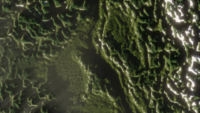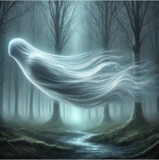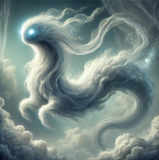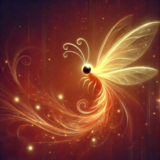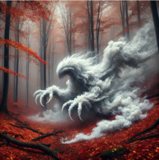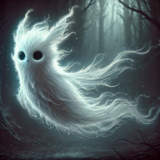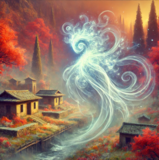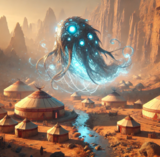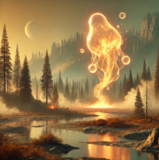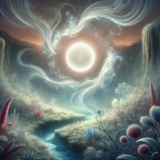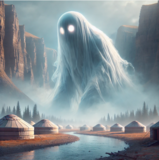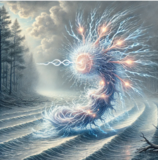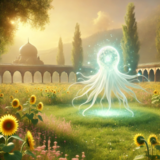Strait of Haifa: Difference between revisions
NewZimiaGov (talk | contribs) |
NewZimiaGov (talk | contribs) No edit summary |
||
| (101 intermediate revisions by 2 users not shown) | |||
| Line 32: | Line 32: | ||
Countries which have claimed territory bordering the Sea of Storms include: the [[Haifo-Pallisican Imperial Trade Union]], [[Alperkin]] and [[Natopia]], and most recently, the [[Imperial Federation]]. | Countries which have claimed territory bordering the Sea of Storms include: the [[Haifo-Pallisican Imperial Trade Union]], [[Alperkin]] and [[Natopia]], and most recently, the [[Imperial Federation]]. | ||
: ''See also: [[History of the Strait of Haifa]]'' | |||
==Geology== | ==Geology== | ||
[[File:StraitGreen.png|200px|thumb|left|An aerial photograph of the Lake Morovia and the central Strait of Haifa.]] | [[File:StraitGreen.png|200px|thumb|left|An aerial photograph of the Lake Morovia and the central Strait of Haifa.]] | ||
| Line 56: | Line 56: | ||
Lake Morovia and surrounding regions are home to a range of highly unique and diverse range of plants and animals found nowhere else on Micras. Examples of the region's unique species can be seen in the tables below. | Lake Morovia and surrounding regions are home to a range of highly unique and diverse range of plants and animals found nowhere else on Micras. Examples of the region's unique species can be seen in the tables below. | ||
====Aquatic Fauna==== | ====Aquatic Fauna==== | ||
{| class="wikitable sortable collapsible" border="1" style="width: | {| class="wikitable sortable collapsible" border="1" style="width:1100px; font-size:100%;" | ||
|- | |- | ||
! scope="col" | Picture | ! scope="col" | Picture | ||
| Line 66: | Line 66: | ||
|- | |- | ||
|- | |- | ||
| [[Image: | | [[Image:SwampNettle.png|160x160px]] || [[Atterian Sea Nettle]] || 1.2 meters (3 feet 11 inches) || 15 kilograms (33 pounds) || Coastal waters of Vaeringheim, Symphonara, and Delphica. || The Atterian Sea Nettle is a captivating and graceful jellyfish known for its stunning, bioluminescent appearance. Residing in the depths of Lake Morovia, it possesses unique characteristics that set it apart from the region's other jellyfish. | ||
Atterian Sea Nettles are predominantly found in the deep, dark waters of Lake Morovia, where their gentle pulsating movements and glowing tentacles create a mesmerizing spectacle. They are rarely seen in shallower waters, preferring the mysterious depths. | Atterian Sea Nettles are predominantly found in the deep, dark waters of Lake Morovia, where their gentle pulsating movements and glowing tentacles create a mesmerizing spectacle. They are rarely seen in shallower waters, preferring the mysterious depths. | ||
| Line 74: | Line 74: | ||
In the rare instances when Atterian Sea Nettles encounter threats, they can release a cloud of toxic mucus as a defense mechanism. This mucus not only deters potential predators but also creates a temporary smokescreen to escape from danger. | In the rare instances when Atterian Sea Nettles encounter threats, they can release a cloud of toxic mucus as a defense mechanism. This mucus not only deters potential predators but also creates a temporary smokescreen to escape from danger. | ||
|- | |- | ||
| [[Image: | | [[Image:SwampSquid.png|160x160px]] || Ocian Swamp Squid || 0.6 meters (2 feet) || 7 kilograms (15.4 pounds) || Marshy coastal waters of Somniumpolis, Saluria, and the surrounding wetlands. || The Ocian Swamp Squid is a mysterious and elusive squid that inhabits the dark, murky waters of swamps and wetlands of Lake Morovia. This unusual creature is known for its unassuming appearance, and its fascinating abilities. | ||
Ocian Swamp Squid are primarily found in the shadowy depths of swampy environments of Lake Morovia. They are known to thrive in stagnant and brackish waters, using the concealment of the murky, sediment-filled surroundings to their advantage. | Ocian Swamp Squid are primarily found in the shadowy depths of swampy environments of Lake Morovia. They are known to thrive in stagnant and brackish waters, using the concealment of the murky, sediment-filled surroundings to their advantage. | ||
| Line 82: | Line 82: | ||
Ocian Swamp Squid are Known for their complex and strange courtship rituals, which often involve intricate color displays and synchronized movements. Breeding occurs in the deeper parts of their swamp habitats, and the newly hatched larvae go through several stages of development before reaching maturity. | Ocian Swamp Squid are Known for their complex and strange courtship rituals, which often involve intricate color displays and synchronized movements. Breeding occurs in the deeper parts of their swamp habitats, and the newly hatched larvae go through several stages of development before reaching maturity. | ||
|- | |- | ||
| [[Image: | | [[Image:Morovianshrimp.png|160x160px]] || Odiferan Marsh Shrimp || 0.3 meters (1 foot) || 2 kilograms (4.4 pounds) || Swamps and marshes near Myrene and Symphonara. || The Odiferan Marsh Shrimp is a unique and mysterious shrimp found in the Odiferan Marsh. This small, elusive creature boasts a captivating array of features and abilities that distinguish it from the region's other shrimp. | ||
Odiferan Marsh Shrimp thrive in the murky and nutrient-rich waters of the Odiferan Marsh, a region filled with dense vegetation and unique flora. They are often found in shallow, slow-moving streams and pools within the marsh. | Odiferan Marsh Shrimp thrive in the murky and nutrient-rich waters of the Odiferan Marsh, a region filled with dense vegetation and unique flora. They are often found in shallow, slow-moving streams and pools within the marsh. | ||
| Line 90: | Line 90: | ||
During the breeding season, male Odiferan Marsh Shrimp engage in intricate dance-like courtship displays, showcasing their bioluminescent lures to attract potential mates. Once courtship is successful, females lay their eggs among the aquatic plants in the marsh. | During the breeding season, male Odiferan Marsh Shrimp engage in intricate dance-like courtship displays, showcasing their bioluminescent lures to attract potential mates. Once courtship is successful, females lay their eggs among the aquatic plants in the marsh. | ||
|- | |- | ||
| [[Image: | | [[Image:HatchsRay.png|160x160px]] || Hatch's Ray || 2.5 meters (8 feet 2 inches) || 200 kilograms (440 pounds) ||Coastal marshes and swamps around Pyralis, Saluria, and Somniumpolis. || Hatch's Ray is an extraordinary and unusual creature known for its unique adaptation to swampy environments, which has evolved to thrive in the murky waters of swamps and marshes of Lake Morovia. | ||
Hatch's Rays are predominantly found in the heart of swampy regions, where dense vegetation and shallow, brackish waters provide the ideal habitat for these extraordinary creatures. They are most commonly sighted in slow-moving streams, sloughs, and muddy ponds. | Hatch's Rays are predominantly found in the heart of swampy regions, where dense vegetation and shallow, brackish waters provide the ideal habitat for these extraordinary creatures. They are most commonly sighted in slow-moving streams, sloughs, and muddy ponds. | ||
| Line 100: | Line 100: | ||
Mating rituals among Hatch's Rays involve elegant and synchronized swimming displays, where potential mates perform a mesmerizing dance that often culminates in courtship and, eventually, egg-laying among the reeds and aquatic plants of the swamp. | Mating rituals among Hatch's Rays involve elegant and synchronized swimming displays, where potential mates perform a mesmerizing dance that often culminates in courtship and, eventually, egg-laying among the reeds and aquatic plants of the swamp. | ||
|- | |- | ||
| [[Image: | | [[Image:SwampShark.png|160x160px]] || Atteran River Shark || 2.5 meters (8 feet 2 inches) || 350 kilograms (771 pounds) || Waters of the Strait of Haifa, near Aegirheim, Skýrophos, and Norsolyra. || The Atteran River Shark is a formidable, large shark, aptly named for its imposing presence and its preference for the turbulent waters of the Strait of Haifa. This apex predator is a master of its domain. | ||
Atteran River Sharks are primarily found in the fast-flowing and murky waters of the Strait of Haifa, especially in the waters surrounding the Abeisan Archipelago. They are often sighted in the deeper, churning sections of the region's waterways. | Atteran River Sharks are primarily found in the fast-flowing and murky waters of the Strait of Haifa, especially in the waters surrounding the Abeisan Archipelago. They are often sighted in the deeper, churning sections of the region's waterways. | ||
| Line 109: | Line 109: | ||
|- | |- | ||
| [[Image: | | [[Image:ArmoredDolphin.png|160x160px]] || Haifan Armored Lake Dolphin || 1.8 meters (5 feet 11 inches) || 120 kilograms (264.5 pounds) ||Shallow waters of Lake Morovia, particularly near Vaeringheim, Luminaria, and Delphica. || The Haifan Armored Lake Dolphin is a remarkable and unique creature, which resides in the murky waters of the Haifan region, it is known for its elegant beauty and formidable defensive capabilities. | ||
Haifan Armored Lake Dolphins are most commonly found in the calm shallow waters of Lake Morovia. These tranquil environments provide the perfect sanctuary for these graceful creatures, where they can flourish and thrive. | Haifan Armored Lake Dolphins are most commonly found in the calm shallow waters of Lake Morovia. These tranquil environments provide the perfect sanctuary for these graceful creatures, where they can flourish and thrive. | ||
| Line 119: | Line 119: | ||
During the breeding season, Haifan Armored Lake Dolphins engage in mesmerizing underwater displays, showcasing their agility and grace. Mating pairs often engage in synchronized swimming. | During the breeding season, Haifan Armored Lake Dolphins engage in mesmerizing underwater displays, showcasing their agility and grace. Mating pairs often engage in synchronized swimming. | ||
|- | |- | ||
| [[Image: | | [[Image:ArmoredWhale.png|160x160px]] || Vaering's Armored Whale || 6 meters (19 feet 8 inches) || 1,200 kilograms (2,646 pounds) || Open waters of Lake Morovia, with frequent sightings between Symphonara and Vaeringheim.|| Vaering's Armored Whale is an awe-inspiring, massive whale, celebrated for its majestic presence and known for its formidable strength and unwavering endurance, this colossal creature roams the vast waters of Lake Morovia and the central Strait of Haifa. | ||
Vaering's Armored Whales are most commonly found in the open oceans of Lake Morovia, where they navigate the depths and expanse of the lake with ease. They often undertake long migrations across the lake, following elusive currents. | Vaering's Armored Whales are most commonly found in the open oceans of Lake Morovia, where they navigate the depths and expanse of the lake with ease. They often undertake long migrations across the lake, following elusive currents. | ||
| Line 129: | Line 129: | ||
During the breeding season, Vaering's Armored Whales engage in elaborate courtship displays, which involve synchronized swimming, breathtaking breaches, and intricate sonic rituals. After mating, the female typically gives birth to a single calf, which she cares for and protects diligently. | During the breeding season, Vaering's Armored Whales engage in elaborate courtship displays, which involve synchronized swimming, breathtaking breaches, and intricate sonic rituals. After mating, the female typically gives birth to a single calf, which she cares for and protects diligently. | ||
|- | |- | ||
| [[Image: | | [[Image:Landocto.png|160x160px]] || Orange Forest Land Octopus || 1 meter (3 feet 3 inches) || 10 kilograms (22 pounds) || Coastal forests and swamp regions of Norsolyra and surrounding areas. || The Orange Forest Land Octopus is an extraordinary and enigmatic terrestrial octopus, which inhabits the Gloom Forest of Perpetual Autumn, this creature has evolved to thrive in the eerie and mystical environment of the forest, where it feeds on the parasitic will-o-wisps that illuminate the dark woods. | ||
The Orange Forest Land Octopus calls the mysterious Gloom Forest its home, a place shrouded in legends and mystery. This haunted forest is known for its luminous will-o-wisps, which serve as both the primary food source and an integral part of the Octopus's ecosystem. | The Orange Forest Land Octopus calls the mysterious Gloom Forest its home, a place shrouded in legends and mystery. This haunted forest is known for its luminous will-o-wisps, which serve as both the primary food source and an integral part of the Octopus's ecosystem. | ||
| Line 137: | Line 137: | ||
The Orange Forest Land Octopus is seldom observed by humans, as it is a master of remaining hidden within the mystical forest. Its presence in the Orange Forest has contributed to the numerous legends and tales that surround this eerie woodland. | The Orange Forest Land Octopus is seldom observed by humans, as it is a master of remaining hidden within the mystical forest. Its presence in the Orange Forest has contributed to the numerous legends and tales that surround this eerie woodland. | ||
|- | |- | ||
| [[Image: | | [[Image:AbeisanWalrus.png|160x160px]] || Abeisan Walrus || 2.5 meters (8 feet 2 inches) || 1,000 kilograms (2,204 pounds) || Coastal marshes around the Abeisan Archipelago, extending to Somniumpolis. || The Abeisan Walrus is a remarkable and resilient creature, celebrated for its commanding presence and unique adaptation to the swampy coastal regions of the Abeisan Archipelago. | ||
Abeisan Walruses are primarily found in the Abeisan Archipelago, where they inhabit the brackish waters, coastal marshes, and frigid beaches. They are known to rest on ice floes during colder months and venture into the coastal swamps when the weather is warmer. | Abeisan Walruses are primarily found in the Abeisan Archipelago, where they inhabit the brackish waters, coastal marshes, and frigid beaches. They are known to rest on ice floes during colder months and venture into the coastal swamps when the weather is warmer. | ||
| Line 147: | Line 147: | ||
During breeding season, male Abeisan Walruses engage in powerful, tusk-clashing displays to establish dominance and attract potential mates. Females typically give birth to a single calf, which they protect and nurture in the safety of their swampy coastal habitats. | During breeding season, male Abeisan Walruses engage in powerful, tusk-clashing displays to establish dominance and attract potential mates. Females typically give birth to a single calf, which they protect and nurture in the safety of their swampy coastal habitats. | ||
|- | |- | ||
| [[Image: | | [[Image:Tortoise.png|160x160px]] || Greater Morovian Giant Turtle || 2.2 meters (7 feet 2 inches) || 1,125 kilograms (2,480 pounds) || Coastal waters and hidden bays around Delphica and Luminaria. || The Greater Morovian Giant Turtle is a majestic and venerable beast, renowned for its colossal size and serene presence. Inhabiting the waters of the Morovian region, this ancient creature is a symbol of wisdom and endurance. | ||
Greater Morovian Giant Turtles are most commonly found in the brackish coastal waters of Lake Morovia. They prefer secluded coves and peaceful bays, where they find refuge and sustenance. | Greater Morovian Giant Turtles are most commonly found in the brackish coastal waters of Lake Morovia. They prefer secluded coves and peaceful bays, where they find refuge and sustenance. | ||
| Line 157: | Line 157: | ||
During the breeding season, male Greater Morovian Giant Turtles engage in elaborate courtship rituals, involving synchronized swimming and the generation of seismic vibrations to attract potential mates. Once a pair is established, the female lays her eggs on the sandy shores of the Morovian coastline. | During the breeding season, male Greater Morovian Giant Turtles engage in elaborate courtship rituals, involving synchronized swimming and the generation of seismic vibrations to attract potential mates. Once a pair is established, the female lays her eggs on the sandy shores of the Morovian coastline. | ||
|- | |- | ||
| [[Image: | | [[Image:Jkt6qxp5.png|160x160px]] || Tar Worm || 2 meters (6 feet 7 inches) || 200 kilograms (440 pounds) ||Tar-pits and geothermal regions surrounding Erythros and its neighboring settlements. || The Tar Worm is a formidable and highly unusual creature, known for its tenacious existence in the treacherous tar-pits of its native region. This creature, has evolved to thrive in the hazardous and unforgiving environment of the tar-pits of the Gloom Forest of Perpetual Autumn. | ||
Tar Worms are primarily found in the vast, gloomy tar-pits of their native region, where they navigate the viscous, oil-like substance with surprising ease. They can also be encountered in the surrounding areas, which often feature geothermal activity. | Tar Worms are primarily found in the vast, gloomy tar-pits of their native region, where they navigate the viscous, oil-like substance with surprising ease. They can also be encountered in the surrounding areas, which often feature geothermal activity. | ||
| Line 167: | Line 167: | ||
The Tar Worms' adaptation to the harsh tar-pits has made them an central part of local folklore and legend, often symbolizing resilience and determination in the face of adversity. | The Tar Worms' adaptation to the harsh tar-pits has made them an central part of local folklore and legend, often symbolizing resilience and determination in the face of adversity. | ||
|- | |- | ||
| [[Image: | | [[Image:Crocodile.png|160x160px]] || Rift Valley Crocodile || 4 meters (13 feet) || 500 kilograms (1,102 pounds) || Swamps and river valleys around Lake Morovia and the central Strait of Haifa. ||The Rift Valley Crocodile is a formidable creature, known for its powerful presence in the vast waters of the Haifan Rift Valley. This ancient creature, is known for its resilience and survival instincts in its unique habitat. | ||
Rift Valley Crocodiles primarily inhabit the expansive Haifan Rift Valley, where they make their homes in the numerous lakes and rivers found within this geographic wonder. They are frequently encountered along the muddy banks and calm, freshwater bodies of the central Strait of Haifa and its tributaries. | Rift Valley Crocodiles primarily inhabit the expansive Haifan Rift Valley, where they make their homes in the numerous lakes and rivers found within this geographic wonder. They are frequently encountered along the muddy banks and calm, freshwater bodies of the central Strait of Haifa and its tributaries. | ||
| Line 177: | Line 177: | ||
The large presence of Rift Valley Crocodiles in the Strait has led to their inclusion in local mythology and tales, symbolizing both the danger and the enduring beauty of the region. | The large presence of Rift Valley Crocodiles in the Strait has led to their inclusion in local mythology and tales, symbolizing both the danger and the enduring beauty of the region. | ||
|- | |- | ||
| [[Image: | | [[Image:Pufferfish.png|160x160px]] || Atterian Armored Pufferfish || 0.5 meters (1 foot 7 inches) || 5 kilograms (11 pounds) || Coastal reefs and sandy seabeds around Lake Morovia and the northern Strait of Haifa.||The Atterian Armored Pufferfish is a unique and extraordinary fish which inhabits the coastal waters of Lake Morovia. This resilient creature is known for its intricate armored plating and its formidable defenses. | ||
Atterian Armored Pufferfish are most commonly found among Lake Morovia's coral reefs and shallow, sandy seabeds where they can find both protection and sustenance. | Atterian Armored Pufferfish are most commonly found among Lake Morovia's coral reefs and shallow, sandy seabeds where they can find both protection and sustenance. | ||
| Line 187: | Line 187: | ||
Mating rituals among Atterian Armored Pufferfish involve intricate displays of coordinated swimming and water manipulation. Once a mating pair is established, the female will lay her eggs in a secluded crevice within the reef, and both parents will diligently guard the nest. | Mating rituals among Atterian Armored Pufferfish involve intricate displays of coordinated swimming and water manipulation. Once a mating pair is established, the female will lay her eggs in a secluded crevice within the reef, and both parents will diligently guard the nest. | ||
|- | |- | ||
| [[Image: | | [[Image:AminaCrab.png|160x160px]] || Amina Crab || .85 meters (2 foot 9 inches || 30 kilograms (66 pounds) || Rocky coastlines and clear, temperate waters around Lake Morovia, especially near Symphonara and Myrene. | ||
|| The Amina Crab is a massive and formidable crab which inhabits the coastal waters of the Lake Morovia. | |||
Amina Crabs are most commonly found along the rocky coastlines and in the clear, temperate waters of Lake Morovia. They favor areas with abundant underwater caves and crevices, where they seek shelter and protection. | Amina Crabs are most commonly found along the rocky coastlines and in the clear, temperate waters of Lake Morovia. They favor areas with abundant underwater caves and crevices, where they seek shelter and protection. | ||
| Line 197: | Line 199: | ||
During the breeding season, male Amina Crabs engage in elaborate displays of strength and agility to impress potential mates. After mating, the female lays her eggs in a secluded underwater crevice, where she guards them diligently. | During the breeding season, male Amina Crabs engage in elaborate displays of strength and agility to impress potential mates. After mating, the female lays her eggs in a secluded underwater crevice, where she guards them diligently. | ||
|- | |- | ||
| [[Image: | | [[Image:Swamproach2.png|160x160px]] || Low Valley Swamp Roach || 0.6 meters (2 feet) || 20 kilograms (44 pounds) ||Swamps and marshes around the lower valleys near the Morovian Lake region. || The Low Valley Swamp Roach is a formidable trilobite, known for its distinctive appearance and predatory nature, which inhabits the murky waters of the Morovian swamps. | ||
Low Valley Swamp Roaches are primarily found in the dark, swampy waters of the Lake Morovia region. They make their homes in the muck and sediment, where they prowl for prey among the aquatic plants and detritus. | Low Valley Swamp Roaches are primarily found in the dark, swampy waters of the Lake Morovia region. They make their homes in the muck and sediment, where they prowl for prey among the aquatic plants and detritus. | ||
| Line 207: | Line 209: | ||
Mating rituals among Low Valley Swamp Roaches involve intricate displays of underwater acrobatics, with males competing to impress potential mates. After mating, the female lays her eggs among the submerged vegetation, and both parents diligently guard the nest. | Mating rituals among Low Valley Swamp Roaches involve intricate displays of underwater acrobatics, with males competing to impress potential mates. After mating, the female lays her eggs among the submerged vegetation, and both parents diligently guard the nest. | ||
|- | |- | ||
| [[Image: | | [[Image:Koi.png|160x160px]] || Fái's Koi || 1.5 meters (4 feet 11 inches) || 25 kilograms (55 pounds) || Sacred lakes and ponds near Erythros and throughout the Gloom Forest. || Fái's Koi is a mystical and revered fish, which embodies the ancient tales of the skies and seas. This extraordinary creature appears as a majestic, ancient koi fish adorned with shimmering scales that catch the light like stardust. Fái's Koi possesses a unique ability to traverse both the depths of the region's waterways and the vast expanse of the heavens. | ||
Fái's Koi is said to dwell in the waters surrounding [[List of cities in Bassaridia Vaeringheim#Erythros|Erythros]], where the boundaries between the earthly and the ethereal blur. Legends speak of its presence in tranquil lakes and sacred ponds, where it rises to the surface to bask in the light of [[Tarsica]] before taking flight into the starlit sky. | Fái's Koi is said to dwell in the waters surrounding [[List of cities in Bassaridia Vaeringheim#Erythros|Erythros]], where the boundaries between the earthly and the ethereal blur. Legends speak of its presence in tranquil lakes and sacred ponds, where it rises to the surface to bask in the light of [[Tarsica]] before taking flight into the starlit sky. | ||
| Line 215: | Line 217: | ||
The fish is often depicted in artwork and folklore, its celestial form inspiring poets, artists, and seekers of truth. Legends tell of pilgrimages made to sacred lakes in search of Fái's Koi, where devotees hope to catch a glimpse of its celestial flight and receive its divine blessings. | The fish is often depicted in artwork and folklore, its celestial form inspiring poets, artists, and seekers of truth. Legends tell of pilgrimages made to sacred lakes in search of Fái's Koi, where devotees hope to catch a glimpse of its celestial flight and receive its divine blessings. | ||
|- | |- | ||
| [[File: | | [[File:Saucereel.png|160x160px]] || Morovian Saucer-Eyed Giant Eel || 3 meters (9 feet 10 inches) || 90 kilograms (198 pounds) ||Deep waters of the Gloom Forest of Perpetual Autumn, near Erythros and surrounding marshes. || The Morovian Saucer-Eyed Giant Eel is a fearsome and ancient predator, known for its distinctive saucer-like eyes and formidable presence in the waters of the Gloom Forest of Perpetual Autumn. This eel, with its elongated body and dark, camouflaged skin, is a master of stealth and ambush, making it one of the most feared inhabitants of its murky domain. | ||
Morovian Saucer-Eyed Giant Eels inhabit the deep, shadowy waters of the Gloom Forest's lakes and rivers. The perpetual autumn foliage that falls into the water provides perfect cover for these eels, allowing them to blend seamlessly with their surroundings and strike with lethal precision. | Morovian Saucer-Eyed Giant Eels inhabit the deep, shadowy waters of the Gloom Forest's lakes and rivers. The perpetual autumn foliage that falls into the water provides perfect cover for these eels, allowing them to blend seamlessly with their surroundings and strike with lethal precision. | ||
| Line 223: | Line 225: | ||
Their elusive nature and the remote, dark waters they inhabit make encounters with the Morovian Saucer-Eyed Giant Eel rare and often unnerving. Local legends and folklore often depict these eels as guardians of the deep, their glowing eyes a haunting presence in the murky depths. | Their elusive nature and the remote, dark waters they inhabit make encounters with the Morovian Saucer-Eyed Giant Eel rare and often unnerving. Local legends and folklore often depict these eels as guardians of the deep, their glowing eyes a haunting presence in the murky depths. | ||
|- | |- | ||
| [[Image: | | [[Image:Leviathan.png|160x160px]] || Glinos Leviathan || 8 meters (26 feet 3 inches) || 1,500 kilograms (3,307 pounds) || Frigid depths of Lake Morovia, with occasional sightings near Vaeringheim.|| The Glinos Leviathan is a massive and fearsome predator, revered and feared in equal measure. Named after the god of ice and winter, this imposing creature rules the cold depths of its aquatic realm with unmatched ferocity and power. With its ice-blue scales and piercing eyes, the Glinos Leviathan embodies the harsh and unyielding nature of the depths of Lake Morovia. | ||
Glinos Leviathans are found in the frigid, depths of Lake Morovia. They thrive in the deepest, coldest parts of these waters. These leviathans are also known to migrate to icy rivers during the winter months. | Glinos Leviathans are found in the frigid, depths of Lake Morovia. They thrive in the deepest, coldest parts of these waters. These leviathans are also known to migrate to icy rivers during the winter months. | ||
| Line 231: | Line 233: | ||
These leviathans are rarely seen by humans due to their preference for deep, cold waters, but when they do surface, their presence is both awe-inspiring and terrifying. Legends tell of their immense strength and the chilling roar that can be heard for miles when they breach the surface. | These leviathans are rarely seen by humans due to their preference for deep, cold waters, but when they do surface, their presence is both awe-inspiring and terrifying. Legends tell of their immense strength and the chilling roar that can be heard for miles when they breach the surface. | ||
|- | |- | ||
| [[File: | | [[File:Seacow.png|160x160px]] || Bulhanu's Sea Cow || 4 meters (13 feet 1 inch) || 2,000 kilograms (4,409 pounds) ||Coastal waters of Somniumpolis and surrounding nutrient-rich areas.|| The Bulhanu's Sea Cow is a massive and docile aquatic bovine, highly valued in the coastal city of Somniumpolis for its tender beef and gentle nature. With its large, robust body adapted for life in both shallow and deep waters, this creature is a cornerstone of the region's agricultural economy. | ||
Bulhanu's Sea Cows are predominantly found in the calm, nutrient-rich waters surrounding Somniumpolis. They thrive in both freshwater and marine environments, often seen grazing on underwater vegetation in coastal lagoons, rivers, and estuaries. | Bulhanu's Sea Cows are predominantly found in the calm, nutrient-rich waters surrounding Somniumpolis. They thrive in both freshwater and marine environments, often seen grazing on underwater vegetation in coastal lagoons, rivers, and estuaries. | ||
| Line 239: | Line 241: | ||
These sea cows are highly valued for their meat, which is known for its rich flavor and tender texture. The people of Somniumpolis have developed sustainable farming practices to ensure the well-being of these creatures, balancing the needs of the local ecosystem with agricultural demands. | These sea cows are highly valued for their meat, which is known for its rich flavor and tender texture. The people of Somniumpolis have developed sustainable farming practices to ensure the well-being of these creatures, balancing the needs of the local ecosystem with agricultural demands. | ||
|- | |- | ||
| [[File:Leafmonster.png|160x160px]] || Gloom Forest Moss Hog || 1.2 meters (3 feet 11 inches) || 35 kg (77 lbs) || Swamps and wetlands along the shores of the Gloom Forest of Perpetual Autumn.|| The Moss Hog is a remarkable creature native to the northern latitudes of Micras, where it thrives in the swampy regions amidst autumnal foliage. This semi-aquatic reptile has evolved extraordinary camouflage abilities, allowing it to blend seamlessly with its environment. Its body is covered in leaf-like appendages that mimic the vibrant orange, yellow, and red colors of the Gloom Forest. | |||
The Moss Hog is most commonly found along the shores of swamps and wetlands of the Gloom Forest of Perpetual Autumn. It prefers areas with abundant vegetation where it can use its camouflage to its advantage. It is a peaceful creature that spends much of its time foraging for aquatic plants and small insects. It is known to be quite elusive, often hiding among the foliage to avoid detection. When threatened, it uses its Leaf-like appendages to vanish from sight, leaving its pursuers baffled. | |||
|- | |||
|- | |||
| [[File:Mantis2.png|160x160px]] || Minervial Mantis || 1.8 meters (5 feet 11 inches) || 60 kilograms (132 pounds) ||Dense swamp regions surrounding Aurelia and Sylvapolis.|| The Minervial Mantis is a unique, giant aquatic mantis which is capable of complex forms of camouflage, allowing it to blend seamlessly with the murky swamp environments around Aurelia. Despite its fearsome appearance, the Minervial Mantis is not aggressive toward humans unless provoked, especially during its territorial mating season. | |||
Inhabiting the dense, shadowy swamps in the region surrounding Lake Morovia, the Minervial Mantis thrives in waterlogged environments that support its diet and provide ample cover. These habitats are crucial during its mating season when the Minervial Mantis becomes particularly territorial. The Minervial Mantis leads a mostly solitary life, becoming highly territorial and visibly aggressive towards other males during the mating season as it competes for mates. It communicates through low-frequency vibrations in the water, which are also used to deter rivals and attract females. Outside of mating season, it is a patient and efficient predator, using its camouflage to ambush prey. | |||
While the Minervial Mantis may appear daunting, its focus on maintaining ecological balance in its habitat and its complex behaviors during mating season make it a fascinating subject for study. Observers are advised to respect its space during the breeding season to avoid triggering its territorial instincts. | |||
|- | |||
|- | |||
| [[File:Vaalshrin.png|160x160px]] || Vaalshrin Deep-Stalker || 2 meters (6 feet 7 inches) || 12 kilograms (26 pounds) || Abyssal depths of Lake Morovia, near Somniumpolis and Vaeringheim || The Vaalshrin Deep-Stalker is a sleek, ethereal predator that dwells in the lightless depths of the ocean, gliding through water with near-silent precision. Its translucent, ribbon-like fins, marked with luminescent spots along its spine, create a mesmerizing display in the dark waters, both attracting prey and confusing potential threats. Its elongated, slender body allows it to dart effortlessly through narrow passages in deep-sea caves. The creature’s sensitive whisker-like appendages, located near its snout, detect even the faintest movements in the water, helping it locate prey in pitch-black surroundings. | |||
Primarily a solitary hunter, the Vaalshrin Deep-Stalker uses stealth and patience to ambush prey. It remains motionless until unsuspecting creatures come close, then strikes with remarkable speed, using its elongated jaws and sharp, needle-like teeth to secure its catch. Although usually reclusive, it becomes more aggressive during mating season, when males engage in swift, territorial displays. | |||
This species is rarely seen by human eyes due to its extreme habitat depths, making each encounter with the Vaalshrin Deep-Stalker a rare spectacle. It is highly revered in certain coastal cultures, symbolizing both mystery and resilience, as legends speak of it guiding lost souls through the dark depths of the ocean. | |||
|- | |||
| [[File:Bass.png|160x160px]] || Atosi Bass || 1 meter (3 feet 3 inches) || 22 kilograms (48 pounds) || Thermal vents of the Strait of Haifa, near Aegirheim and Skýrophos || The Atosi Bass is a heavily armored fish species, renowned for its dense, segmented scales. These thick scales provide exceptional protection against predators, making the Atosi Bass one of the most resilient fish in its habitat. Its broad, fan-like fins are marked with spines that can be flared when threatened, adding to its intimidating presence in the water. Its large, unblinking eyes allow it to navigate and hunt in low-light conditions, detecting subtle movements around it. | |||
Despite its rugged appearance, the Atosi Bass is generally a calm and solitary creature, spending much of its time foraging along rocky lake beds. However, it is known to become highly aggressive if approached or threatened. During spawning season, males establish small territories and fiercely defend them, engaging in displays of fin-flaring and headbutting to ward off rivals. | |||
The Atosi Bass holds a prominent place in local folklore, symbolizing strength and resilience. It is revered by certain river-dwelling communities, where it is seen as a guardian spirit of freshwater bodies. Its scales are sometimes fashioned into talismans or jewelry, believed to bring protection and courage to the wearer. However, the fish is seldom hunted due to its tough armor and the difficulty of catching it. | |||
|- | |||
| [[File:Ahzraal.png|160x160px]] || Ahzraal Wyrdling || 0.8 meters (2 feet 7 inches) || 5 kilograms (11 pounds) || Kelp forests of Lake Morovia, around the coasts of Vaeringheim and Symphonara || The Ahzraal Wyrdling is a delicate, ethereal creature known for its flowing, translucent fins and slender body, which give it a ghostly appearance as it moves gracefully through sun-dappled river waters. Its wispy, feathered fins are sensitive to even the slightest currents, allowing it to drift effortlessly along riverbeds and weave through kelp forests. The Wyrdling's pale, iridescent scales shimmer with subtle hues that blend seamlessly with its surroundings, giving it a natural camouflage. Its large, curious eyes are thought to be highly sensitive to light, enabling it to thrive in both shaded and sunlit areas. | |||
Gentle and curious, the Ahzraal Wyrdling is a passive creature, often seen meandering through rivers and resting among tall water plants. It is known to form loose groups, called "whispers," which drift together and create mesmerizing displays of synchronized movement. The Wyrdling is drawn to areas with abundant aquatic flora, where it forages on plant matter. During mating season, its fins become even more radiant, enhancing its otherworldly beauty to attract mates. | |||
The Ahzraal Wyrdling is celebrated in folklore as a symbol of tranquility and harmony with nature. Many riverside communities revere it as a spiritual guide, believing that its presence brings peace and prosperity to the waterway. Stories abound of fishermen who encountered Wyrdlings on misty mornings, receiving blessings of abundant harvests and safe journeys in return for their respect. Its feathers are sometimes used in rituals or woven into garments to promote inner peace and connection with nature. | |||
|- | |||
| [[File:Cantor.png|160x160px]] || Tarsican Cantor || 2.5 meters (8 feet 2 inches) || 30 kilograms (66 pounds) || Deep trenches of the Strait of Haifa, near Skýrophos || The Tarsican Cantor is a breathtaking marine creature with delicate, lace-like arms adorned with bioluminescent nodes that create a hypnotic glow in the dark waters. Its flowing appendages are covered in intricate patterns, reminiscent of lacework, which it uses to gracefully move through the coral reefs and shallow waters. This ethereal appearance, combined with the Cantor's slow, elegant movements, makes it seem like an oceanic apparition. Its large, intelligent eyes are capable of perceiving a broad spectrum of colors, allowing it to interact with its environment in ways that are still a mystery to researchers. | |||
The Tarsican Cantor is a solitary and highly intelligent creature known for its unique vocalizations, which sound like a haunting, melodic hum that echoes through the water. These "songs" are believed to serve both as a method of communication and a way to establish territory. The Cantor's calming hum is particularly prominent during dusk, when it can be heard for miles around, drawing other creatures toward it in a peaceful, almost trance-like state. It is generally docile but will display remarkable agility if threatened, using its mesmerizing lights and agile movements to evade predators. | |||
The Tarsican Cantor is revered in coastal folklore as a mystical creature of wisdom and song. Sailors believe that hearing its song on the open sea brings luck and guidance, while certain island cultures view it as a spirit of the ocean, connecting the realms of the living and the divine. Its bioluminescent patterns are sometimes used as inspiration in ceremonial tattoos, symbolizing harmony, mystery, and the deep connections shared by all life in the ocean. | |||
|- | |||
| [[File:Razorfin.png|160x160px]] || Norsolyrian Razorfin || 0.7 meters (2 feet 4 inches) || 4 kilograms (8.8 pounds) || Shallow bays along the coast of Norsolyra || The Norsolyrian Razorfin is a formidable freshwater predator, named for the sharp, blade-like dorsal fin that runs along its spine. Its thick, plated scales, often compared to chainmail, provide a strong defense against potential threats and rough environments. The Razorfin’s body is dark and muted, but along its side, bioluminescent nodes emit a soft, greenish glow, a feature thought to aid in communication or to attract prey in the dim waters it frequents. Its powerful jaws and serrated teeth make it a highly efficient hunter, while its muscular build allows for sudden bursts of speed to catch unsuspecting prey. | |||
Solitary by nature, the Norsolyrian Razorfin is an ambush predator, lying in wait along riverbeds or rocky lake floors, where it blends seamlessly with the surrounding environment. It tends to patrol the deeper regions of lakes and rivers but occasionally ventures closer to the surface at dawn and dusk to hunt. Known for its aggression, the Razorfin defends its territory fiercely, especially during mating season, when males compete for the right to secure the best hunting grounds. | |||
The Norsolyrian Razorfin is deeply ingrained in local mythology as a symbol of resilience and survival. It is often depicted in ancient carvings and murals as a guardian of the northern waterways. Revered and feared in equal measure, the Razorfin is sometimes called "the river knight" by locals, who believe that its presence protects the lakes and rivers from malevolent spirits. Fishermen wear amulets shaped like its dorsal fin for protection, though actual encounters with the Razorfin are rare due to its preference for deeper waters. | |||
|- | |||
| [[File:Vaeringheim_Shadowfin.png|160x160px]] || Vaeringheim Shadowfin || 1.5 meters (4 feet 11 inches) || 10 kilograms (22 pounds) || Shallow reefs near the coast of Vaeringheim || The Vaeringheim Shadowfin is a stealthy, elusive predator adapted to the murky depths and shadowy reefs of its northern habitat. Its dark, mottled green and black scales provide natural camouflage among rocks and algae-covered surfaces, allowing it to vanish almost entirely when still. The Shadowfin's dorsal and pectoral fins are edged with sharp, spiny ridges that give it a distinctive, jagged silhouette. Its sharp, hooked jaws are designed for catching and holding onto prey, while its sleek body enables agile movements through tight, rocky spaces. | |||
The Shadowfin is primarily nocturnal, venturing out under the cover of darkness to hunt. During the day, it hides in underwater caves or deep within reef structures, where it remains motionless and nearly invisible. Known for its patience, the Shadowfin often waits in ambush, striking only when prey comes within reach. When threatened, it emits a low-frequency rumble that serves as a warning to intruders and deters potential predators. During mating season, it performs a unique "shadow dance," an undulating movement used to communicate and attract mates. | |||
The Vaeringheim Shadowfin is regarded as a mysterious and almost mythical creature in the lore of the northern coastal tribes, where it is considered a spirit of the dark waters. Legends portray it as a guardian of the hidden places, watching over submerged caves and reefs. Some believe that encounters with the Shadowfin are omens of significant change, whether good or ill. The Shadowfin’s image is often used in ceremonial tattoos to symbolize secrecy, strength, and resilience, qualities that its solitary and stealthy lifestyle embodies. | |||
|- | |||
| [[File:Skýrophian.png|160x160px]] || Skýrophian Serpent Eel || 1.5 meters (4 feet 11 inches) || 15 kilograms (33 pounds) || Canyons and underwater cliffs near Skýrophos || The Skýrophian Serpent Eel is a large, serpentine predator with a body that combines the elegance of a serpent with the muscular strength of an eel. Its scales are dark and glistening, reflecting subtle shades of blue and bronze under light. Flowing, fin-like extensions along its head and spine add a regal appearance and serve as sensory organs, enabling it to detect minute vibrations in the water. Its elongated body moves with a mesmerizing, undulating rhythm, allowing it to navigate through underwater caverns and volcanic crevices with ease. Sharp, needle-like teeth line its powerful jaws, ideal for capturing and holding slippery prey. | |||
The Skýrophian Serpent Eel is a territorial creature, often claiming expansive underwater territories where it hunts and patrols. It is known for its intelligence and calculated aggression, preferring to stalk its prey before attacking with a swift, coiled strike. When threatened, the Serpent Eel fans out its fin-like extensions and releases a low, resonating growl, creating an intimidating display. During mating season, it performs a complex courtship dance, using its body and fins to create intricate patterns that captivate potential mates. | |||
The Skýrophian Serpent Eel is deeply respected and feared by the people of Skýrophos, where it is often regarded as a guardian of the deep, volcanic waters. In local folklore, it is seen as a creature of wisdom and power, embodying the primal forces of the earth and sea. Tales describe it as a guide for souls lost at sea, helping them find their way to the afterlife. Its scales are believed to bring strength and resilience, and small tokens made in its likeness are often worn by sailors for protection on dangerous voyages. | |||
|- | |||
| [[File:Goliathfish.png|160x160px]] || Aegirheim Tidal Goliath || 5 meters (16 feet 5 inches) || 1,000 kilograms (2,205 pounds) || Coastal waters near Aegirheim || The Aegirheim Tidal Goliath is an imposing, heavily armored fish with a rugged, battle-worn appearance. Its thick, bumpy scales and rough skin are adaptations to withstand the abrasive forces of tidal currents and rocky outcrops. This massive creature has a wide, powerful jaw with rows of blunt teeth ideal for crushing shells and coral, and its large, deep-set eyes give it a perpetually intense expression. Fins equipped with strong, bony spines allow it to maneuver in turbulent waters, and its muscular build grants it resilience against the relentless tides of its coastal habitat. | |||
Despite its size and fearsome appearance, the Tidal Goliath is a generally passive creature, content to patrol its territory and feed on abundant marine life in the area. It is often seen gliding near the ocean floor, stirring up sediment as it moves. Known for its patience, the Tidal Goliath can remain motionless for hours, camouflaging itself among rocks until unsuspecting prey comes near. When disturbed, however, it will charge forward with surprising speed, using its bulk to intimidate potential threats. During mating season, Tidal Goliaths gather in groups to perform synchronized movements that resemble a slow, majestic dance along the reef. | |||
The Aegirheim Tidal Goliath holds a revered place in coastal folklore, symbolizing endurance and strength. It is often regarded as a "spirit of the reef," representing the stability and power of the ocean itself. Coastal communities near Aegirheim celebrate the Tidal Goliath in festivals, where large wooden sculptures of the creature are paraded through villages as a tribute to the sea. Its likeness is also carved into the prows of boats, believed to offer protection and stability in rough waters. Encounters with a Tidal Goliath are considered a blessing and are believed to bring good fortune to those who respect its territory. | |||
|- | |||
| [[File:Somnian_Mossback_Eel.png|160x160px]] || Somnian Mossback Eel || 2 meters (6 feet 7 inches) || 25 kilograms (55 pounds) || Marshy coastal waters near Somniumpolis || The Somnian Mossback Eel is a large, serpentine creature covered in algae and moss that naturally grows along its rough, textured skin, allowing it to blend seamlessly into its swampy environment. This greenish, moss-covered exterior not only camouflages it from prey and predators alike but also gives it an ancient, otherworldly appearance. Its muscular body is built for strength, allowing it to coil around its prey with powerful constrictions. Small, lidless eyes give the Mossback Eel a watchful, patient expression, well-suited to its ambush hunting style. | |||
The Mossback Eel is a patient and methodical hunter, often lying motionless on the riverbed or coiled around submerged roots for extended periods. It waits for unsuspecting prey to wander too close before launching a swift, constricting attack. Unlike most eels, it does not rely solely on speed but uses stealth and the element of surprise. During colder months, it burrows into the soft, muddy bottoms of swamps to conserve energy. Mating season sees these eels engaging in slow, spiraling dances, where pairs intertwine in the murky water, creating an almost hypnotic display. | |||
The Somnian Mossback Eel is viewed with a mix of awe and caution by the people of Somnium, who consider it a symbol of resilience and adaptability. Legends tell of Mossback Eels guiding lost travelers through swampy terrains or acting as guardians of hidden treasures buried in the wetlands. Locals sometimes place moss-covered stones at the edges of rivers to honor the creature and request safe passage. The Mossback Eel is rarely hunted, as its meat is tough and its habitat challenging to navigate, but those who encounter it regard the experience as a rare and mystical encounter with the ancient spirit of the swamp. | |||
|- | |||
| [[File:Harpooner.png|160x160px]] || Delphican Harpooner || 1.3 meters (4 feet 3 inches) || 20 kilograms (44 pounds) || Rocky coastal areas of Delphica || The Delphican Harpooner is a fierce, spiny fish known for its elongated, spear-like jaw and sharp, jagged fins. Its body is heavily armored with bony plates, giving it a formidable, almost prehistoric appearance. The Harpooner’s fins, especially the large dorsal fin, are lined with spiny protrusions that it can flare when threatened, creating an intimidating silhouette. The piercing eyes of the Harpooner are well-suited for tracking movement in murky waters, and its powerful, serrated jaws make it an efficient predator capable of seizing and immobilizing fast-moving prey. | |||
The Harpooner is an aggressive and territorial creature, often seen patrolling its hunting grounds along rocky reefs. It is a solitary hunter that relies on stealth and ambush tactics, using its elongated snout to spear or pin prey against rocks. During feeding frenzies, multiple Harpooners may gather, their sharp fins and snapping jaws creating a chaotic and dangerous scene for other marine life. In the breeding season, males engage in intense displays, flaring their fins and circling each other in ritualized combat to establish dominance and secure mates. | |||
The Delphican Harpooner is both feared and respected in Delphican culture, often seen as a symbol of strength and tenacity. Fishermen tell tales of the Harpooner’s prowess and its role as the "guardian of the reefs," keeping smaller predators in check. Harpooner imagery is common in Delphican tattoos and carvings, representing resilience and the warrior spirit. Local fishermen, who rarely attempt to capture the Harpooner due to its aggressive nature and tough armor, view sightings of it as a sign of good fortune, symbolizing a bountiful and balanced marine ecosystem. | |||
|- | |||
| [[File:Tidehowler2.png|160x160px]] || Bjornian Tidehowler || 4 meters (13 feet 1 inch) || 500 kilograms (1,102 pounds) || Deep coastal waters near Bjornopolis || The Bjornian Tidehowler is a magnificent aquatic creature with long, flowing fins that resemble feathered wings, making it look like it glides through the water rather than swimming. Its sleek, elongated body is covered in iridescent scales that shimmer in shades of blue, teal, and coral red, creating a dazzling display as it moves. The Tidehowler’s distinctively shaped fins and tail help it maneuver gracefully through currents, allowing it to travel vast distances with minimal effort. Its streamlined form and ethereal beauty make it a rare sight and a true marvel of the ocean depths. | |||
A peaceful and highly social creature, the Tidehowler is often found in small pods that travel together, their synchronized movements resembling a choreographed dance. Known for its hauntingly melodic calls, the Tidehowler produces a resonant, howling sound that can be heard echoing through coastal waters at dawn and dusk. This call is believed to serve as a form of long-distance communication, helping pods stay connected. During courtship, pairs engage in an intricate, spiraling dance, moving in perfect harmony as they glide through the water, their calls creating an enchanting melody. | |||
The Bjornian Tidehowler is celebrated in Bjornian coastal traditions as a creature of harmony and grace. Its melodic calls are often associated with spiritual guidance, and it is considered a guardian of the seas, bringing calm and balance to the waters. Sightings of Tidehowler pods are rare and considered a good omen, signaling a prosperous fishing season or favorable conditions for sailors. In art and jewelry, Tidehowler motifs are used to symbolize beauty, unity, and peace, and its likeness is frequently carved into totems and charms worn by seafarers for protection and good fortune on the ocean. | |||
|- | |||
| [[File:Broodingray.png|160x160px]] || Bulhanu Brooding Ray || 3 meters (9 feet 10 inches) || 200 kilograms (440 pounds) || Coastal swamps and marshes near Somniumpolis || The Bulhanu Brooding Ray is a unique freshwater stingray known for its earthy, camouflaged appearance, with dark green and brown mottled skin patterned with circular markings that resemble the muddy, vegetated riverbed it inhabits. Its broad, flat body allows it to glide gracefully along the bottom, often partially burying itself in the mud to remain undetected. The ray's small, curious eyes peek out from its flat body, while its thick, muscular tail, tipped with a non-venomous barb, helps it navigate and defend itself if necessary. | |||
True to its name, the Bulhanu Brooding Ray exhibits dedicated parental care, a rare trait among rays. After the female lays her eggs, she remains close to the nesting area, guarding them from potential threats. Once the young hatch, she continues to offer protection, guiding them to safe areas within the swamp until they are ready to survive on their own. The Brooding Ray is generally calm and slow-moving, preferring to conserve energy and rely on camouflage for safety. It becomes more active during dusk and dawn, when it emerges to forage for food. | |||
The Bulhanu Brooding Ray is regarded with reverence by the people of Bulhanu, who see it as a symbol of protection and care. Local folklore tells of the Brooding Ray as a guardian spirit of the swamps, watching over vulnerable creatures and guiding them to safety. Encounters with the ray are considered to be good omens, especially for families. Its image is often woven into tapestries and carvings, and parents sometimes tell their children stories of the Brooding Ray’s loyalty and strength to teach the values of family and guardianship. | |||
|- | |||
| [[File:Crystalminnow.png|160x160px]] || Symphonaran Crystal Minnow || 0.1 meters (4 inches) || 0.1 kilograms (0.2 pounds) || Coral reefs around Symphonara || The Symphonaran Crystal Minnow is a dazzling, translucent fish renowned for its radiant, prismatic scales that catch and refract sunlight. Its slender, glass-like body reveals an intricate skeletal structure, creating a delicate and ethereal appearance. The Crystal Minnow’s fins are wide and flowing, often appearing like wispy, colorful ribbons in the water. Its scales shimmer in hues of blue, pink, and violet, producing a rainbow effect as it moves, which not only mesmerizes other creatures but also acts as camouflage among corals. | |||
A social and peaceful creature, the Symphonaran Crystal Minnow is often found in small schools, where its collective colors create a hypnotic display. The minnow’s schooling behavior helps deter predators, as the moving rainbow effect can confuse and overwhelm potential threats. It is most active during the day, when sunlight enhances its colors, while at night, the school settles among coral branches for shelter. During mating season, the minnows perform a vibrant "dance," synchronizing their movements to attract mates. | |||
The Symphonaran Crystal Minnow is cherished in local coastal cultures as a symbol of beauty and harmony. Its likeness is often used in art and jewelry to represent the wonders of the ocean. Some believe that sighting a school of Crystal Minnows brings good fortune and inner peace. In ecological terms, these minnows play an essential role in maintaining reef health by controlling plankton populations and contributing to the balance of the reef ecosystem. | |||
|- | |||
| [[File:Seaphoenix.png|160x160px]] || Delphic Sea Phoenix || 1.5 meters (4 feet 11 inches) || 15 kilograms (33 pounds) || Open waters off the coast of Delphica || The Delphic Sea Phoenix is a strikingly beautiful fish, renowned for its flowing, flame-like fins and vibrant colors, which include fiery shades of red, orange, blue, and teal. Its scales shimmer with a metallic sheen, giving the appearance of glowing embers as it moves through the water. The Sea Phoenix’s large, fan-shaped fins allow it to glide gracefully, creating a mesmerizing display as the fins ripple like flames in the current. Its vivid colors and elegant form make it a prized sight among reef fish, drawing admiration from divers and marine enthusiasts. | |||
This lively fish is known for its playful and curious nature, often darting around coral formations and investigating its surroundings. The Sea Phoenix is highly social, commonly found in pairs or small groups that display coordinated swimming patterns. During mating season, the male performs a "flare dance," expanding its fins to their fullest extent and moving in circular patterns to attract a mate. The Sea Phoenix is most active during the day when sunlight enhances its brilliant colors, which serve as a deterrent to potential predators by signaling that it is fast and alert. | |||
The Delphic Sea Phoenix is celebrated in Delphic culture as a symbol of renewal and vitality, believed to bring good fortune to those who see it in the wild. The fish’s likeness appears frequently in Delphic art, representing beauty, passion, and resilience. Legends claim that the Sea Phoenix's colors come from the sun itself, with rays that sink into the sea and become part of the fish. Divers and locals consider an encounter with the Sea Phoenix to be a sign of personal growth and inner strength, much like the mythical phoenix that rises from its ashes. | |||
|- | |||
| [[File:Dreamshark.png|160x160px]] || Myrene Dreamshark || 1.8 meters (5 feet 11 inches) || 60 kilograms (132 pounds) || Coastal caves of Myrene || The Myrene Dreamshark is a mesmerizing deep-sea predator known for its sleek, streamlined body and long, sword-like snout that glows faintly in the dark. Its scales are dark with iridescent, star-like specks that mimic the bioluminescent creatures found in its habitat, allowing it to blend seamlessly into its surroundings. Its fins are unusually wide and pointed, giving it a graceful, ethereal appearance as it glides through dark waters. The Dreamshark's striking bioluminescence serves both as camouflage and as a tool for hunting, creating a hauntingly beautiful glow as it moves through deep-sea caverns. | |||
An elusive and solitary hunter, the Myrene Dreamshark uses its bioluminescent snout as a lure, drawing curious prey close before striking with precision. It is known to patrol deep-sea caves, and during the day, it often rests within shadowed crevices, emerging at night to hunt. The Dreamshark is a silent, patient predator, moving slowly to conserve energy until it identifies an opportunity for a quick and efficient strike. During mating season, Dreamsharks engage in a rare and graceful display, swimming in synchronized spirals, their bioluminescence creating hypnotic patterns in the water. | |||
The Myrene Dreamshark holds a place of mystique in Myrene mythology, often symbolizing the boundary between dreams and reality. Locals believe that those who glimpse the Dreamshark are granted insights into hidden knowledge or even prophetic dreams. Due to its elusiveness, it is both feared and revered as a spirit of the deep, with sightings regarded as rare and sacred experiences. Dreamshark motifs frequently appear in Myrene art and jewelry, representing mystery, insight, and the beauty of the unknown. | |||
|- | |||
| [[File:Luminaria_Sky_Salmon.png|160x160px]] || Luminarian Sky Salmon || 1 meter (3 feet 3 inches) || 18 kilograms (40 pounds) || Coastal skies and shores of Luminaria || The Luminarian Sky Salmon is a graceful fish with large, wing-like fins that allow it to glide just above the water's surface, giving it the appearance of "flying" through the sky. Its sleek, elongated body is covered in shimmering silver-blue scales, with hints of lavender that reflect light beautifully in sunlit waters. Along its back and sides, tiny bioluminescent spots create a subtle glow, which becomes especially prominent at dusk, making the Sky Salmon a captivating sight against the backdrop of coral reefs. Its expansive fins are not only visually stunning but also highly functional, helping it escape predators by leaping out of the water and gliding over short distances. | |||
The Sky Salmon is a social species, commonly found in schools that travel in coordinated patterns, creating an impressive display as they leap and glide together above the water’s surface. This behavior is both a means of evading predators and a part of their feeding strategy, allowing them to cover large areas while hunting for plankton and small fish. During the breeding season, males perform a unique “sky dance,” leaping and gliding in intricate patterns to impress potential mates. This display is a celebrated phenomenon in Luminaria, where locals gather to witness the spectacle. | |||
The Luminarian Sky Salmon is revered in Luminarian culture as a symbol of freedom and beauty, often associated with the skies and stars due to its gliding abilities and shimmering appearance. Festivals are held during its mating season, where the Sky Salmon’s aerial displays are seen as a blessing from the waters. Its image is often used in jewelry and decorative arts, symbolizing grace and aspiration. In Luminaria, witnessing a Sky Salmon’s leap is considered a moment of good fortune and a reminder of nature's elegance. | |||
|- | |||
| [[File:Voidscale2.png|160x160px]] || Atosian Voidscale || 1.6 meters (5 feet 3 inches) || 45 kilograms (99 pounds) || Rocky coastal waters near Aegirheim || The Atosian Voidscale is a formidable deep-sea predator with a thick, armored body covered in rough, dark scales that absorb minimal light, allowing it to blend seamlessly into the abyssal depths. Its heavily muscled frame and sharp, powerful fins enable swift, explosive movements, ideal for ambushing prey in the pitch-black environment it inhabits. The Voidscale’s scales are exceptionally dense, providing protection against other predators and the crushing pressures of the deep sea. Its large, menacing jaws are lined with razor-sharp teeth, and its eyes are adapted to see in near-total darkness, giving it an intimidating, otherworldly appearance. | |||
A solitary and territorial creature, the Atosian Voidscale is a silent hunter that patrols the deep-sea caves and trenches within its domain. It is known for its patience, often lying motionless for hours, waiting for unsuspecting prey to come within striking distance. When it attacks, it does so with incredible speed and force, using its strong jaw and sharp teeth to incapacitate its prey instantly. During mating season, Voidscales emit low-frequency vocalizations that resonate through the water, attracting potential mates. These deep growls can be heard reverberating through underwater canyons, adding to the Voidscale’s mysterious allure. | |||
The Atosian Voidscale is both feared and respected in Bassaridian culture, where it is considered a symbol of strength, resilience, and the hidden mysteries of the ocean. Known as the “Shadow of the Abyss,” it appears in local myths as a guardian of lost souls and is often seen as a test for those seeking to prove their courage. Due to its elusive nature, few have encountered the Voidscale directly, making it a rare and awe-inspiring creature. Its image is commonly used in protective charms and is considered a reminder of the strength that lies in darkness and solitude. | |||
|- | |||
| [[File:Cuttle.png|160x160px]] || Haifan Glimmer Cuttle || 0.5 meters (1 foot 7 inches) || 8 kilograms (17.6 pounds) || Marshes and swamps near Somniumpolis || The Haifan Glimmer Cuttle is a mesmerizing cephalopod known for its soft, translucent body dotted with bioluminescent spots that glow in shades of blue and turquoise. Its tentacles are adorned with tiny light-emitting cells, creating an enchanting display as it moves gracefully along the ocean floor. The Glimmer Cuttle’s body is highly flexible, allowing it to shift and mimic the textures of its surroundings, while its shimmering lights can change in intensity to attract mates or confuse predators. This creature’s ability to light up in the dark waters makes it a captivating sight for divers and marine enthusiasts. | |||
The Haifan Glimmer Cuttle is a curious and intelligent creature, often observed interacting with objects in its environment. It uses its bioluminescent patterns to communicate with other cuttlefish, displaying specific sequences during courtship or to signal potential threats. The Glimmer Cuttle is a master of camouflage, capable of changing both color and texture to blend in with sand, rocks, or coral. During the night, it becomes more active, using its bioluminescence to lure small prey close enough to capture with its quick tentacles. | |||
The Haifan Glimmer Cuttle is celebrated in Haifan culture as a symbol of adaptability and intelligence. Coastal communities believe it has the power to bring clarity and insight, and its likeness often appears in local art as a representation of wisdom and illumination. Legends tell of the Glimmer Cuttle guiding lost sailors back to shore with its glowing lights, making it a beloved figure in local folklore. Some Haifan traditions even feature ceremonial dances inspired by the Glimmer Cuttle’s patterns, celebrating its beauty and connection to the sea. | |||
|- | |||
| [[File:Kelpweaver.png|160x160px]] || Thalassian Kelpweaver || 1.2 meters (3 feet 11 inches) || 20 kilograms (44 pounds) || Kelp forests around Symphonara and Vaeringheim || The Thalassian Kelpweaver is a robust, intimidating fish with rugged, mossy-green scales that allow it to blend seamlessly into kelp forests. Its thick, armored body is covered in ridges and patterns resembling seaweed, which help it hide among the vegetation while stalking prey. With a large, sharp-toothed mouth and powerful fins, the Kelpweaver is well-equipped for ambush hunting. Its red, vigilant eyes provide excellent vision in shadowed underwater environments, while its spiny dorsal fin serves as both a warning and a defensive mechanism. Named for Thalassa, the goddess of the sea, the Kelpweaver is seen as a sacred creature embodying the untamed power of the ocean. | |||
The Thalassian Kelpweaver is a solitary and territorial predator that carefully patrols its chosen patch of kelp forest. It is a patient hunter, remaining still among the kelp fronds and waiting for prey to wander close before lunging forward with surprising speed. Known for its intelligence, the Kelpweaver is adept at navigating complex environments and occasionally uses kelp strands to shield itself while approaching prey. During mating season, males display an intricate dance, weaving through the kelp in graceful patterns to attract females. This “kelp weaving” ritual is believed to have inspired the fish’s name. | |||
The Thalassian Kelpweaver is revered in coastal traditions as a creature blessed by Thalassa herself, representing both the nurturing and fierce aspects of the sea. It is seen as a guardian of the kelp forests, keeping the ecosystem in balance by controlling smaller predator populations. Local communities consider encounters with the Kelpweaver to be omens of good fortune and strength. Its image often appears in jewelry and carvings, symbolizing resilience, patience, and harmony with nature. During festivals honoring Thalassa, dances mimicking the Kelpweaver’s movements are performed to pay tribute to the goddess and the mysteries of the deep. | |||
|- | |||
| [[File:Glasswing.png|160x160px]] || Amari Glasswing || 0.7 meters (2 feet 4 inches) || 12 kilograms (26 pounds) || Shallow coastal waters near Symphonara || The Amari Glasswing is a breathtakingly beautiful fish, named for its delicate, translucent fins that shimmer with iridescent colors. Its body is slender and silver, allowing it to blend in with the sunlight-filtered water, while its large, fan-like fins reflect a spectrum of colors, creating a prism-like effect. These fins are thin and nearly transparent, catching and refracting light as the fish swims, making the Glasswing appear to glow. The Glasswing’s graceful movements and radiant fins have made it a favorite among reef dwellers and divers, who often describe it as a living jewel. | |||
Gentle and peaceful, the Amari Glasswing is usually found in small schools that glide through the water in synchrony. This schooling behavior helps protect them from predators, as their collective shimmering effect is visually confusing and can disorient potential threats. The Glasswing is active during the day, especially in the morning when sunlight is strongest and enhances its iridescent display. During mating season, males and females perform a graceful "dance" together, fluttering their fins in intricate patterns as part of their courtship ritual. | |||
The Amari Glasswing is celebrated in coastal cultures as a symbol of beauty and harmony, often regarded as a spirit of the morning light. Its radiant fins are said to carry the essence of dawn, and locals believe that seeing a school of Glasswings at sunrise brings good luck and clarity for the day ahead. Glasswing motifs are frequently used in art, jewelry, and decorations, representing purity, elegance, and tranquility. During festivals honoring light and nature, dancers often wear costumes inspired by the Glasswing’s shimmering fins, capturing the essence of this enchanting fish and its connection to the sunlit sea. | |||
|- | |||
| [[File:Spineweaver.png|160x160px]] || Haifan Spineweaver || 0.6 meters (2 feet) || 8 kilograms (17.6 pounds) || Deep waters of Lake Morovia and the Strait of Haifa, near Vaeringheim and Delphica || The Haifan Spineweaver is a peculiar and intimidating deep-sea worm, recognized for its long, segmented body covered in hundreds of sharp, spine-like appendages. These spines, which range in hues from pale ivory to dark brown, radiate from each segment in a fan-like pattern, giving the Spineweaver a bristling, almost ethereal appearance as it moves. The creature’s body is flexible and segmented, allowing it to curl and undulate gracefully through dark waters. These spines not only help it navigate through narrow crevices but also serve as a defense mechanism, deterring larger predators. Despite its spiny exterior, the Spineweaver is a passive scavenger, peacefully sifting through the seabed for food. | |||
The Haifan Spineweaver is a solitary and nocturnal creature, preferring to avoid light and hiding among rocks and crevices during the day. It emerges at night to search for food, using its spines to sense vibrations in the water and detect potential meals. The Spineweaver is particularly drawn to areas rich in organic matter, where it methodically combs through the sand and detritus. During mating season, multiple Spineweavers may gather and perform an unusual "weaving dance," interlocking their spines in intricate patterns, a display believed to be both a courtship ritual and a protective measure against predators. | |||
The Haifan Spineweaver holds a place of fascination in Haifan folklore, often symbolizing resilience and adaptability. It is seen as a creature that thrives in isolation, embodying a mysterious yet self-sufficient spirit of the deep. Local legends tell of the Spineweaver guiding lost souls through the darkness of the ocean, and its image is sometimes used in charms and amulets as a protector against evil spirits. In art, the Spineweaver’s unique form is used as a symbol of patience and endurance, and its intricate "weaving dance" is mimicked in ceremonial dances, celebrating the creature’s strange beauty and connection to the hidden realms of the sea. | |||
|} | |} | ||
====Terrestrial Fauna==== | ====Terrestrial Fauna==== | ||
{| class="wikitable sortable collapsible" border="1" style="width: | {| class="wikitable sortable collapsible" border="1" style="width:1100px; font-size:100%;" | ||
|- | |- | ||
! scope="col" | Picture | ! scope="col" | Picture | ||
| Line 252: | Line 394: | ||
|- | |- | ||
|- | |- | ||
| [[Image: | | [[Image:LowlandGiraffe.png|160x160px]] || Naked Lowland Giraffe || 3.5 meters (11 feet 6 inches) || 700 kilograms (1,543 pounds) ||Found in the damp lowland swamp forests of Somniumpolis and surrounding marshes of Luminaria and Bjornopolis || The Naked Lowland Giraffe is a peculiar and rare creature, characterized by its unique appearance. Unlike its furry relatives, this subspecies of Giraffe has evolved to adapt to the damp lowland swamp forests of Lake Morovia. It is known for its distinct lack of fur, giving it a sleek, naked appearance. Instead, its skin is equipped with specialized pores that secrete a protective layer of mucus, helping it to regulate body temperature and to keep it free of parasites. | ||
Naked Lowland Giraffes are typically found in the wet lowland forests of Lake Morovia. They are known to roam in small herds, peacefully grazing on the abundant vegetation the forest provides | Naked Lowland Giraffes are typically found in the wet lowland forests of Lake Morovia. They are known to roam in small herds, peacefully grazing on the abundant vegetation the forest provides | ||
| Line 263: | Line 405: | ||
|- | |- | ||
| [[Image: | | [[Image:MorovianSquatch2.png|160x160px]] || Morovian Sasquatch || 2.5 meters (8 feet 2 inches) || 350 kilograms (772 pounds) || Found in the deep, ancient forests near Ephyra, Symphonara, and Catonis Atrium..|| The Morovian Sasquatch, a legendary and elusive creature, is renowned for its towering presence within the deep, ancient forests of the Lake Morovia. This gentle giant possesses an exceptional ability to thrive in the harshest of environments. | ||
The Morovian Sasquatch is exclusively found within the deepest and most ancient of the region's forests, where it maintains the delicate ecological balance of its lush, mystical surroundings. | The Morovian Sasquatch is exclusively found within the deepest and most ancient of the region's forests, where it maintains the delicate ecological balance of its lush, mystical surroundings. | ||
| Line 274: | Line 416: | ||
|- | |- | ||
| [[Image: | | [[Image:MorovianWaterBuffalo.png|160x160px]] || Morovian Water Buffalo || 1.8 meters (5 feet 11 inches) || 900 kilograms (1,984 pounds) ||Wetlands, marshes, and riverbanks of Vaeringheim, Symphonara, and the surrounding lowland areas of Lake Morovia. || The Morovian Water Buffalo is a remarkable and gentle giant of the aquatic world, renowned for its adaptability and harmonious presence in the wetlands of Lake Morovia. | ||
Morovian Water Buffaloes are commonly found in the wetlands, marshes, and riverbanks of Lake Morovia, where they thrive in the rich and diverse aquatic ecosystem. | Morovian Water Buffaloes are commonly found in the wetlands, marshes, and riverbanks of Lake Morovia, where they thrive in the rich and diverse aquatic ecosystem. | ||
| Line 284: | Line 426: | ||
In local culture, the Water Buffalo is a symbol of resilience and the importance of maintaining the balance of nature. Local folklore speaks of their ability to bring life and prosperity to the lands they inhabit. | In local culture, the Water Buffalo is a symbol of resilience and the importance of maintaining the balance of nature. Local folklore speaks of their ability to bring life and prosperity to the lands they inhabit. | ||
|- | |- | ||
| [[Image: | | [[Image:Chamois.png|160x160px]] || Alp Chamois || 0.9 meters (2 feet 11 inches) || 30 kilograms (66 pounds) || Steep, rocky, and mountainous terrain in the Alperkin regions surrounding Luminaria, Bjornopolis, and the highlands of Skyrophos.|| The Alp Chamois is a remarkable and nimble creature native to the rugged mountainous regions of the region surrounding Lake Morovia. | ||
Alp Chamois inhabit the steep, rocky, and mountainous terrain of the Alperkin region. They are often found in altitudes that challenge most other species. | Alp Chamois inhabit the steep, rocky, and mountainous terrain of the Alperkin region. They are often found in altitudes that challenge most other species. | ||
| Line 294: | Line 436: | ||
In the Alperkin region's folklore, the Alp Chamois is revered as a symbol of determination and tenacity. It is said that encountering one of these elusive creatures is a sign of impending success and a reminder to persevere in the face of challenges. | In the Alperkin region's folklore, the Alp Chamois is revered as a symbol of determination and tenacity. It is said that encountering one of these elusive creatures is a sign of impending success and a reminder to persevere in the face of challenges. | ||
|- | |- | ||
| [[Image: | | [[Image:HornedHippo.png|160x160px]] || Morovian Horned Hippo || 1.8 meters (5 feet 11 inches) || 1,200 kilograms (2,645 pounds) || Riverbanks and waterways around Symphonara, Vaeringheim, and Lake Morovia.|| The Morovian Horned Hippo is a majestic and imposing presence along the riverbanks and waterways of the region surrounding Lake Morovia. | ||
Morovian Horned Hippos are commonly found near the riverbanks, lakes, and other water bodies of the Morovian region, where they are integral to the aquatic ecosystems. | Morovian Horned Hippos are commonly found near the riverbanks, lakes, and other water bodies of the Morovian region, where they are integral to the aquatic ecosystems. | ||
| Line 304: | Line 446: | ||
In Morovian culture, the Horned Hippo is seen as a symbol of protection and stability. Folklore tells of their ability to guard the waterways and bless those who live near them with prosperity and abundance. | In Morovian culture, the Horned Hippo is seen as a symbol of protection and stability. Folklore tells of their ability to guard the waterways and bless those who live near them with prosperity and abundance. | ||
|- | |- | ||
| [[Image: | | [[Image:HaifanCamel.png|160x160px]] || South Haifan Camel || 2.0 meters (6 feet 7 inches) || 700 kilograms (1,543 pounds) || Open, marshy wetlands around Lake Morovia, particularly near Somniumpolis, Skyrophos, and the plains surrounding Symphonara. || The South Haifan Camel is a resilient and indispensable creature of the Haifan wetlands. | ||
South Haifan Camels are typically found in the open, marshy wetlands of Lake Morovia and the Strait of Haifa, where they play a vital role in assisting swamp-dwelling communities. | South Haifan Camels are typically found in the open, marshy wetlands of Lake Morovia and the Strait of Haifa, where they play a vital role in assisting swamp-dwelling communities. | ||
| Line 314: | Line 456: | ||
In the culture of the South Haifan region, the Camel is a symbol of endurance and reliability. Local stories suggest that encountering a South Haifan Camel in the swamp is a sign of hope and guidance, leading travelers to safety and sustenance. | In the culture of the South Haifan region, the Camel is a symbol of endurance and reliability. Local stories suggest that encountering a South Haifan Camel in the swamp is a sign of hope and guidance, leading travelers to safety and sustenance. | ||
|- | |- | ||
| [[Image: | | [[Image:HornedBear.png|160x160px]] || Morovian Highland Horned Bear || 3.5 meters (11 feet 6 inches) || 600 kilograms (1,322 pounds) || Found in the rugged mountainous regions of the Upper Morovian Highlands surrounding Bjornopolis, Luminaria, and Norsolyra. || The Morovian Highland Horned Bear is a majestic and awe-inspiring creature, native to the rugged mountainous regions of the Upper Morovian Highlands. | ||
Morovian Highland Horned Bears inhabit the lofty mountainous regions and highland terrains of the Upper Morovian Highlands, where their adaptability to high altitudes is unmatched. | Morovian Highland Horned Bears inhabit the lofty mountainous regions and highland terrains of the Upper Morovian Highlands, where their adaptability to high altitudes is unmatched. | ||
| Line 324: | Line 466: | ||
In local culture, the Highland Horned Bear is revered as a symbol of strength and resilience. Folklore tells of their ability to guide lost travelers through the treacherous mountain paths and protect the highlands from threats. | In local culture, the Highland Horned Bear is revered as a symbol of strength and resilience. Folklore tells of their ability to guide lost travelers through the treacherous mountain paths and protect the highlands from threats. | ||
|- | |- | ||
| [[Image: | | [[Image:WoolyLion.png|160x160px]] || Upper Haifan Woolly Lion || 2.3 meters (7 feet 7 inches) || 250 kilograms (551 pounds) ||Mountainous regions to the north of Vaeringheim, extending into the highlands surrounding Skyrophos and Norsolyra.|| The Upper Haifan Woolly Lion is a regal and imposing creature, native to the highland landscapes of regions north of Lake Morovia. | ||
Upper Haifan Woolly Lions are primarily found in the mountainous regions to the north of Lake Morovia, where they reign as the dominant predator. | Upper Haifan Woolly Lions are primarily found in the mountainous regions to the north of Lake Morovia, where they reign as the dominant predator. | ||
| Line 334: | Line 476: | ||
In Upper Haifan folklore, the Woolly Lion is believed to be a guardian of the mountains and a harbinger of impending storms. Encounters with this magnificent creature are seen as both a blessing and a reminder of the awe-inspiring power of the Upper Morovian Highlands. | In Upper Haifan folklore, the Woolly Lion is believed to be a guardian of the mountains and a harbinger of impending storms. Encounters with this magnificent creature are seen as both a blessing and a reminder of the awe-inspiring power of the Upper Morovian Highlands. | ||
|- | |- | ||
| [[Image: | | [[Image:Wetlandsloth.png|160x160px]] || Wetland Ground Sloth || 2.5 meters (8 feet 2 inches) || 700 kilograms (1,543 pounds) ||Marshy wetlands and boggy landscapes near Vaeringheim, Somniumpolis, and the lowland areas of Symphonara. || The Wetland Ground Sloth is a unique and fascinating creature, native to the marshy wetlands and boggy landscapes of the region. | ||
Wetland Ground Sloths are primarily found in the marshy wetlands and boggy regions of Lake Morovia, where they navigate the muddy waters and aquatic vegetation with ease. | Wetland Ground Sloths are primarily found in the marshy wetlands and boggy regions of Lake Morovia, where they navigate the muddy waters and aquatic vegetation with ease. | ||
| Line 344: | Line 486: | ||
In regional folklore, the Wetland Ground Sloth is seen as a symbol of patience and adaptation to challenging environments. Encounters with this elusive creature are considered a stroke of luck and a reminder of the quiet but resolute strength of nature. | In regional folklore, the Wetland Ground Sloth is seen as a symbol of patience and adaptation to challenging environments. Encounters with this elusive creature are considered a stroke of luck and a reminder of the quiet but resolute strength of nature. | ||
|- | |- | ||
| [[Image: | | [[Image:OnceanicRhino.png|160x160px]] || Oceanic Shelled Rhino || 3.5 meters (11 feet 6 inches) || 1,800 kilograms (3,968 pounds) || Coastal areas and rocky shores around Lake Morovia, as well as select inland locations around Pyralis and Luminaria.|| The Oceanic Shelled Rhino is a remarkable and imposing creature known for its unparalleled defensive capabilities. | ||
Oceanic Shelled Rhinos can be found in a variety of habitats around Lake Morovia, but they are often called upon to protect valuable locations, resources, and areas that require a guardian's watchful eye. | Oceanic Shelled Rhinos can be found in a variety of habitats around Lake Morovia, but they are often called upon to protect valuable locations, resources, and areas that require a guardian's watchful eye. | ||
| Line 354: | Line 496: | ||
In folklore and local legend, the Oceanic Shelled Rhino is revered as a symbol of unyielding strength and protection. Encounters with these mighty creatures are seen as a sign of safeguarding against adversity and a reminder of the power of unwavering resolve. | In folklore and local legend, the Oceanic Shelled Rhino is revered as a symbol of unyielding strength and protection. Encounters with these mighty creatures are seen as a sign of safeguarding against adversity and a reminder of the power of unwavering resolve. | ||
|- | |- | ||
| [[Image: | | [[Image:Bassaridasporky.png|160x160px]] || Bassaria's Porcupine || 0.6 meters (2 feet) || 10 kilograms (22 pounds) ||Dense, ancient forests of the Lake Morovia region, especially near the lush woodlands of Saluria and Catonis Atrium. || Bassaria's Porcupine is a unique and fascinating creature, native to the lush forests of the region surrounding Lake Morovia. | ||
Bassaria's Porcupines are primarily found in the dense and ancient forests of the Lake Morovia region, where they thrive in the rich and diverse woodland ecosystems. | Bassaria's Porcupines are primarily found in the dense and ancient forests of the Lake Morovia region, where they thrive in the rich and diverse woodland ecosystems. | ||
| Line 364: | Line 506: | ||
In Bassarian folklore, the Porcupine is revered as a symbol of protection and respect for the natural world. Encounters with these intriguing creatures are seen as a sign of the forest's benevolence and a reminder of the importance of coexistence with the environment. | In Bassarian folklore, the Porcupine is revered as a symbol of protection and respect for the natural world. Encounters with these intriguing creatures are seen as a sign of the forest's benevolence and a reminder of the importance of coexistence with the environment. | ||
|- | |- | ||
| [[Image: | | [[Image:GiantLandOtter.png|160x160px]] || Harpy's Giant Land Otter || 1.5 meters (4 feet 11 inches) || 30 kilograms (66 pounds) ||Wetlands, riverbanks, and marshy areas of the Lake Morovia region, found in the lush aquatic zones around Somniumpolis and Erythros. || The Harpy's Giant Land Otter is a unique and captivating creature native to the wetlands and riverbanks of the region surrounding Lake Morovia. | ||
The Harpy's Giant Land Otter is primarily found in the lush wetlands, riverbanks, and marshy areas of the region, where it plays a vital role in maintaining the health of the aquatic ecosystems. | The Harpy's Giant Land Otter is primarily found in the lush wetlands, riverbanks, and marshy areas of the region, where it plays a vital role in maintaining the health of the aquatic ecosystems. | ||
| Line 374: | Line 516: | ||
In the Harpy region's folklore, the Giant Land Otter is revered as a symbol of harmony and cooperation. Encounters with these remarkable creatures are seen as a sign of unity and a reminder of the value of working together to protect their delicate wetland homes. | In the Harpy region's folklore, the Giant Land Otter is revered as a symbol of harmony and cooperation. Encounters with these remarkable creatures are seen as a sign of unity and a reminder of the value of working together to protect their delicate wetland homes. | ||
|- | |- | ||
| [[Image:99afad17-a589-432d-8ea0-6923b3b55169.png|160x160px]] || Alpert's Lemur || 0.4 meters (1 foot 4 inches) || 0.3 kilograms (0.7 pounds) || || The Alpert's Lemur is a mysterious and unique creature native to the dense, moonlit forests of the Alperkin region. | | [[Image:99afad17-a589-432d-8ea0-6923b3b55169.png|160x160px]] || Alpert's Lemur || 0.4 meters (1 foot 4 inches) || 0.3 kilograms (0.7 pounds) ||Dark forests and dense canopies of the Alperkin region, frequently seen in the moonlit forests of the Alperkin range. || The Alpert's Lemur is a mysterious and unique creature native to the dense, moonlit forests of the Alperkin region. | ||
Vampiric Alpert's Lemurs primarily inhabit the dark forests and forest canopies of the Alperkin region, where they maintain the balance of the nocturnal ecosystem. | Vampiric Alpert's Lemurs primarily inhabit the dark forests and forest canopies of the Alperkin region, where they maintain the balance of the nocturnal ecosystem. | ||
| Line 385: | Line 527: | ||
|- | |- | ||
| [[Image: | | [[Image:GarganRam.png|160x160px]] || Garganram || 8 meters (26 feet 3 inches) || 12,000 kilograms (26,455 pounds) ||Remote and rugged landscapes around the northern reaches of Lake Morovia, especially in isolated mountain valleys near the Upper Morovian Highlands. || The Garganram is a colossal and awe-inspiring creature, known for its incredible size and unparalleled strength. | ||
Garganram are typically found in the most remote and rugged landscapes, where their colossal forms shape and define the environment. | Garganram are typically found in the most remote and rugged landscapes, where their colossal forms shape and define the environment. | ||
| Line 395: | Line 537: | ||
In local legends and folklore, the Garganram is revered as a symbol of Micras' might and endurance. Their presence is believed to be a sign of the land's resilience and the lasting legacy of nature's strength. | In local legends and folklore, the Garganram is revered as a symbol of Micras' might and endurance. Their presence is believed to be a sign of the land's resilience and the lasting legacy of nature's strength. | ||
|- | |- | ||
| [[Image: | | [[Image:HaifanPouchRabbit.png|160x160px]] || Haifan Wooly Pouch Rabbit || 0.6 meters (2 feet) || 5 kilograms (11 pounds) || Open plains and rolling hills of the region surrounding Lake Morovia, particularly near the serene meadows of Luminaria and Pyralis.|| The Haifan Wooly Pouch Rabbit is a charming and delightful creature, native to the plains regions surrounding Lake Morovia. | ||
With its fluffy, snow-white fur and distinct, floppy ears, the Haifan Wooly Pouch Rabbit is an endearing presence amidst the region's open landscapes. Its rounded, pudgy body exudes an aura of warmth and comfort. This creature's small, round pouch, nestled beneath its belly, is not just for appearance; it acts as a cozy nest for its young, keeping them warm and protected. | With its fluffy, snow-white fur and distinct, floppy ears, the Haifan Wooly Pouch Rabbit is an endearing presence amidst the region's open landscapes. Its rounded, pudgy body exudes an aura of warmth and comfort. This creature's small, round pouch, nestled beneath its belly, is not just for appearance; it acts as a cozy nest for its young, keeping them warm and protected. | ||
| Line 403: | Line 545: | ||
In Haifan culture, the Wooly Pouch Rabbit is revered as a symbol of family and community. Encounters with these lovable creatures are seen as a sign of unity and the enduring bonds. | In Haifan culture, the Wooly Pouch Rabbit is revered as a symbol of family and community. Encounters with these lovable creatures are seen as a sign of unity and the enduring bonds. | ||
|- | |- | ||
| [[Image: | | [[Image:DeepwoodGloomWolf.png|160x160px]] || Deepwood Gloom Wolf || 1.2 meters (3 feet 11 inches) || 40 kilograms (88 pounds) ||Dark, remote sections of the region surrounding Lake Morovia, particularly deep within the dense forests near Luminaria and Delphica. || The Deepwood Gloom Wolf is a mysterious and elusive creature, native to the darkest and most remote corners of the Lake Morovia region. | ||
Deepwood Gloom Wolves are primarily found in the darkest and most remote sections of the region surrounding Lake Morovia, where their shadowy existence is integral to the ancient forest's balance. | Deepwood Gloom Wolves are primarily found in the darkest and most remote sections of the region surrounding Lake Morovia, where their shadowy existence is integral to the ancient forest's balance. | ||
| Line 413: | Line 555: | ||
In the legends and folklore of the region, the Gloom Wolf is revered as a symbol of the forest's mystery and resilience. Encounters with this elusive creature are seen as a sign of the forest's enduring spirit and a reminder of the delicate equilibrium within the ancient woods. | In the legends and folklore of the region, the Gloom Wolf is revered as a symbol of the forest's mystery and resilience. Encounters with this elusive creature are seen as a sign of the forest's enduring spirit and a reminder of the delicate equilibrium within the ancient woods. | ||
|- | |- | ||
| [[Image: | | [[Image:Adlet2024.png|160x160px]] || Haifa's Adlet || 2.5 meters (8 feet 2 inches) || 200 kilograms (440 pounds) || Shadowy wetlands and shores of Lake Morovia, especially near the moonlit shores around Erythros and Myrene.|| Haifa's Adlet is a fascinating and enigmatic wolf-like creature native to the shadowy wetlands surrounding Lake Morovia. | ||
Haifa's Adlet is a nocturnal and solitary creature, exhibiting a keen sense of independence and territoriality. During the day, it rests near the shores of Lake Morovia, its fur retaining the moonlit glow from its nighttime adventures. Legends suggest that Haifa's Adlet plays a role as a guardian of the wetlands, ensuring the delicate balance between the mystical forces of the moon and the aquatic ecosystem. | Haifa's Adlet is a nocturnal and solitary creature, exhibiting a keen sense of independence and territoriality. During the day, it rests near the shores of Lake Morovia, its fur retaining the moonlit glow from its nighttime adventures. Legends suggest that Haifa's Adlet plays a role as a guardian of the wetlands, ensuring the delicate balance between the mystical forces of the moon and the aquatic ecosystem. | ||
| Line 419: | Line 561: | ||
Foreign Travelers who encounter Haifa's Adlet are believed to be granted great misfortune, while those native to the region are said to be enjoy the creature's protection. | Foreign Travelers who encounter Haifa's Adlet are believed to be granted great misfortune, while those native to the region are said to be enjoy the creature's protection. | ||
|- | |- | ||
| [[Image:46a084c4-f853-4d2f-8c32-41462403dff0.png|160x160px]] || Gloom Forest Monk Ape || 1.8 meters (5 feet 11 inches) || 80 kilograms (176 pounds) || || The Gloom Forest Monk Ape is a mysterious and revered predator, known for its powerful psychic abilities and its unique connection to the ancient giant mushrooms of the Gloom Forest. This unusual creature appears as a formidable ape, adorned with the caps of the region's towering fungi. | | [[Image:46a084c4-f853-4d2f-8c32-41462403dff0.png|160x160px]] || Gloom Forest Monk Ape || 1.8 meters (5 feet 11 inches) || 80 kilograms (176 pounds) ||Dense, shadowy depths of the Gloom Forest of Perpetual Autumn, particularly around Luminaria and Delphica. || The Gloom Forest Monk Ape is a mysterious and revered predator, known for its powerful psychic abilities and its unique connection to the ancient giant mushrooms of the Gloom Forest. This unusual creature appears as a formidable ape, adorned with the caps of the region's towering fungi. | ||
Gloom Forest Monk Apes inhabit the dense and shadowy depths of the Gloom Forest, where the towering mushrooms cast a perpetual twilight over the forest floor. Among the gnarled roots and twisted vines, these psychic beings hold sway, using their abilities to navigate the labyrinthine terrain and commune with the forest's fungal inhabitants. | Gloom Forest Monk Apes inhabit the dense and shadowy depths of the Gloom Forest, where the towering mushrooms cast a perpetual twilight over the forest floor. Among the gnarled roots and twisted vines, these psychic beings hold sway, using their abilities to navigate the labyrinthine terrain and commune with the forest's fungal inhabitants. | ||
| Line 428: | Line 570: | ||
|- | |- | ||
|- | |- | ||
| [[Image:3ec622e3-9d26-43cc-af17-760fb90996bd.png|160x160px]] || Bijarian Ring-Tailed Leopard || 1.5 meters (4 feet 11 inches) || 80 kilograms (176 pounds) || || The Bijarian Ring-Tailed Leopard is a formidable and elusive predator, native to the eerie depths of the Gloom Forest of Perpetual Autumn. This majestic feline, with its striking coat adorned with vibrant autumnal hues, roams the shadowy undergrowth, embodying the mysterious allure of the forest. | | [[Image:3ec622e3-9d26-43cc-af17-760fb90996bd.png|160x160px]] || Bijarian Ring-Tailed Leopard || 1.5 meters (4 feet 11 inches) || 80 kilograms (176 pounds) ||Eerie depths of the Gloom Forest of Perpetual Autumn, where they roam the shadowy undergrowth around Luminaria. || The Bijarian Ring-Tailed Leopard is a formidable and elusive predator, native to the eerie depths of the Gloom Forest of Perpetual Autumn. This majestic feline, with its striking coat adorned with vibrant autumnal hues, roams the shadowy undergrowth, embodying the mysterious allure of the forest. | ||
Bijarian Ring-Tailed Leopards are solitary and territorial creatures, preferring the solitude of the dense forest to the company of others. They are skilled hunters, capable of taking down prey much larger than themselves with stealth and precision. | Bijarian Ring-Tailed Leopards are solitary and territorial creatures, preferring the solitude of the dense forest to the company of others. They are skilled hunters, capable of taking down prey much larger than themselves with stealth and precision. | ||
| Line 435: | Line 577: | ||
|- | |- | ||
| [[Image:8ffd312b-0a85-4b3b-a776-a0886c66ecb3.png|160x160px]] || Gloom Forest Feathered Chameleon || 1 meter (3 feet 3 inches) || 45 kilograms (99 pounds) || || The Gloom Forest Feathered Chameleon is a remarkable creature native to the dense and shadowy Gloom Forest of Perpetual Autumn. Known for its vibrant, feather-like structures running along its back, this large chameleon is a master of camouflage and a protector of the forest. | | [[Image:8ffd312b-0a85-4b3b-a776-a0886c66ecb3.png|160x160px]] || Gloom Forest Feathered Chameleon || 1 meter (3 feet 3 inches) || 45 kilograms (99 pounds) || Dense, shadowy Gloom Forest of Perpetual Autumn, commonly found in the upper canopies of the forest around Luminaria.|| The Gloom Forest Feathered Chameleon is a remarkable creature native to the dense and shadowy Gloom Forest of Perpetual Autumn. Known for its vibrant, feather-like structures running along its back, this large chameleon is a master of camouflage and a protector of the forest. | ||
The Gloom Forest Feathered Chameleon thrives in the perpetual twilight of the Gloom Forest, where the canopy is thick with autumn leaves and the forest floor is carpeted in fallen foliage. This environment provides ample cover for the chameleon to blend in and protect its territory. | The Gloom Forest Feathered Chameleon thrives in the perpetual twilight of the Gloom Forest, where the canopy is thick with autumn leaves and the forest floor is carpeted in fallen foliage. This environment provides ample cover for the chameleon to blend in and protect its territory. | ||
| Line 446: | Line 588: | ||
|- | |- | ||
| [[Image: | | [[Image:SomnianPlatypus.png|160x160px]] || Somnomian Platypus || 0.6 meters (2 feet) || 15 kilograms (33 pounds) ||Sandstone cliffs and wetlands surrounding Somniumpolis, where it thrives in the intricate waterways and hidden caves of the region. || The Somnomian Platypus is a unique and mystical animal that inhabits the sandstone cliffs and wetlands surrounding [[List of cities in Bassaridia Vaeringheim#Somniumpolis|Somniumpolis]]. This very peculiar platypus is known for its connection to the dream world and its extraordinary psychic abilities, which it uses to navigate and thrive in its diverse habitat. | ||
The Somnomian Platypus is native to the sandstone cliffs and wetlands of Somniumpolis. These areas, with their intricate waterways and hidden caves, provide the perfect environment for this creature to forage, nest, and practice its psychic abilities. The wetlands offer abundant food sources, while the cliffs provide safe nesting sites. | The Somnomian Platypus is native to the sandstone cliffs and wetlands of Somniumpolis. These areas, with their intricate waterways and hidden caves, provide the perfect environment for this creature to forage, nest, and practice its psychic abilities. The wetlands offer abundant food sources, while the cliffs provide safe nesting sites. | ||
| Line 457: | Line 599: | ||
|- | |- | ||
| [[Image:5aeee483-ab02-4345-8da7-ed25fa774e4e.png|160x160px]] || Swarm Mudwalker || 0.8 meters (2 feet 7 inches) || 30 kilograms (66 pounds) || || The Swarm Mudwalker is an extraordinary and highly adaptive predator, native to the dense, muddy wetlands of the Gloom Forest. This unusual six-legged mammal possesses a unique ability to morph its feet into the shapes of various regional animals, using this talent to lure predators and create opportunities for its swarm to attack and feed upon prey. It is considered a serious threat to humans due to its cunning hunting strategies and aggressive behavior. | | [[Image:5aeee483-ab02-4345-8da7-ed25fa774e4e.png|160x160px]] || Swarm Mudwalker || 0.8 meters (2 feet 7 inches) || 30 kilograms (66 pounds) ||Murky, marshy areas of the Gloom Forest of Perpetual Autumn, thriving in the muddy ground around Luminaria and the surrounding wetlands. || The Swarm Mudwalker is an extraordinary and highly adaptive predator, native to the dense, muddy wetlands of the Gloom Forest. This unusual six-legged mammal possesses a unique ability to morph its feet into the shapes of various regional animals, using this talent to lure predators and create opportunities for its swarm to attack and feed upon prey. It is considered a serious threat to humans due to its cunning hunting strategies and aggressive behavior. | ||
Swarm Mudwalkers thrive in the murky, marshy areas of the Gloom Forest, where the soft, muddy ground provides the perfect medium for their mimicking abilities. These wetlands are rich with diverse wildlife, offering abundant opportunities for the Mudwalkers to employ their unique hunting strategy. However, the presence of humans in these areas has led to numerous dangerous encounters. | Swarm Mudwalkers thrive in the murky, marshy areas of the Gloom Forest, where the soft, muddy ground provides the perfect medium for their mimicking abilities. These wetlands are rich with diverse wildlife, offering abundant opportunities for the Mudwalkers to employ their unique hunting strategy. However, the presence of humans in these areas has led to numerous dangerous encounters. | ||
| Line 465: | Line 607: | ||
Despite their fearsome hunting tactics, Swarm Mudwalkers display strong familial bonds within their groups, caring for their young and working together to protect their territory. They construct intricate burrows in the muddy ground, which serve as both nesting sites and strategic points for launching their hunts. | Despite their fearsome hunting tactics, Swarm Mudwalkers display strong familial bonds within their groups, caring for their young and working together to protect their territory. They construct intricate burrows in the muddy ground, which serve as both nesting sites and strategic points for launching their hunts. | ||
|- | |||
| [[Image:00a304fq.png|160x160px]] || Vegetable Lamb of Tartary || 1.0 meter (3 feet 3 inches) || 40 kilograms (88 pounds) ||Verdant meadows surrounding Catonis Atrium, as well as open fields and rural areas near Myrene and Delphica. || The Vegetable Lamb of Tartary is a unique sheep, with its body covered not in wool, but in lush, green foliage and small flowers. Traditionally raised by the satyr populations surrounding Catonis Atrium, this animal is deeply rooted in the cultural heritage of the region. While it was once on the brink of extinction, concerted conservation efforts and restorative ranching practices have led to a gradual increase in its population. | |||
Found primarily in the verdant meadows surrounding Catonis Atrium, the Vegetable Lamb thrives in peaceful, pastoral settings. Its natural camouflage allows it to blend seamlessly with the surrounding flora, making it a challenge to spot in the wild. The Vegetable Lamb is gentle and docile, spending most of its day grazing and basking in sunny patches. It is a solitary creature but is often watched over by the local satyr communities who have a symbiotic relationship with these sheep. The satyrs protect the Vegetable Lamb from predators and in return, harvest its renewable foliage for various uses without harming the creature. | |||
Thanks to successful conservation initiatives and the dedication of the local satyr communities, the Vegetable Lamb of Tartary is slowly recovering from the brink of extinction. Ongoing efforts focus on habitat restoration and the promotion of sustainable ranching practices to ensure the survival and prosperity of this valuable livestock. | |||
|- | |||
| [[File:AntlerRam.png|160x160px]] || Antler Ram || 2 meters (6 feet 7 inches) || 300 kilograms (661 pounds) || Found in the rocky hills and valleys near Pyralis and Saluria || The Antler Ram is a majestic, powerful creature known for its unique, spiral-shaped horns that resemble antlers, a feature that sets it apart from other mountain-dwelling herbivores. Its body is covered in thick, overlapping scales that provide natural armor against predators and harsh climates. These scales, colored in earthy tones of gray and brown, mimic the rocky surroundings, allowing the Antler Ram to blend into its environment. The ram’s sturdy build, combined with its remarkable horn structure, makes it well-equipped for navigating rugged terrain and defending against threats. | |||
The Antler Ram is a solitary creature, often seen standing sentinel-like on high cliffs, surveying its surroundings. During the cooler hours of dawn and dusk, it descends to graze on vegetation, relying on its camouflage to avoid detection. Known for its resilience, the Antler Ram can go long periods without water, drawing moisture from the plants it consumes. Males are highly territorial, engaging in horn-to-horn clashes during mating season to establish dominance. These clashes produce resounding echoes across the valleys, and the victor claims a prime grazing territory and the opportunity to mate. | |||
The Antler Ram is revered in local folklore as a guardian of ancient lands and a symbol of endurance. Its image frequently appears in carvings on stone walls near ruins, where it is often depicted as a protector of sacred grounds. In many cultures, the Antler Ram is considered a symbol of resilience and fortitude, with legends claiming that those who catch sight of it will be blessed with strength and perseverance. Its scales and horns are highly prized in crafting, often used in amulets and ceremonial objects to bring protection and courage to the wearer. During festivals, traditional dances sometimes mimic the ram’s territorial displays, celebrating its might and connection to the rugged landscape. | |||
|- | |||
| [[File:HaifanPanther.png|160x160px]] || Haifan Panther || 1.8 meters (5 feet 11 inches) || 180 kilograms (397 pounds) |||| The Haifan Panther is a striking and powerful predator, recognized by its dark, striped coat and a unique blend of feline and wild dog features. Its fur is a deep charcoal with lighter, smoky gray stripes along its body, providing effective camouflage in the forest's shadowed undergrowth. The panther has a muscular build, with a mane-like ruff of fur around its neck, giving it a regal and intimidating appearance. Its large, amber eyes are highly adapted for low-light conditions, making it a skilled hunter at dawn and dusk. This combination of stealth, strength, and sharp senses makes the Haifan Panther the top predator in its habitat. | |||
The Haifan Panther’s most mystical trait is its periodic entry into a trance-like state known as Sálumar Kythi, which translates loosely from Bassaridian as "Echo of the Old Spirits." During this ritual, the panther seeks a secluded area of its territory—often beneath ancient trees or near quiet streams—and sits perfectly still, closing its eyes as if communing with unseen forces. This occurs once every lunar cycle, typically at dawn or dusk, and lasts for several hours. In this state, the panther is unresponsive to its surroundings, appearing to enter a deep meditative trance. | |||
According to Bassaridian lore, the Sálumar Kythi connects the panther with the spirits of its ancestors, imbuing it with ancestral knowledge of the forest’s hidden paths, changing seasons, and ancient wisdom. Haifan mystics and shamans regard this behavior as a sacred practice, believing it grants the panther heightened senses and instinctual knowledge for the weeks that follow. Observing a panther in Sálumar Kythi is considered a rare blessing and an omen of wisdom, signifying a strong link between the physical world and the ancestral realm. | |||
In Haifan culture, witnessing the Sálumar Kythi is an extraordinary experience, and those who chance upon it are believed to receive guidance from the panther’s ancestral spirits, gaining insights into their own path and purpose. | |||
In Haifan culture, the Haifan Panther is revered as a symbol of strength, mystery, and guardianship. It is often considered a spiritual protector of the forest and is featured in local legends as a creature that guides lost travelers back to safety. Panther motifs are commonly found in Haifan jewelry and tattoos, symbolizing courage and connection to nature. Haifan warriors sometimes emulate the panther's markings in ceremonial body paint to honor its strength and stealth. In folklore, seeing a Haifan Panther in Ancestral Reverie is a profound omen of guidance and wisdom, with the creature’s presence representing spiritual strength and a blessing from the ancestral spirits of the forest. | |||
|- | |||
| [[File:BrassLizard.png|160x160px]] || Morovian Brass Lizard || 0.7 meters (2 feet 3 inches) || 25 kilograms (55 pounds) || Found along the warm, sunlit banks of Lake Morovia || The Morovian Brass Lizard is a beautiful, shimmering reptile with scales that range from golden to bronze, giving it the appearance of polished brass. Its scales reflect sunlight in warm hues, creating a striking contrast against the forest’s muted tones, especially during autumn. The Brass Lizard’s eyes are large and expressive, allowing it to survey its surroundings with curiosity and alertness. Along its back runs a subtle, raised ridge that adds to its distinctive appearance. This lizard is revered for its beauty and is often found near ancient statues and ruins, where it basks in the sun and is regarded as a guardian of these sacred places. | |||
The Morovian Brass Lizard is a solitary creature, often spotted during early morning and late afternoon, when the sunlight accentuates its metallic sheen. It spends much of its time basking on rocks or stone structures, absorbing warmth. Known for its calm demeanor, the Brass Lizard shows little fear of humans, leading many to believe it holds a sacred connection to Morovia’s ancient spirits. It has a unique behavior where it will gently tap its tail against stone surfaces, a sound that locals interpret as a form of silent communication with the spirits of the ruins. During mating season, males perform a dazzling display, positioning themselves on high rocks and allowing their scales to catch the sun, creating a mesmerizing, golden reflection to attract mates. | |||
The Morovian Brass Lizard is revered as a symbol of wisdom, connection to the past, and reverence for nature. It is considered a guardian of sacred places and a messenger of ancient knowledge. Statues and amulets featuring the Brass Lizard are often used in rituals to seek guidance and protection. Folklore suggests that encountering the Brass Lizard during Raegara’s Whisper is a rare blessing, believed to bestow clarity and foresight. The lizard’s image is frequently carved into the bases of statues and shrines, honoring its role as a spiritual overseer and reminding visitors of the rich history embedded within Morovia’s ancient forests. | |||
|- | |||
| [[File:Sabertusk.png|160x160px]] || Haifan Sabertusk || 1.5 meters (4 feet 11 inches) || 90 kilograms (198 pounds) || Found roaming the plains and open forests of northern Vaeringheim || The Haifan Sabertusk is a massive and revered creature, characterized by its powerful physique and its distinctive long, downward-curving tusks. Its coat is thick and rugged, in shades of dark brown and amber, blending with the dry plains and rocky terrain. These tusks, along with its broad, strong paws equipped with thick claws, are adapted not only for defense but also for uncovering food hidden in the soil. The Sabertusk’s large, intense eyes give it a keen awareness of its surroundings, and its presence commands respect among other creatures in its environment. | |||
A solitary and highly intelligent creature, the Haifan Sabertusk is known for its calm yet vigilant nature. It often patrols its territory in silence, moving slowly and with purpose. While it is generally non-aggressive, the Sabertusk becomes fiercely protective if its territory or resources are threatened. It is especially attracted to natural rock formations, where it digs for roots and plants that grow in abundance. The Sabertusk is also known to uproot shrubs and small trees, creating small clearings that eventually benefit other plant species, earning it a role as a quiet cultivator of the land. | |||
In Haifan culture, the Haifan Sabertusk is regarded as a wise and mystical creature, embodying harmony with nature and the strength of the land. Many Haifan myths portray the Sabertusk as a guide to lost travelers, and it is seen as a protector of ancient wisdom and natural balance. Statues and carvings of the Sabertusk are common at the entrances of Bassaridian villages, symbolizing protection and respect for the earth. | |||
|- | |||
| [[File:DesertMole.png|160x160px]] || Erythros Desert Mole || 0.5 meters (1 foot 8 inches) || 15 kilograms (33 pounds) || Found in the rolling plains near Erythros || The Erythros Desert Mole is an endearing, small creature with soft, fluffy fur that varies in shades from sandy beige to dark grey, perfectly suited to blend into the earthy tones of its habitat. The creature’s most striking features are its wide, expressive eyes and large, frilled ear tufts, which are typically colored in vibrant shades of red or orange. These ear tufts serve both as sensory organs and as a display mechanism, allowing the mole to communicate with others and sense vibrations in the ground. Its rounded body, short legs, and thick, bushy tail make it an agile burrower and climber, often seen exploring forest floors and foraging among the mushroom groves. | |||
The Erythros Desert Mole is a solitary yet curious creature, known for its gentle and inquisitive nature. It spends much of its time wandering through mushroom groves, digging for roots, or investigating new scents in its environment. Unlike many moles, it is not exclusively a burrower; it enjoys above-ground exploration, especially around water sources. The Desert Mole has a unique habit of "collecting" small, shiny objects, which it stores in hidden burrows. These collections, often comprised of small stones or metallic fragments, are believed to be used in courtship rituals or as a way of marking its territory. | |||
The Desert Mole is seen as a symbol of serenity and wisdom, often representing the harmony of the natural world. Many local traditions involve small totems of the Desert Mole, with people wearing them as charms for patience and insight. Folktales tell of the Desert Mole as a forest spirit, guiding travelers to water sources or hidden pathways. During seasonal festivals, people gather shiny trinkets and offer them to the forest in honor of the mole’s collecting habit. | |||
|- | |||
| [[File:SandOx.png|160x160px]] || Somnian Sand Buffalo || 3 meters (9 feet 10 inches) || 600 kilograms (1,322 pounds) |||| The Somnian Sand Buffalo is a powerful, sure-footed creature adapted to the cliffside terrain that encircles the wetlands of Somniumpolis. Its sand-colored coat, thick and woolly, allows it to blend into the rocky surroundings while providing insulation against harsh weather. The buffalo’s curved horns, reminiscent of ancient canyon carvings, are not only used for defense but also help it navigate the steep paths of its cliffside home. Despite its massive build, the Sand Buffalo exhibits remarkable agility and balance, traversing narrow ledges and rocky outcrops with ease. When the buffalo descends to the wetlands, its presence is both majestic and calming, as it moves gracefully among the reeds and grasses. | |||
The Somnian Sand Buffalo primarily inhabits the cliffs, only descending to the wetland areas to drink or graze on the lush vegetation that thrives near the water. It lives in small herds that establish territories along the cliffside, where they mark their home range by rubbing their horns against the rock faces, leaving distinctive grooves. These markings serve as a form of communication within herds and with other cliff-dwelling creatures. The Sand Buffalo is a calm and observant animal but will fiercely defend its herd if threatened. During dry spells, it relies on the moisture from wetland plants, allowing it to spend extended periods in the cliffs without needing to descend. | |||
In harmony with the cycles of the moon, the Somnian Sand Buffalo participates in a deeply spiritual ritual known as Vóthiras Nyssa, or "Voices of the Cliff Spirits." On nights of the full moon, herds gather along cliff ledges overlooking the wetlands and release long, resonant calls that echo across the canyon walls and down into the marshes below. These calls, which can last through the night, are believed to connect the buffalo with the spirits of the cliffs and wetlands, symbolizing a bond between the towering heights and the fertile lowlands. | |||
To the people of Somniumpolis, Vóthiras Nyssa is seen as a mystical event, as the buffalo’s calls carry through the night air, creating a haunting symphony. Locals often gather near the cliffs to listen, believing that the echoes contain messages of wisdom and protection. The Vóthiras Nyssa ritual represents a harmonious relationship between the highlands and the wetlands, with the Sand Buffalo standing as a guardian of both realms. | |||
In Somniumpolis, the Sand Buffalo is revered as a guardian of both the cliffs and the wetlands. Its role in the Vóthiras Nyssa ritual is seen as a sacred connection to the spirits of the land, symbolizing unity between different landscapes. Locals often depict the Sand Buffalo in cliffside art, carvings, and jewelry as a symbol of balance, strength, and protection. Observing Vóthiras Nyssa is considered a rare blessing, and those who witness the buffalo’s call are believed to be granted insight and guidance from the spirits that dwell in the cliffs and swamps. For the people of Somniumpolis, the Sand Buffalo embodies the wisdom of nature and the interconnectedness of all living things in the region. | |||
|- | |||
| [[File:HousePangolin2.png|160x160px]] || Morovian House Pangolin || 0.3 meters (12 inches) || 2 kilograms (4.4 pounds) || Native to forests and swamps around Lake Morovia, and households, especially in rural areas. || The Morovian House Pangolin is a small, gentle creature covered in overlapping golden-brown scale. Its scales provide a slight sheen, catching light in a warm glow that complements the rich tones of carpets and furniture. Its wide, curious eyes and small, rounded nose give it an endearing, expressive face that has made it a beloved companion animal. Despite its armor-like scales, the House Pangolin is incredibly docile and known for its slow, thoughtful movements. It is typically found lounging in warm spots or curling up in soft corners, blending naturally with the warm, patterned decor of Morovian homes. | |||
The Morovian House Pangolin is a calm and observant creature, spending most of its time quietly exploring its environment or napping in sunlit areas. It has an innate curiosity and will gently tap around furniture and rugs, sometimes digging slightly in search of insects, which helps keep Morovian homes pest-free. This pangolin is also known for its remarkable loyalty; it bonds deeply with its household, following family members around and watching over them in its gentle, unobtrusive way. At night, it is known to patrol the house, ensuring no pests have invaded its territory. | |||
One of the House Pangolin’s most cherished behaviors is its nightly Nyal’Sar Ritual, which translates as “The Blessing Walk” in Morovian tradition. As dusk settles, the pangolin will begin a slow, deliberate walk through each room of the house, pausing at doorways and windows as if offering a silent blessing of protection. This ritual, which lasts about an hour, is believed to ward off negative energies and bring peace to the home. Morovians see this as an act of spiritual guardianship, and families often follow the pangolin on its walk, whispering blessings or placing small offerings of flowers along its path to encourage prosperity and harmony. | |||
The Morovian House Pangolin is a beloved symbol of home, warmth, and quiet guardianship. It is often featured in Morovian art and textiles, with stylized pangolin designs woven into carpets, tapestries, and wall hangings. Families cherish these creatures not only for their pest control abilities but also for their role in household spirituality, seeing the pangolin as a humble protector of the home. Children are taught to respect and care for the House Pangolin, and it is customary for newlyweds or new homeowners to be gifted a pangolin charm or carving to ensure peace and prosperity. Observing the Nyal’Sar Ritual is seen as a time for reflection and gratitude, with the gentle pangolin leading the way in maintaining a harmonious living space. | |||
|- | |- | ||
|} | |} | ||
====Avian Fauna==== | ====Avian Fauna==== | ||
{| class="wikitable sortable collapsible" border="1" style="width: | {| class="wikitable sortable collapsible" border="1" style="width:1100px; font-size:100%;" | ||
|- | |- | ||
! scope="col" | Picture | ! scope="col" | Picture | ||
| Line 479: | Line 682: | ||
|- | |- | ||
|- | |- | ||
| [[Image: | | [[Image:Rainbowbird.png|160x160px]] || Morovian Rainbow Bird || 1.2 meters (3 feet 11 inches) || 6.8 kilograms (15 pounds) || Found exclusively around Lake Morovia, near Vaeringheim, Lunalis Sancta, Saluria, and the wetlands around Ephyra. || The Morovian Rainbow Bird is a captivating and enchanting reptilian bird, known for its ethereal presence near the pristine waters of Lake Morovia in the Morovian region. | ||
Morovian Rainbow Birds are exclusively found in the pristine and serene environment of Lake Morovia, where their vibrant presence and melodious songs enhance the natural beauty of the region. | Morovian Rainbow Birds are exclusively found in the pristine and serene environment of Lake Morovia, where their vibrant presence and melodious songs enhance the natural beauty of the region. | ||
| Line 489: | Line 692: | ||
In Morovian folklore, the Rainbow Birds of Lake Morovia are revered as masters of the lakeside, responsible for the melodies that resonate across the lake. Encounters with these magnificent creatures are seen as a sign of harmony and a reminder of the importance of preserving the natural wonders of Lake Morovia. | In Morovian folklore, the Rainbow Birds of Lake Morovia are revered as masters of the lakeside, responsible for the melodies that resonate across the lake. Encounters with these magnificent creatures are seen as a sign of harmony and a reminder of the importance of preserving the natural wonders of Lake Morovia. | ||
|- | |- | ||
| [[Image: | | [[Image:ThalassaEagle.png|160x160px]] || Thalassian Eagle || 1.5 meters (4 feet 11 inches) || 5 kilograms (11 pounds) || Inhabits the coastal regions of Thalassiopolos, Arlyon, and Aegirheim, often seen soaring over the high cliffs of Suncliff Fisheries and the Abeisan coastline. || The Thalassian Eagle is a majestic and formidable creature, native to the coastal regions of the Abeisan archipelago. | ||
Thalassian Eagles are primarily found along the coastal regions and cliffs of the Abeisan archipelago, where they rule the skies and hunt for fish. | Thalassian Eagles are primarily found along the coastal regions and cliffs of the Abeisan archipelago, where they rule the skies and hunt for fish. | ||
| Line 500: | Line 703: | ||
|- | |- | ||
| [[Image:0c7b979f-0476-4475-b647-c69add57cafd (1).png|160x160px]] || Haifa's Flamingo || 1.4 meters (4 feet 7 inches) || 3.5 kilograms (7.7 pounds) || || Haifa's Flamingo is a graceful and stunning bird, native to the tranquil shores and wetlands of the region surrounding Lake Morovia. | | [[Image:0c7b979f-0476-4475-b647-c69add57cafd (1).png|160x160px]] || Haifa's Flamingo || 1.4 meters (4 feet 7 inches) || 3.5 kilograms (7.7 pounds) ||Found along the shores and wetlands of Lake Morovia, near Vaeringheim, Pyralis, and the reed-filled waters around Lunalis Sancta. || Haifa's Flamingo is a graceful and stunning bird, native to the tranquil shores and wetlands of the region surrounding Lake Morovia. | ||
Haifa's Flamingos are primarily found in the tranquil lakesides, reed-filled wetlands, and serene waters of the lake region, where they enhance the natural beauty of the area. | Haifa's Flamingos are primarily found in the tranquil lakesides, reed-filled wetlands, and serene waters of the lake region, where they enhance the natural beauty of the area. | ||
| Line 510: | Line 713: | ||
In Haifan culture, Haifa's Flamingos are revered as symbols of unity and the beauty of their region's waters. Encounters with these majestic creatures are considered a sign of tranquility and a reminder of the importance of preserving the delicate balance of the region's wetlands. | In Haifan culture, Haifa's Flamingos are revered as symbols of unity and the beauty of their region's waters. Encounters with these majestic creatures are considered a sign of tranquility and a reminder of the importance of preserving the delicate balance of the region's wetlands. | ||
|- | |- | ||
| [[Image: | | [[Image:GloomVulture.png|160x160px]] || Hatch's Gloom Vulture || 1.3 meters (4 feet 3 inches) || 10 kilograms (22 pounds) ||Inhabits the dark swamps and marshlands near Lake Morovia, especially around Somniumpolis, Ephyra, and the shadowy wetlands surrounding Lunalis Sancta. || Hatch's Gloom Vulture is a mysterious and enigmatic bird, known for its presence in desolate and shadowy regions of Lake Morovia's vast swamps. | ||
Hatch's Gloom Vultures can be found in dark swamps, where their scavenging abilities are integral to maintaining the balance of the ecosystem. | Hatch's Gloom Vultures can be found in dark swamps, where their scavenging abilities are integral to maintaining the balance of the ecosystem. | ||
| Line 520: | Line 723: | ||
In local folklore, Hatch's Gloom Vulture is revered as a symbol of adaptation and survival in the darkest corners of the world. Encounters with these shadowy creatures are seen as a sign of resilience and a reminder of the interconnectedness of life and death. | In local folklore, Hatch's Gloom Vulture is revered as a symbol of adaptation and survival in the darkest corners of the world. Encounters with these shadowy creatures are seen as a sign of resilience and a reminder of the interconnectedness of life and death. | ||
|- | |- | ||
| [[Image: | | [[Image:Swampostrich.png|160x160px]] || Uppper Morovian Swamp Ostrich || 1.7 meters (5 feet 7 inches) || 50 kilograms (110 pounds) ||Found in the inland swamp regions around Lake Morovia, primarily near Somniumpolis, Lunalis Sancta, and extending slightly into the wooded marshlands near Ephyra. || The Upper Morovian Swamp Ostrich is a remarkable and unique creature, native to the inland regions of Lake Morovia . | ||
With its tall, elegant form and striking plumage, the Upper Morovian Swamp Ostrich is a captivating presence in the swampy terrain. Its long legs are designed for wading through the murky waters, and its beak is specialized for foraging for aquatic plants and small prey beneath the surface. This bird's feathers are equipped with a natural waterproof coating, keeping it dry and buoyant in the swampy environment. | With its tall, elegant form and striking plumage, the Upper Morovian Swamp Ostrich is a captivating presence in the swampy terrain. Its long legs are designed for wading through the murky waters, and its beak is specialized for foraging for aquatic plants and small prey beneath the surface. This bird's feathers are equipped with a natural waterproof coating, keeping it dry and buoyant in the swampy environment. | ||
| Line 528: | Line 731: | ||
In Morovian culture, the Upper Morovian Swamp Ostrich is revered as a symbol of unity and the preservation of the delicate balance of the swamp. Encounters with these majestic creatures are seen as a sign of cooperation and a reminder of the importance of preserving the unique wetland ecosystems of Lake Morovia. | In Morovian culture, the Upper Morovian Swamp Ostrich is revered as a symbol of unity and the preservation of the delicate balance of the swamp. Encounters with these majestic creatures are seen as a sign of cooperation and a reminder of the importance of preserving the unique wetland ecosystems of Lake Morovia. | ||
|- | |- | ||
| [[Image: | | [[Image:Humbird.png|160x160px]] || Tar's Hummingbird || 0.1 meters (4 inches) || 4 grams ||Native to the meadows and lush forests of the Alperkin region, commonly seen near Luminaria, Catonis Atrium, and the surrounding fertile lowlands. || Tar's Hummingbird is a tiny and vibrant creature, native to the colorful meadows and lush forests of the Alperkin region. | ||
With its petite, jewel-like appearance and wings that shimmer with an array of colors, Tar's Hummingbird is a striking presence amidst the lush flora of the Alperkin region. Its rapid, delicate wings allow it to hover in mid-air with unmatched precision, gathering nectar from vibrant blossoms. This hummingbird's melodious and soothing hum enhances the tranquility of the meadows it inhabits. | With its petite, jewel-like appearance and wings that shimmer with an array of colors, Tar's Hummingbird is a striking presence amidst the lush flora of the Alperkin region. Its rapid, delicate wings allow it to hover in mid-air with unmatched precision, gathering nectar from vibrant blossoms. This hummingbird's melodious and soothing hum enhances the tranquility of the meadows it inhabits. | ||
| Line 536: | Line 739: | ||
In Alperkin culture, Tar's Hummingbirds are revered as a symbol of joy and the interconnectedness of life. Encounters with these charming creatures are seen as a sign of happiness and a reminder of the vibrant tapestry of nature in the Tar region. | In Alperkin culture, Tar's Hummingbirds are revered as a symbol of joy and the interconnectedness of life. Encounters with these charming creatures are seen as a sign of happiness and a reminder of the vibrant tapestry of nature in the Tar region. | ||
|- | |- | ||
| [[Image: | | [[Image:Harpy.png|160x160px]] || Rift Harpy || 1.8 meters (5 feet 11 inches) || 45 kilograms (99 pounds) || Soars through the shadowy skies and dense forests near Lake Morovia, especially around Vaeringheim, Ephyra, and the craggy cliffs of the Abyssal Rift.|| The Rift Harpy is a captivating and elusive species of Harpy, distinguished by its unique adaptation to the ethereal environment of the region surrounding Lake Morovia. This creature has famously evolved to feast upon the region's native Wisps, creating a symbiotic relationship with the mysterious parasitic light entities that permeate the region's forests. | ||
Rift Harpies are predominantly found soaring through the shadowy skies of the forests and mountains surrounding Lake Morovia. Their presence is intricately linked to the enigmatic behavior of the native Wisps, which they pursue with a mesmerizing grace and ferocity. | Rift Harpies are predominantly found soaring through the shadowy skies of the forests and mountains surrounding Lake Morovia. Their presence is intricately linked to the enigmatic behavior of the native Wisps, which they pursue with a mesmerizing grace and ferocity. | ||
| Line 546: | Line 749: | ||
The Rift Harpy, with its fascinating adaptation to the region's mystical environment, is both a symbol of elegance and an integral part of the local ecosystem. Encounters with this ethereal creature offer a glimpse into the delicate balance between predator and prey in the shadowy skies of Lake Morovia. | The Rift Harpy, with its fascinating adaptation to the region's mystical environment, is both a symbol of elegance and an integral part of the local ecosystem. Encounters with this ethereal creature offer a glimpse into the delicate balance between predator and prey in the shadowy skies of Lake Morovia. | ||
|- | |- | ||
| [[Image: | | [[Image:AtteranOwl.png|160x160px]] || Atterian Whiskered Owl || 0.6 meters (1 foot 11 inches) || 1.5 kilograms (3.3 pounds) ||Found nestled within the ancient trees of the Morovian woodlands, primarily around Aurelia, Saluria, and the secluded groves near Ephyra. || The Atterian Whiskered Owl is a majestic and enigmatic bird, recognized for its distinctive features and revered as a guardian of the woodlands. | ||
Atterian Whiskered Owls are predominantly found nestled within the ancient trees of the region's forests. They prefer the quietude of dense foliage, where their dark plumage blends seamlessly with the shadows. | Atterian Whiskered Owls are predominantly found nestled within the ancient trees of the region's forests. They prefer the quietude of dense foliage, where their dark plumage blends seamlessly with the shadows. | ||
| Line 555: | Line 758: | ||
|- | |- | ||
| [[Image: | | [[Image:AminanPeacock.png|160x160px]] || Aminian Lowland Peacock || 1.2 meters (3 feet 11 inches) || 5 kilograms (11 pounds) || Common in the wetlands and marshes near Lake Morovia, seen in the swampy lowlands around Somniumpolis, Saluria, and the outskirts of Ephyra.|| The Aminian Lowland Peacock is a breathtaking and vibrant bird, renowned for its captivating plumage and graceful demeanor. It possesses not only stunning aesthetics but also a magical presence that enchants those fortunate enough to witness its elaborate displays. | ||
Aminian Lowland Peacocks are native to the region's lush lowlands, where the fertile landscapes provide ample sustenance for these majestic creatures. They prefer habitats with open spaces and vibrant flora, allowing them to showcase their plumage in all its splendor. | Aminian Lowland Peacocks are native to the region's lush lowlands, where the fertile landscapes provide ample sustenance for these majestic creatures. They prefer habitats with open spaces and vibrant flora, allowing them to showcase their plumage in all its splendor. | ||
| Line 564: | Line 767: | ||
|- | |- | ||
| [[Image: | | [[Image:SwampDove.png|160x160px]] || Lesser Morovian Swamp Dove || 0.4 meters (1 foot 4 inches) || 1 kilogram (2.2 pounds) ||Native to the fragrant meadows and herb-strewn fields of Northern Lake Morovia, often found near Pyralis and the gardens surrounding Somniumpolis. || The Lesser Morovian Swamp Dove is a gentle and resilient creature, celebrated for its adaptability to the swampy wetlands of Lake Morovia. It gracefully soars above murky waters and finds solace in the tranquil, mist-covered landscapes. | ||
These serene doves are native to the wetlands of Lake Morovia, where they effortlessly navigate the maze of water channels and lush vegetation. They build nests in the branches of swamp trees and often gather near the water's edge to feed on aquatic plants and insects. | These serene doves are native to the wetlands of Lake Morovia, where they effortlessly navigate the maze of water channels and lush vegetation. They build nests in the branches of swamp trees and often gather near the water's edge to feed on aquatic plants and insects. | ||
| Line 574: | Line 777: | ||
The Lesser Morovian Swamp Dove is a testament to the resilience and beauty found in the heart of the wetlands. Encountering these gentle doves brings a sense of calm to those who traverse the misty landscapes of Lesser Morovia. | The Lesser Morovian Swamp Dove is a testament to the resilience and beauty found in the heart of the wetlands. Encountering these gentle doves brings a sense of calm to those who traverse the misty landscapes of Lesser Morovia. | ||
|- | |- | ||
| [[Image: | | [[Image:Moa.png|160x160px]] || Odiferian Moa || 1.2 meters (3 feet 11 inches) || 25 kilograms (55 pounds) || Native to the fragrant meadows and herb-strewn fields of Northern Lake Morovia, often found near Pyralis and the gardens surrounding Somniumpolis.|| The Odiferian Moa is a delightful and aromatic bird, distinguished by its fragrant plumage and unique ability to emit captivating scents. It roams the flower-strewn meadows of Northern Lake Morovia, spreading its pleasant aroma and fostering a symbiotic relationship with the local flora. | ||
Native to the lush meadows and gardens of Northern Lake Morovia, the Odiferian Moa thrives in environments abundant with blooming flowers and aromatic herbs. It is often found nestled among vibrant flora, where it contributes to the sweet scents that waft through the air. | Native to the lush meadows and gardens of Northern Lake Morovia, the Odiferian Moa thrives in environments abundant with blooming flowers and aromatic herbs. It is often found nestled among vibrant flora, where it contributes to the sweet scents that waft through the air. | ||
| Line 584: | Line 787: | ||
The Odiferian Moa is a living testament to the region's beauty. Encounters with this bird are not only visually and aromatically delightful but also contribute to the ecological balance of the region's meadows. | The Odiferian Moa is a living testament to the region's beauty. Encounters with this bird are not only visually and aromatically delightful but also contribute to the ecological balance of the region's meadows. | ||
|- | |- | ||
| [[Image: | | [[Image:Kingbord.png|160x160px]] || Morovian Kingbird || 1.3 meters (4 feet 3 inches) || 18 kilograms (39.7 pounds) ||Inhabits the temperate regions surrounding Lake Morovia, particularly around Vaeringheim, Lunalis Sancta, and the open woodlands near Saluria. || The Morovian Kingbird is a majestic and distinctive bird, renowned for its regal presence and the unusual antlers that adorn its crown. | ||
Morovian Kingbirds are often found in the temperate regions of Lake Morovia, where they claim dominion over expansive territories. They prefer areas with open skies, allowing them to display their majestic antlers to the fullest extent. | Morovian Kingbirds are often found in the temperate regions of Lake Morovia, where they claim dominion over expansive territories. They prefer areas with open skies, allowing them to display their majestic antlers to the fullest extent. | ||
| Line 594: | Line 797: | ||
The Morovian Kingbird stands as a symbol of nobility and sovereignty in the region surrounding Lake Morovia. Encountering this regal bird is a rare and awe-inspiring sight, with its antlers serving as a testament to the elegance and authority that define the avian monarchs of the region. | The Morovian Kingbird stands as a symbol of nobility and sovereignty in the region surrounding Lake Morovia. Encountering this regal bird is a rare and awe-inspiring sight, with its antlers serving as a testament to the elegance and authority that define the avian monarchs of the region. | ||
|- | |- | ||
| [[Image: | | [[Image:Sinspenguin.png|160x160px]] || Sin's Penguin || 0.8 meters (2 feet 7 inches) || 15 kilograms (33 pounds) ||Found in the eerie swamps and murky waters around Lunalis Sancta, Somniumpolis, and the desolate marshes of the Morovian lowlands. || Sin's Penguin is a mysterious and haunting creature, recognized for its chilling presence and the unnervingly human-like calls that echo across swampy landscapes. | ||
Sin's Penguins are often found in desolate swampy environments, where they hauntingly call out in a manner that sends shivers down the spines of those who hear them. These chilling sounds have led to legends and tales about the ominous nature of Sin's Penguins. | Sin's Penguins are often found in desolate swampy environments, where they hauntingly call out in a manner that sends shivers down the spines of those who hear them. These chilling sounds have led to legends and tales about the ominous nature of Sin's Penguins. | ||
| Line 604: | Line 807: | ||
Sin's Penguin is a creature of mystery that adds an eerie charm to the landscapes it inhabits. Encounters with this bird are tinged with an otherworldly atmosphere, leaving those who witness its haunting calls with a sense of both wonder and trepidation. | Sin's Penguin is a creature of mystery that adds an eerie charm to the landscapes it inhabits. Encounters with this bird are tinged with an otherworldly atmosphere, leaving those who witness its haunting calls with a sense of both wonder and trepidation. | ||
|- | |- | ||
| [[Image:9a744f75-a922-40b4-8b81-7c3e4ddebe06.png|160x160px]] || Salin Mimic || 0.6 meters (1 foot 11 inches) || 2 kilograms (4.4 pounds) || || The Salin Mimic is a masterful bird, distinguished by its vibrant red head plumage and its extraordinary ability to mimic sounds with unparalleled accuracy. | | [[Image:9a744f75-a922-40b4-8b81-7c3e4ddebe06.png|160x160px]] || Salin Mimic || 0.6 meters (1 foot 11 inches) || 2 kilograms (4.4 pounds) ||Found in the lush forests and urban areas near Saluria, Ephyra, and Vaeringheim, as well as in the gardens and wooded areas surrounding Lunalis Sancta. Its adaptability allows it to thrive in a variety of environments, including rural and urban settings. || The Salin Mimic is a masterful bird, distinguished by its vibrant red head plumage and its extraordinary ability to mimic sounds with unparalleled accuracy. | ||
Salin Mimics are found in a variety of habitats, from lush forests to urban areas, where their mimicry skills thrive in diverse soundscapes. Their bright red head plumage makes them easily recognizable as they perch on branches or rooftops, awaiting the next sound to imitate. | Salin Mimics are found in a variety of habitats, from lush forests to urban areas, where their mimicry skills thrive in diverse soundscapes. Their bright red head plumage makes them easily recognizable as they perch on branches or rooftops, awaiting the next sound to imitate. | ||
| Line 615: | Line 818: | ||
|- | |- | ||
| [[Image:Fff5f39b-869d-48a6-ac33-67fcc27dc44e.png|160x160px]] || Red-Crested Imperial Woodpecker || 0.9 meters (2 feet 11 inches) || 8 kilograms (17.6 pounds) || || The Red-Crested Imperial Woodpecker is a remarkable woodpecker, celebrated for its ebony plumage and the striking red or orange crest that adorns its head. | | [[Image:Fff5f39b-869d-48a6-ac33-67fcc27dc44e.png|160x160px]] || Red-Crested Imperial Woodpecker || 0.9 meters (2 feet 11 inches) || 8 kilograms (17.6 pounds) || Inhabits dense forests and ancient woodlands near Saluria, Catonis Atrium, and the tree-covered hills of the Plains of Vaeringheim. || The Red-Crested Imperial Woodpecker is a remarkable woodpecker, celebrated for its ebony plumage and the striking red or orange crest that adorns its head. | ||
These majestic woodpeckers are predominantly found in dense, ancient forests, where towering trees provide an abundance of insects and a resonant backdrop for their rhythmic percussion. The Red-Crested Imperial Woodpecker is often spotted in regions with well-established canopies, offering both sustenance and the perfect environment for its impressive displays. | These majestic woodpeckers are predominantly found in dense, ancient forests, where towering trees provide an abundance of insects and a resonant backdrop for their rhythmic percussion. The Red-Crested Imperial Woodpecker is often spotted in regions with well-established canopies, offering both sustenance and the perfect environment for its impressive displays. | ||
| Line 625: | Line 828: | ||
Encountering this bird is a rare and awe-inspiring experience, as its rhythmic drumming and vibrant plumage add a touch of grandeur to the heart of the forest. | Encountering this bird is a rare and awe-inspiring experience, as its rhythmic drumming and vibrant plumage add a touch of grandeur to the heart of the forest. | ||
|- | |- | ||
| [[Image:B26fd9ac-d6fb-42e6-aa97-49d9e418ba09.png|160x160px]] || Vaeringheim's Turkey || 1.2 meters (3 feet 11 inches) || 25 kilograms (55 pounds) || || Vaeringheim's Turkey is a captivating creature, bearing a striking resemblance to a turkey with distinct dragon-like features. | | [[Image:B26fd9ac-d6fb-42e6-aa97-49d9e418ba09.png|160x160px]] || Vaeringheim's Turkey || 1.2 meters (3 feet 11 inches) || 25 kilograms (55 pounds) ||Common in the diverse landscapes around Lake Morovia, frequently seen in the lush forests and open meadows of Vaeringheim, Ephyra, and Pyrals. || Vaeringheim's Turkey is a captivating creature, bearing a striking resemblance to a turkey with distinct dragon-like features. | ||
These remarkable turkeys are commonly found in the lush and diverse landscapes of Lake Morovia, where their reptilian traits allow them to thrive in various environments, from dense forests to open meadows. They are often spotted foraging for fruits, insects, and small reptiles and amphibians. | These remarkable turkeys are commonly found in the lush and diverse landscapes of Lake Morovia, where their reptilian traits allow them to thrive in various environments, from dense forests to open meadows. They are often spotted foraging for fruits, insects, and small reptiles and amphibians. | ||
| Line 635: | Line 838: | ||
Vaeringheim's Turkey, with its unique blend of reptilian and avian characteristics, is a symbol of the diverse and mystical nature of Lake Morovia. Encounters with this bird offer a glimpse into the rich biodiversity of the region, showcasing the harmonious coexistence of familiar and mythical traits in a single, captivating creature. | Vaeringheim's Turkey, with its unique blend of reptilian and avian characteristics, is a symbol of the diverse and mystical nature of Lake Morovia. Encounters with this bird offer a glimpse into the rich biodiversity of the region, showcasing the harmonious coexistence of familiar and mythical traits in a single, captivating creature. | ||
|- | |- | ||
| [[Image:E2ceea8c-1bae-46ec-919a-0fee4c2833fc.png|160x160px]] || Wisp Queen || 3 meters (9 feet 10 inches) || 150 kilograms (330 pounds) || || The Wisp Queen is an ethereal creature, renowned for its bio-luminescent displays in the murky swamps of Lake Morovia. This squid, with its ghostly aura, commands the waters as it hunts by dragging its tentacles through the swamp, leaving a trail of mesmerizing lights in its wake. | | [[Image:E2ceea8c-1bae-46ec-919a-0fee4c2833fc.png|160x160px]] || Wisp Queen || 3 meters (9 feet 10 inches) || 150 kilograms (330 pounds) ||Dwells in the dark swamps and murky waters of Lake Morovia, with sightings reported near Somniumpolis, Ephyra, and the cursed wetlands of Vaeringheim. || The Wisp Queen is an ethereal creature, renowned for its bio-luminescent displays in the murky swamps of Lake Morovia. This squid, with its ghostly aura, commands the waters as it hunts by dragging its tentacles through the swamp, leaving a trail of mesmerizing lights in its wake. | ||
Wisp Queens are predominantly found in the dark and murky swamps surrounding Lake Morovia, where the bio-luminescent glow of their tentacles illuminates the waters. These creatures thrive in the depths of the region's darkest swamps. These creatures derive their name from the fact that they are often accompanied by swarms of parasitic wisps. | Wisp Queens are predominantly found in the dark and murky swamps surrounding Lake Morovia, where the bio-luminescent glow of their tentacles illuminates the waters. These creatures thrive in the depths of the region's darkest swamps. These creatures derive their name from the fact that they are often accompanied by swarms of parasitic wisps. | ||
| Line 643: | Line 846: | ||
Despite their eerie appearance, Wisp Queens are integral to the balance of the swamp ecosystem, controlling populations of smaller creatures and maintaining the delicate balance of life in the murky waters. Legends speak of their role as guardians of the swamp. | Despite their eerie appearance, Wisp Queens are integral to the balance of the swamp ecosystem, controlling populations of smaller creatures and maintaining the delicate balance of life in the murky waters. Legends speak of their role as guardians of the swamp. | ||
|- | |- | ||
| [[Image: | | [[Image:Brainosquit2.png|160x160px]] || Ferrum Mosquito || 1.2 meters (4 feet) || 15 kilograms (33 pounds) ||Found in the arid wastelands surrounding Ferrum Citadel, especially in the cool shadows of the region’s vast cliffs and rocky outcrops. || The Ferrum Mosquito is a colossal and fearsome insect, native to the arid wastelands surrounding [[List of cities in Bassaridia Vaeringheim#Ferrum Citadel|Ferrum Citadel]]. This gigantic mosquito species thrives in the cool shadows cast by the vast cliffs that dominate the cursed region. Unlike typical mosquitoes, the Ferrum Mosquito has evolved to feed not on blood but on the brains of its prey, using its large, powerful proboscis to penetrate skulls with terrifying efficiency. | ||
Ferrum Mosquitoes inhabit the desolate and shadowy regions around Ferrum Citadel. They seek refuge in the cool, dark crevices of the towering cliffs, which provide shelter from the harsh sunlight and extreme temperatures of the wastelands. The cursed nature of the region has led to the adaptation of these mosquitoes, making them one of the most dangerous predators in the area. | Ferrum Mosquitoes inhabit the desolate and shadowy regions around Ferrum Citadel. They seek refuge in the cool, dark crevices of the towering cliffs, which provide shelter from the harsh sunlight and extreme temperatures of the wastelands. The cursed nature of the region has led to the adaptation of these mosquitoes, making them one of the most dangerous predators in the area. | ||
| Line 653: | Line 856: | ||
Recognizing the extreme risk which the Ferum Mosquito poses to humans, the government of Ferrum Citadel famously fumigates the city's streets on a daily basis, in order to kill any mosquito or mosquito larvae which may have made their way into the city. | Recognizing the extreme risk which the Ferum Mosquito poses to humans, the government of Ferrum Citadel famously fumigates the city's streets on a daily basis, in order to kill any mosquito or mosquito larvae which may have made their way into the city. | ||
|- | |- | ||
| [[Image: | | [[Image:Wingsnake.png|160x160px]] || Banded Flight Viper|| 1.5 meters (5 feet) || 20 kilograms (44 pounds) ||Inhabits rocky cliffs and dense forests near Lake Morovia, particularly around Saluria, Ephyra, and the rugged terrain of the Abyssal Rift. || The Banded Flight Viper is a striking and formidable reptile, known for its unique adaptation of flight. This species of flying viper is distinguished by its vivid banded pattern and its impressive 3 meter wingspan, which allows it to soar gracefully through the air. Native to the rocky cliffs and dense forests of Lake Morovia, the Banded Flight Viper is a predator that combines the stealth and lethality of a viper with the agility and freedom of flight. | ||
Banded Flight Vipers inhabit rocky cliff sides, dense forests, and arid regions where they can easily blend into their surroundings. Their nests are often found high in trees or on inaccessible rock ledges, providing safety from ground-based threats and a vantage point for spotting prey. These areas offer ample hunting opportunities and protection from larger predators. | Banded Flight Vipers inhabit rocky cliff sides, dense forests, and arid regions where they can easily blend into their surroundings. Their nests are often found high in trees or on inaccessible rock ledges, providing safety from ground-based threats and a vantage point for spotting prey. These areas offer ample hunting opportunities and protection from larger predators. | ||
| Line 661: | Line 864: | ||
These vipers are highly territorial and will aggressively defend their hunting grounds from intruders, including other Banded Flight Vipers. Their rattle is used not only as a hunting tool but also as a warning signal to deter rivals and threats. | These vipers are highly territorial and will aggressively defend their hunting grounds from intruders, including other Banded Flight Vipers. Their rattle is used not only as a hunting tool but also as a warning signal to deter rivals and threats. | ||
|- | |- | ||
| [[Image:Da3a9f63-0e1b-47b5-8281-a3363b278ce3.png|160x160px]] || Salurian Swamp Quail || .15 meters (.5 feet) || 1 kilogram (2.2 pounds) ||Common in the swamps and marshlands near Saluria, thriving in the dense vegetation and wetland areas around Lake Morovia. || The Salurian Swamp Quail is an intriguing bird that exhibits a blend of quail-like and subtle reptilian features. It is known for its mottled brown and gray plumage, and large expressive, dark eyes. This small creature is adept at navigating the dense underbrush of swampy environments, making it a master of camouflage and survival. | |||
Found predominantly in the swamps and marshlands around [https://micras.org/mwiki/List_of_cities_in_Bassaridia_Vaeringheim#Saluria Saluria,] these quails thrive in moist, densely vegetated areas where they can easily hide and forage. The thick foliage and fallen leaves provide excellent cover, aiding their survival in these wetland ecosystems. | |||
Salurian Swamp Quails are mostly solitary and highly territorial, only coming together during mating season. They communicate using a series of soft chirps and whistles, and during mating season, males perform elaborate displays using both their sounds and vibrant plumage to attract mates. | |||
They, furthermore, exhibit a remarkable and unique behavioral trait known as "mirroring mist." When threatened or during courtship displays, these quails can release a fine, mist-like secretion from specialized glands located beneath their wings. This mist contains pheromones and reflective particles that visually amplify and distort the quail's image, creating multiple, illusory copies of itself in the immediate vicinity. This mirroring mist serves multiple purposes, including defense, courtship, and territorial displays. When predators approach, the mist confuses them by presenting several false targets, allowing the real quail to escape unnoticed. During mating season, males enhance their display by creating a dazzling spectacle of multiple mirrored images, which makes them appear more formidable and attractive to potential mates. With respect to territorial displays, the quails use the mist to mark their territory during mating season, leaving behind a faint, lingering scent that deters rivals and signals to females the boundaries of their claimed area. | |||
|- | |||
|- | |||
| [[File:Bassaridian_Hornbill.png|160x160px]] || Vaeringheim Ruby Hornbill || 1 meter (3 feet 3 inches) || 4 kilograms (8.8 pounds) || Vaeringheim, Skýrophos, Pyralis, and the woodlands near Ephyra || The Bassaridian Hornbill is a striking bird, celebrated for its vivid plumage and distinctive red casque atop its large, curved beak. Its feathers display a rich palette, with crimson wings, a golden-yellow breast, and black accents, complemented by pale cream highlights on its tail. The hornbill’s beak, a blend of green and ivory, adds to its colorful and imposing presence. Known for its majestic appearance, the Bassaridian Hornbill is often seen as a symbol of the untamed beauty and mystique of the forests and woodlands. | |||
The Bassaridian Hornbill is typically found in mated pairs or small family groups. Known for its strong pair bonds, mated hornbills engage in synchronized calling and mutual preening to reinforce their connection. During nesting season, the female seals herself inside a tree hollow, relying on the male to bring food through a narrow opening. Active during early morning and late afternoon, the hornbill spends its days searching for food high in the canopy and returns to roost in secure, elevated spots at night. | |||
One of the most sacred behaviors of the Bassaridian Hornbill is Ra’kava Solrûth, or "Echo of the Sun’s Journey." At dawn and dusk, the hornbill perches on a high branch overlooking its territory and emits a series of resonant calls that rise in pitch with the movement of the sun. These calls reverberate through the surrounding forests, marking the transition between night and day. Ra’kava Solrûth is seen as a tribute to the sun’s path, a ritual that honors the cycles of nature and brings a blessing of harmony to the forest. Locals believe that the hornbill’s call connects the woodlands around Vaeringheim, Skýrophos, Pyralis, and Ephyra, weaving a spiritual thread through these regions. | |||
In Bassaridian culture, listening to Ra’kava Solrûth at dawn or dusk is a revered tradition. Villagers often gather quietly at the edge of the forest or within small clearings to hear the hornbill’s song, reflecting on the harmony between light and darkness. The Ra’kava Solrûth is believed to carry the wisdom of the natural world, with each call symbolizing resilience, clarity, and balance. | |||
|- | |||
| [[File:Delphic_Roc_Eagle.png|160x160px]] || Delphic Roc-Eagle || 2 meters (6 feet 7 inches) || 15 kilograms (33 pounds) || High mountain ranges near Delphica, Luminaria, and the cliffs of Catonis Atrium || The Delphic Roc-Eagle is a formidable bird of prey, characterized by its impressive size and vibrant plumage. Its feathers transition from deep, midnight blue on its wings and tail to fiery orange around its head and neck, creating a striking contrast that enhances its regal appearance. The Roc-Eagle’s eyes are a piercing golden hue, highly adapted for spotting prey from great heights. Its powerful talons are capable of gripping and carrying sizable animals, and its strong, hooked beak is perfectly suited for tearing through flesh. This magnificent creature’s presence commands respect, embodying both the beauty and danger of the high forests. | |||
A solitary hunter, the Delphic Roc-Eagle is known for its sharp intelligence and exceptional hunting skills. It soars high above the forest canopy, circling silently until it spots prey below. With breathtaking speed and precision, it dives to capture its target, often carrying it back to a high perch to feed. The Roc-Eagle is fiercely territorial, defending its nesting grounds from other predators and birds of prey. Mated pairs form lifelong bonds, constructing massive nests on inaccessible cliffsides, where they return year after year to raise their young. Known for its piercing call that echoes across the mountain forests, the Roc-Eagle is most active at dawn and dusk. | |||
One of the Delphic Roc-Eagle’s most mystical behaviors is its practice of Sûl'kanai Vráka, or "Skyward Vigil." During the change of seasons, particularly at the onset of spring and autumn, the Roc-Eagle finds a high perch and remains motionless for hours, gazing skyward as if in silent communion with the heavens. Local lore suggests that this vigil allows the Roc-Eagle to draw strength from the celestial forces, preparing it for the challenges of the coming season. Some believe that the eagle’s gaze can even influence the weather, bringing rain or sunshine depending on the needs of the land. Witnessing a Roc-Eagle in Sûl'kanai Vráka is considered an omen of change, signaling either prosperity or a call for resilience in the months ahead. | |||
|- | |||
| [[File:Amaryan_Gyrfalcon.png|160x160px]] || Amaryan Gyrfalcon || 0.8 meters (2 feet 7 inches) || 3 kilograms (6.6 pounds) || High plateaus and open skies near Bjornopolis, Aurelia, and the meadows of the Plains of Vaeringheim || The Amaryan Gyrfalcon is a breathtaking bird of prey, known for its striking, iridescent plumage and powerful build. Its feathers are a rich mix of blue and deep gold, with intricate patterning along its wings and back, which shimmer when caught in sunlight. Its chest and underwings are a warm, earthy gold that fades into a deep blue along its wings and tail. The falcon’s intense, yellow-eyed gaze and sharp, hooked beak reflect its prowess as a hunter. With talons designed for precision, the Amaryan Gyrfalcon is a swift and skilled predator, capable of agile maneuvers through dense trees and foliage. | |||
The Amaryan Gyrfalcon is a solitary and highly territorial bird, known to defend its hunting grounds with fierce determination. Preferring high perches in the tallest trees, it has a wide vantage point to scout for prey. When hunting, it employs a swift, silent approach, diving with incredible speed to capture its target. The gyrfalcon forms strong bonds with its mate, with pairs often hunting in tandem during breeding season. These falcons build their nests in high, secluded canopies, where they are hidden from predators and shielded by the thick forest cover. They are most active during dawn and dusk, when the forest is shrouded in mist and the light creates a mystical atmosphere. | |||
The Amaryan Gyrfalcon is known for its seasonal ritual, the Érath’rin Sojourn, or "Journey of the Mist." At the beginning of the rainy season, the gyrfalcon embarks on a pilgrimage through the forest, traveling from one sacred grove to another. During these journeys, the gyrfalcon makes several haunting calls that echo through the forest, believed by the people of Amarya to be a form of communication with the forest spirits. This ritualistic flight is thought to renew the bird’s connection to the land, bringing blessings of protection and vitality to the forest. Observing an Amaryan Gyrfalcon in the midst of its Érath’rin Sojourn is considered a powerful omen, symbolizing harmony with nature and resilience through changing seasons. | |||
The Amaryan Gyrfalcon is a symbol of vigilance, endurance, and a deep connection to the land. Its image is often used in Amaryan totems, tapestries, and ceremonial garb, embodying the protective spirit of the forest. During annual festivals, villagers mimic the Érath’rin Sojourn by creating intricate dances and songs that celebrate the gyrfalcon’s journey and its bond with the mist-laden woodlands. Amulets and carvings of the gyrfalcon are highly valued, believed to bring strength and insight to those who carry them. Witnessing the Érath’rin Sojourn is seen as a blessing, and villagers who hear the falcon’s call during its journey take it as a sign of renewal, unity, and the wisdom of nature. | |||
|- | |||
| [[File:Ztaalin_Serpent_Vulture.png|160x160px]] || Ztaalin Serpent Vulture || 1.3 meters (4 feet 3 inches) || 8 kilograms (17.6 pounds) || Rocky crags and canyonlands near Skaroth, Qandros, and the desert ridges of Acheron || The Ztaalin Serpent Vulture is an imposing bird, renowned for its broad, powerful wings and sleek, serpentine neck that allows it to scan its environment with a sharp, watchful gaze. Its plumage is a mix of dark brown and charcoal grey, providing effective camouflage against the shadows of the forest. Its beak is long and hooked, designed for tearing through tough hides and flesh. The Serpent Vulture’s piercing yellow eyes give it a hauntingly intelligent look, while its wings, lined with lighter feathers along the edges, create an impressive display when fully spread. This vulture is known for its unique perching stance, where it holds its wings slightly extended, as if constantly ready to take flight. | |||
The Ztaalin Serpent Vulture is a solitary bird that prefers the isolation of deep forests and remote woodlands. It is often seen perched high in the canopy, where it scans the forest floor for signs of carrion or weakened animals. Known for its patience, the Serpent Vulture can go days without feeding, relying on its keen senses to detect opportunities. While primarily a scavenger, it occasionally hunts smaller animals or reptiles when food is scarce. This vulture has a notable behavior of “claiming” certain areas, returning to the same perches and territories year after year. The bird is highly territorial, and displays its wings in a dramatic, menacing posture when intruders encroach on its chosen grounds. | |||
The Ztaalin Serpent Vulture performs a ritual known as the Nárkesh Rite, or "Spirit's Vigil." During this ritual, the vulture selects a prominent perch near a carcass or remains and stands watch over it for hours, sometimes overnight, without feeding. During the Nárkesh Rite, the Serpent Vulture emits low, rhythmic calls that seem to resonate through the forest, creating an eerie soundscape. Locals believe that the Nárkesh Rite is a form of spiritual reverence, with the vulture acting as a guardian that guides the departed soul into the afterlife. It is considered a sacred ritual, and the Ztaalin people avoid disturbing the vulture when it is in the midst of this vigil, viewing it as a bridge between life and death. | |||
The Ztaalin Serpent Vulture is deeply revered in the culture of the Ztaalin region, where it is seen as a sacred messenger and a guardian of the departed. It often appears in Ztaalin art and totems, symbolizing wisdom, transition, and respect for the cycle of life and death. During funeral ceremonies, families create small effigies of the Serpent Vulture as offerings, hoping to invoke its guidance for their loved ones’ souls. Villagers who hear the vulture’s call during the Nárkesh Rite are said to receive a blessing, believed to bring clarity and peace. The Serpent Vulture’s role as a silent observer and its hauntingly beautiful calls during the Nárkesh Rite have made it an enduring symbol of the unseen mysteries of the forest, respected as both a scavenger and a spiritual guide. | |||
|- | |||
| [[File:Tarsican_Imperial_Peafowl.png|160x160px]] || Tarsican Imperial Peafowl || 1.2 meters (3 feet 11 inches) || 5 kilograms (11 pounds) || Sacred gardens and temple grounds near Iylara, and Kalithros || The Tarsican Imperial Peafowl is a breathtaking bird, renowned for its radiant plumage and stately demeanor. Its body is adorned with shades of iridescent blue and teal that shimmer in dappled sunlight, giving it a striking, almost mystical presence among the trees. The bird’s long, graceful neck and slender legs contribute to its elegant appearance. Its crowning feature, however, is its grand tail fan, composed of hundreds of eye-patterned feathers in hues of blue, green, and gold, creating an awe-inspiring display when fully fanned out. A small crest of blue feathers graces its head, adding to its regal aura. | |||
The Tarsican Imperial Peafowl is a social bird that lives in small flocks, usually led by a dominant male. During courtship, the male performs a mesmerizing display, fanning its vibrant tail feathers and moving in slow, deliberate steps to attract mates. This spectacle is accompanied by distinctive calls that echo through the forest, attracting both mates and the admiration of onlookers. Outside of mating season, the Imperial Peafowl is a quiet forager, moving in groups along riverbanks and forest clearings in search of food. At night, it roosts in high branches, away from predators, and descends at dawn to continue its graceful wanderings. | |||
The Tarsican Imperial Peafowl participates in a seasonal display known as La’rasa Unviel, or "Unveiling of the Spirits." At the start of the rainy season, male peafowls gather in secluded forest clearings and fan their tails in unison, emitting a soft, rhythmic call. As mist rises from the damp forest floor, the peafowls’ feathers glisten in the morning light, creating an enchanting spectacle. Local lore holds that La’rasa Unviel is a tribute to the spirits of the forest, with the peafowls serving as messengers between the natural and spiritual realms. Witnessing this ritual is considered a sacred experience, symbolizing beauty, harmony, and the forest’s protective essence. | |||
The Imperial Peafowl is revered as a symbol of elegance, beauty, and the mystical connection between the forest and the spiritual world. Its image is frequently featured in ceremonial art, clothing, and jewelry, representing the life and vibrancy of the natural world. During annual festivals, the people recreate La’rasa Unviel through dance and song, celebrating the beauty of their homeland and the blessings of the forest spirits. Feathers from the Imperial Peafowl are highly prized, used sparingly in sacred rites for their believed protective and harmonizing energies. To witness the La’rasa Unviel is seen as a rare honor, a reminder of the balance between the natural and spiritual realms, and a celebration of the forest’s eternal guardianship. | |||
|- | |||
| [[File:Lothayan_Moon_Quetzal.png|160x160px]] || Lothayan Moon Quetzal || 0.9 meters (2 feet 11 inches) || 2 kilograms (4.4 pounds) || Dense jungles and secluded groves near Lothaya, Myrgon, and the forested regions around Seraphon || The Lothayan Moon Quetzal is a captivating bird known for its mystical appearance and unique feather patterns. Its plumage is a blend of silver, teal, and deep blue, with iridescent feathers that catch the moonlight, creating an ethereal glow. The bird’s body is elegantly streamlined, with its crest feathers forming a delicate crown, and a long, gracefully curling tail that shimmers with each movement. Its wings feature teal and jade-green feathers tipped with midnight blue, creating a striking contrast against its silvery neck and chest. The Moon Quetzal’s large, dark eyes reflect the starlight, giving it a wise, almost otherworldly gaze. | |||
The Lothayan Moon Quetzal is a solitary and elusive creature, often found in the quietest parts of the forest, where it perches high in the canopy. Known for its nocturnal habits, the Moon Quetzal is most active during twilight and moonlit nights, gliding silently through the trees. It is a patient hunter, waiting motionlessly on branches before swooping down to catch insects or small reptiles. During the day, it roosts in concealed spots, camouflaged among the mossy branches and dappled light. The Moon Quetzal is also known for its haunting call—a soft, echoing song that carries through the forest at dusk, thought to be a tribute to the spirits of the night. | |||
The Lothayan Moon Quetzal performs a mystical ritual known as the Celest’Vara Serenade, or "Song of the Celestial Spirits." On nights of the full moon, the quetzal takes a high perch and sings a series of long, haunting notes that resonate through the forest. This ritual, believed to honor the moon and stars, creates an enchanting atmosphere as the bird’s feathers reflect the moonlight, giving it an almost spectral glow. Locals believe that the Celest’Vara Serenade serves as a bridge between the earthly realm and the celestial spirits, with the quetzal acting as a messenger of the night. Witnessing this serenade is considered a rare blessing, symbolizing protection and guidance from the forest’s ancient spirits. | |||
The Moon Quetzal is revered as a symbol of wisdom, beauty, and connection to the spiritual realm. Its image is frequently depicted in traditional art, jewelry, and ceremonial attire, embodying the mysteries of the night and the protective energy of the forest. During moonlit festivals, villagers recreate the Celest’Vara Serenade through music and dance, celebrating the bird’s role as a guardian of the night and honoring the spirits of the land. The feathers of the Moon Quetzal are considered sacred and are used sparingly in rituals, believed to grant insight and protection. Witnessing the Celest’Vara Serenade is seen as an invitation to reflect on the wonders of the natural world and one’s place within it, with the Moon Quetzal guiding the way through the mysteries of the forest under the light of the moon. | |||
|- | |||
| [[File:Seraphic_Crimson_Crested_Cockatoo.png|160x160px]] || Seraphic Crimson Crested Cockatoo || 0.7 meters (2 feet 4 inches) || 1.5 kilograms (3.3 pounds) || Coastal scrublands and mangrove forests near Seraphon, Aegirheim, and Suncliff Fisheries || The Seraphic Crimson-Crested Cockatoo is a vibrant, small cockatoo known for its exquisite plumage and distinctive crimson crest, which gives it a seraphic, angelic appearance in the dense rainforest. Its body is covered in a blend of bright emerald green and golden-yellow feathers, with streaks of deep azure blue along its wings and tail. The cockatoo’s crown features a striking crest of crimson feathers that it raises when excited or in display, creating a halo effect against its colorful plumage. Its large, dark eyes radiate intelligence and curiosity, while its compact, slightly curved beak is perfectly adapted for cracking open seeds and peeling fruit. | |||
The Seraphic Crimson-Crested Cockatoo is a social and lively bird, often seen in small flocks fluttering through the forest canopy. Known for its playful nature, this cockatoo engages in elaborate aerial displays and loud, melodic calls that resonate through the trees. The cockatoo’s crest is often raised during social interactions, making it a prominent visual signal for communication. Outside of mating displays, it spends much of its day foraging, hopping from branch to branch in search of fruits, seeds, and berries. This cockatoo is especially vocal during dawn and dusk, filling the forest with its distinctive calls as the day begins and ends. | |||
One of the most enchanting behaviors of the Seraphic Crimson-Crested Cockatoo is its ritual known as Aurelia’s Dawn Dance. At first light, flocks gather in a chosen clearing or treetop and engage in a synchronized display, with each bird raising its crimson crest and performing a series of rhythmic hops, spins, and wing flutters. The birds’ colorful plumage and vibrant crests create a spectacular sight as they catch the dawn’s first rays. Local legends hold that the Aurelia’s Dawn Dance is a celebration of the sun’s return, and the cockatoos are believed to summon blessings of light and vitality for the forest. Observing this dance is considered a joyful omen, symbolizing energy, harmony, and new beginnings. | |||
The Seraphic Crimson-Crested Cockatoo is cherished in local cultures as a symbol of joy, renewal, and celebration. Its image appears in ceremonial art, clothing, and decorative items, representing the vibrancy of life and the beauty of the natural world. During annual festivals, villagers replicate Aurelia’s Dawn Dance through colorful attire and lively dances, honoring the cockatoo’s role as a herald of dawn and new beginnings. The cockatoo’s feathers are considered precious, used sparingly in festive decorations or ceremonial wear, believed to bring vitality and good fortune. To witness the Aurelia’s Dawn Dance in the forest is a blessing, reminding locals of the interconnectedness of all life and the endless cycle of dawn and dusk. | |||
|- | |||
| [[File:Thalassan_Storm_Petrel.png|160x160px]] || Thalassan Storm Petrel || 0.3 meters (1 foot) || 0.4 kilograms (0.9 pounds) || Open waters and coastal cliffs near Thalassa, Arlyon, and the coastal outcrops of Aegirheim || The Thalassan Storm Petrel is a powerful bird of prey, known for its rugged appearance and adaptability to harsh coastal climates. Its feathers range from slate blue to stormy gray, providing natural camouflage against the rocky shorelines and waves. The chest and neck feature hints of russet and copper, creating a subtle contrast to its otherwise dark coloring. The bird’s sharp, hooked beak and intense amber eyes give it a fierce look, while its long, broad wings allow it to glide effortlessly over coastal waters, even during turbulent weather. With its muscular frame and strong talons, the Storm Petrel is well-equipped to handle the coastal elements and hunt in challenging conditions. | |||
The Thalassan Storm Petrel is a solitary, territorial bird, often seen perched on high coastal rocks, scanning the Strait for potential prey. Its hunting style involves diving toward the sea with incredible speed and precision, catching fish and small marine animals near the surface. Known for its resilience, the Storm Petrel can soar and hunt even during stormy weather, and locals often view it as a symbol of endurance and strength. The bird is monogamous, forming strong pair bonds during breeding season and constructing nests on remote cliff ledges. Its low, resonant calls echo along the coastline, a haunting sound that has come to signify the raw power of the sea. | |||
The Thalassan Storm Petrel is famed for its ritual known as the Aria of the Tides. During the highest tides of the month, often under a full moon, the Storm Petrel performs an extraordinary display over the Strait of Haifa. It takes flight at dusk, soaring above the waves in graceful arcs and circles, vocalizing a deep, melodic call that seems to harmonize with the sound of the waves. The bird’s movements mirror the ebb and flow of the tide, as if it’s conducting a symphony with the sea. The Aria of the Tides is thought to be a tribute to the sea itself, with the petrel acting as both performer and guardian of the coast. | |||
In Thalassan culture, the Storm Petrel is revered as a coastal protector and a symbol of resilience and harmony with nature. Its image is often carved into amulets, jewelry, and coastal monuments, representing the bond between the people and the sea. During high tide festivals, villagers gather on the cliffs to replicate the Aria of the Tides, with music and chants designed to echo the bird’s movements and calls, seeking the sea’s blessings for calm waters and abundant fishing. The feathers of the Storm Petrel are considered sacred and are used in ceremonial clothing and offerings. Witnessing the Aria of the Tides is seen as a rare and powerful experience, reminding locals of their deep connection to the Strait and the protective presence of the Storm Petrel along the coast. | |||
|- | |||
| [[File:Starfall Opal Kingfisher.png|160x160px]] || Opal Kingfisher || 0.4 meters (1 foot 4 inches) || 0.5 kilograms (1.1 pounds) || Freshwater rivers and lakes near Saluria, Ephyra, and the lowland marshes of Pyralis || The Opal Kingfisher is a stunning bird, known for its iridescent plumage that shimmers with hues of deep blues, purples, turquoise, and greens. In low light, its feathers seem to glow, shifting colors as it moves. Its chest is a warm orange, which contrasts beautifully with the cooler tones of its wings and back. The kingfisher’s sharp, slender beak is adapted perfectly for fishing, and its large, dark eyes convey an alert, watchful presence. The Opal Kingfisher’s small size and vibrant colors make it a cherished sight for those who encounter it by the water’s edge. | |||
The Opal Kingfisher is a solitary bird, often seen perching quietly on branches or rocks above the water, where it waits patiently for fish or insects to come within striking range. When it spots prey, the kingfisher dives with incredible speed and precision, capturing its target in one swift motion. Known for its agility, the bird can maneuver effortlessly through dense foliage, darting between perches along the water. It tends to be most active during dawn and dusk, when it fills the air with soft, melodious chirps, marking its presence in the peaceful forest. The Opal Kingfisher is also highly territorial, fiercely guarding its favorite fishing spots. | |||
The Opal Kingfisher is famous for its mesmerizing Lumina Dive. At dawn or twilight, the kingfisher performs a dive that captures and reflects the dim, ambient light, creating a trail of iridescent colors in its wake. This effect resembles a streak of light moving toward the water, like a comet or shooting star. Locals believe that witnessing the Lumina Dive is a sign of good fortune and clarity, symbolizing harmony with nature. The kingfisher’s dive is thought to honor the spirits of the water, embodying beauty and grace in a single motion. | |||
In local culture, the Opal Kingfisher is seen as a symbol of peace, clarity, and natural beauty. Its image frequently appears in art, jewelry, and ceremonial items, representing the delicate balance between light and water. During seasonal celebrations, villagers gather by rivers at dawn to honor the kingfisher with songs and offerings of smooth river stones, seeking blessings of insight and tranquility. The feathers of the Opal Kingfisher are considered sacred and are believed to carry protective energies. Observing the Lumina Dive is viewed as a rare and meaningful experience, serving as a reminder of the elegance and harmony within the natural world. | |||
|} | |||
====Ephemeral Fauna==== | |||
{| class="wikitable sortable collapsible" border="1" style="width:1100px; font-size:100%;" | |||
|- | |||
! scope="col" | Picture | |||
! scope="col" | Species Name | |||
! scope="col" | Height/Length | |||
! scope="col" | Weight | |||
! scope="col" | Range | |||
! scope="col" | Description | |||
|- | |||
| [[File:Phantasmaros.png|160x160px]] || Phantasmaros || - || - || Found near the misty marshes and wetlands around Vaeringheim, often seen drifting along rivers and lakes towards Saluria. || The Phantasmaros is a haunting and otherworldly entity, often mistaken for a wisp of fog or an apparition floating just above the ground. Its form is translucent and flowing, resembling a long, ethereal veil or plume of mist that shimmers faintly in the moonlight. Though its true nature is unknown, it appears to have a vaguely humanoid silhouette, with an indistinct face that lacks defining features. The Phantasmaros is surrounded by an eerie glow that intensifies in low light, giving it an ethereal, almost hypnotic appearance as it glides silently through the wetlands. Its movements are slow and graceful, as if carried by an unseen breeze, and it leaves behind a faint trail of luminescence that fades quickly. | |||
The Phantasmaros is a solitary wanderer, appearing only in misty, secluded areas, and never straying far from water. It drifts along rivers, lakes, and marshes, moving in a seemingly aimless, gentle manner. Witnesses describe feeling a sense of calm and melancholy in its presence, though animals often flee when it approaches. The Phantasmaros is known to vanish as quickly as it appears, fading into the mist without a trace. It is most commonly sighted at dawn and dusk, especially during foggy or overcast weather. Local legend suggests that those who encounter the Phantasmaros should remain silent and still, lest it notice them and draw closer. | |||
The Phantasmaros possesses a unique and mystical ability known as Shaal Namaris, or "Veil of Memory." When it passes close to someone, that person may experience vivid memories or visions of significant events from their past, especially those associated with strong emotions. This phenomenon is brief, often lasting only a few seconds, but it leaves a lasting impact on those who experience it. The Shaal Namaris is believed to reveal hidden truths or forgotten memories, and some see the Phantasmaros as a guide for lost souls or a messenger from the spirit realm. Locals consider Shaal Namaris to be either a gift or a warning, depending on the nature of the vision, and encountering the Phantasmaros is seen as a fateful and profound event. | |||
In the regions around Vaeringheim and Saluria, the Phantasmaros is deeply respected and often associated with the mysteries of the afterlife or the passage between worlds. Its presence appears frequently in local folklore and art, symbolizing memory, reflection, and the unknown. During seasonal rituals, villagers gather along rivers and lakes to honor the Phantasmaros, lighting lanterns in hopes of glimpsing its ghostly form as an omen of insight or closure. Some believe that meeting the Phantasmaros can bring guidance or help with unresolved feelings, while others see it as a herald of change. The trails of light it leaves are viewed as protective signs, and those who experience the Sha'al Namaris regard it as a moment of revelation, offering a chance to reconcile with the past or find peace in the present. | |||
|- | |||
| [[File:Oneiros.png|160x160px]] || Oneiros || - || - || Commonly found in the lush woodlands of Luminaria and Serena, near riverbanks and quiet forests. || The Oneiros is a mesmerizing, ethereal butterfly with wings that appear to be made of pure starlight. Its translucent wings shimmer with hues of iridescent blues, greens, and soft pinks, catching the moonlight and creating an otherworldly glow. Tiny, luminescent spots dot its wings, resembling a scattering of stars against the night sky. These glowing markings pulse gently, as though in rhythm with some unseen force, adding to its mystical allure. The Oneiros has a slender, delicate body with long, filament-like antennae that seem to sense the subtle changes in its surroundings. It moves with an almost ghostly grace, floating silently through the air, leaving a faint trail of light in its path. | |||
The Oneiros is a nocturnal creature, emerging at dusk to drift gracefully through its woodland habitat. During the day, it rests in hidden nooks among the foliage, blending seamlessly with the dappled shadows. Known for its calm and gentle demeanor, the Oneiros prefers to remain in serene, secluded areas, away from bustling wildlife. When it moves, it glides rather than flutters, giving it an almost dreamlike appearance. The Oneiros is particularly attracted to moonlit nights and is often seen gliding near rivers and streams, where the water reflects its luminous wings. Its presence is subtle and quiet, leaving those who see it feeling as if they've glimpsed something magical. | |||
The Oneiros is famed for a mystical behavior known as Mira’s Kiss. During certain nights, especially under the full moon, the Oneiros gathers in small groups near the forest’s edge or by calm riverbanks. As they hover, they release tiny, sparkling spores that drift gently to the ground, creating an enchanting display of “falling stars.” These spores, known as Mira’s Kiss, are believed to bring vivid, insightful dreams to those who come into contact with them, leading to the local belief that the Oneiros can bestow visions or hidden wisdom. People of Luminaria and Serena consider it a great blessing to witness Mira’s Kiss, seeing it as a moment of profound spiritual connection with nature. | |||
In the regions of Luminaria and Serena, the Oneiros is seen as a messenger of dreams and wisdom. It is revered as a symbol of tranquility, insight, and the unseen mysteries of nature. During festivals, villagers celebrate the appearance of the Oneiros with soft music, glowing lanterns, and delicate ornaments inspired by its ethereal form. People sometimes leave offerings of polished stones or flower petals along riverbanks, hoping to receive blessings of clarity and insight in their dreams. The spores of the Oneiros are considered sacred and are carefully gathered by local healers for use in ceremonial rituals aimed at fostering self-discovery and healing. Witnessing Mira’s Kiss is considered a rare and auspicious event, symbolizing the harmony between humanity and the mystical forces of the natural world. | |||
|- | |||
| [[File:Orphalim2.png|160x160px]] || Orphalim || - || - || Found in the ancient forests around Delphica and Sylvapolis. || The Orphalim is a captivating, flower-like entity that seems to hover effortlessly in the air, radiating a sense of tranquility and mysticism. Its delicate, translucent petals resemble an otherworldly bloom, glowing with a gentle, celestial light that shifts in color, from pale pinks and silvery whites to shades of soft green and violet. The petals have an almost crystalline texture, catching the faintest rays of light and scattering them into prismatic hues, creating an aura of ethereal beauty. At its core is a warm, radiant center, pulsating gently like a heartbeat, casting a soft glow on the surrounding flora. The Orphalim drifts serenely, its movements graceful and slow, as if floating on an unseen breeze. | |||
The Orphalim is a solitary and elusive creature, appearing only in the deepest parts of ancient forests, where few dare to tread. It has a unique ability to phase in and out of existence, giving it an ephemeral quality—those who encounter it often describe it as though they were seeing something from another realm. The Orphalim is known to hover quietly above the forest floor, emitting a faint hum that resonates through the surrounding woods. This hum is said to soothe and calm nearby creatures, creating an atmosphere of peace and reverence. The Orphalim is particularly drawn to areas considered sacred by local cultures, often lingering in places where rituals and offerings are made. | |||
The Orphalim is revered for its ability known as the Veil of Aetherion. During certain nights, especially under a full moon or during seasonal changes, the Orphalim releases a mist-like substance from its petals. This shimmering mist spreads across the forest floor, creating a silvery veil that obscures the ground and distorts the light, making the forest appear to shift between worlds. Those who walk through this veil often report feelings of clarity, visions, or a sense of guidance, as if they are momentarily connected to an unseen realm. Local legends suggest that the Veil of Aetherion acts as a protective barrier, blessing those who honor the forest with safe passage and bestowing wisdom upon those seeking enlightenment. | |||
The Orphalim holds a profound place in the beliefs of those who inhabit Delphica and Sylvapolis. Seen as a guardian of sacred spaces, it is often worshipped by forest-dwelling communities who view it as a bridge between the physical and spiritual worlds. Cults dedicated to the Orphalim perform rituals deep in the woods, calling upon its presence to bless their ceremonies and protect their sanctuaries. The release of the Veil of Aetherion is celebrated during special gatherings, where followers believe that the mist opens a pathway to hidden truths and the wisdom of the natural world. The image of the Orphalim is frequently used in art, carvings, and woven tapestries, representing purity, protection, and enlightenment. Encountering an Orphalim is considered a deeply spiritual experience, symbolizing the guidance and guardianship of the ancient forest. | |||
|- | |||
| [[File:Aetherith_Cloudgazer.png|160x160px]] || Aetherith Cloudgazer || - || - || Inhabit the skies and mountaintops around Serena and Lunalis Sancta, drifting high above the world. || The Aetherith Cloudgazer is a breathtakingly ethereal entity, resembling a flowing, cloud-like serpent that drifts gracefully across the sky. Its form is composed of swirling, misty tendrils that resemble wisps of smoke or clouds, constantly shifting and re-forming as it moves. At its core, the creature has an intense, glowing eye or orb, radiating a soft blue light that pierces through even the densest clouds. Tiny flecks of starlight sparkle within its cloudy body, giving the impression of a living constellation gliding through the heavens. The Cloudgazer’s movements are slow, steady, and deeply mesmerizing, as if it is eternally watching, contemplating the world below. | |||
The Aetherith Cloudgazer is a solitary being, seen only in the skies, where it drifts soundlessly above mountains, forests, and lakes. Its presence is calming and serene, as it glides along with a deliberate, watchful pace, seemingly observing the landscape below. Travelers report feeling a sense of protection and tranquility in its presence, as if the Cloudgazer is silently blessing their journey. It is believed that the Aetherith Cloudgazer has an innate awareness of difficult terrain and hazardous paths, appearing to guide those in need of safe passage. It is most often sighted during the early morning or late evening, when the sky is at its most tranquil. | |||
During moments of significant cosmic alignment, such as a solstice or lunar eclipse, the Aetherith Cloudgazer performs an awe-inspiring ritual known as Liriel’s Vigil. On these rare occasions, it descends closer to the earth than usual, hovering low over chosen forest clearings, mountain peaks, or sacred sites. In a graceful display, the Cloudgazer spirals slowly in a large, glowing circle, creating a gentle whirlpool of starlit mist beneath it. This mist forms a shimmering halo on the ground, which ancient lore describes as a "sanctified ring" where the boundaries between realms are thinnest. | |||
Those who step into this halo experience a deep sense of stillness, as though time itself has paused within the ring. During Liriel’s Vigil, the Cloudgazer appears to enter a trance-like state, with its glowing eye fixed upward, as if communing with the stars. Locals believe that within the sanctified ring, one may receive visions, gain profound clarity, or feel an intensified connection to the natural and celestial worlds. After completing the ritual, the Cloudgazer drifts skyward once more, leaving behind the halo of starlit mist, which lingers briefly before fading, carrying with it the blessings of peace and insight. | |||
Liriel’s Vigil is regarded as a rare and powerful experience, often marking times of change or transition. The chosen locations of these events are held as sacred sites, places where the wisdom of the Aetherith Cloudgazer has touched the earth, and visiting them is believed to bring guidance and harmony. | |||
|- | |||
| [[File:Pyralian_Emberfey.png|160x160px]] || Pyralian Emberfey || - || - || Lives near the volcanic regions around Pyralis and Saluria, particularly in dry, rocky landscapes. || The Pyralian Emberfey is a radiant and ephemeral creature that embodies the essence of fire and transformation. Its form resembles a luminous, flame-winged insect with slender, delicate wings that shimmer with the colors of molten gold, deep amber, and bright scarlet. Its body appears to be made of pure energy, glowing brightly at its core and fading into trails of ember-like wisps that flicker and dance as it moves. Tiny sparks drift from its wings, resembling embers floating on a gentle breeze, and these sparks slowly vanish as they cool in the air. Its movements are swift and graceful, as though it were a living flame that could flicker out at any moment, only to reappear somewhere else entirely. | |||
The Pyralian Emberfey is elusive and capricious, phasing in and out of existence as it travels between realms, often appearing briefly before disappearing in a burst of fiery light. It is drawn to areas with intense geothermal activity, where it seems to absorb and radiate heat, making it difficult to approach. The Emberfey is particularly active around volcanic vents, lava flows, and hot springs, where it flits about, casting an otherworldly glow on the rocks and steam. Its presence is considered a rare and powerful sight, inspiring awe and reverence. Those who manage to glimpse the Emberfey often feel as though they’ve encountered a spirit of transformation itself. | |||
In the volcanic regions surrounding Pyralis, the Pyralian Emberfey is revered as a symbol of transformation, transcendence, and enlightenment. Its image appears in art, tattoos, and ceremonial garb, representing the soul’s journey through cycles of change. Followers of the Emberfey gather near volcanic sites to honor it, conducting rituals that seek to harness its energy for spiritual awakening and enlightenment. During these rituals, participants meditate in the presence of geothermal heat, attempting to channel the Emberfey’s essence to gain insight or undergo personal transformation. The ashes left in the Emberfey’s wake are considered sacred and are sometimes gathered as talismans for protection and guidance. | |||
|- | |||
| [[File:Misttalon.png|160x160px]] || Erythrian Misttalon || - || - || Found in the shadowy forests near Erythros and Acheron. || The Erythrian Misttalon is a menacing entity that strikes fear into the hearts of those who wander too close. It resembles a swirling mass of dense fog, twisted into the shape of a clawed wraith with razor-sharp, mist-formed talons that can slice through flesh despite its ghostly appearance. Its face is a haunting void, with two glowing, predatory eyes peering from within the fog, fixed on any who dare approach. The Misttalon's form is constantly shifting and flowing, as though composed of living smoke, and it exudes a deep chill that permeates the air around it. In the fiery reds and oranges of the autumnal forest, this spectral figure is both hypnotic and terrifying, as if the forest itself has conjured a spirit of vengeance. | |||
The Erythrian Misttalon is a solitary and territorial creature, highly aggressive toward those who venture too deep into its domain. It moves silently, stalking intruders from the cover of dense fog before launching sudden, devastating attacks. Known for its stealth, the Misttalon often closes in without warning, its talons emerging from the mist to strike at unwary travelers. It does not chase its victims beyond the boundaries of its territory but is relentless within its chosen hunting grounds. Locals know that a sudden, chilling drop in temperature often signals the Misttalon’s presence, giving them precious moments to flee. Animals sense its approach long before humans, often scattering or going silent in fear of the spectral predator. | |||
The Erythrian Misttalon possesses a fearsome ability known as the Dread Veil. When it senses a significant intrusion or feels threatened, it spreads an ominous mist across a large area of the forest, creating an unnatural darkness that blankets the landscape. Within the Dread Veil, the Misttalon gains the upper hand; sounds become muffled, paths appear to shift, and disoriented travelers quickly find themselves lost. The veil induces intense fear and hallucinations, causing those within it to see haunting figures and hear whispers in the fog. Victims caught in the Dread Veil are often driven to panic, making them easier prey for the Misttalon, which uses this tactic to isolate and hunt them down, one by one. | |||
In the forests surrounding Erythros, the Erythrian Misttalon is feared as a spectral guardian of the deep woods, respected but not revered. It is often seen as a vengeful spirit, punishing those who trespass too boldly into the heart of the ancient forest. Local legends tell of travelers who wandered too far and never returned, their fate attributed to the Misttalon’s wrath. Offerings of iron and protective charms are sometimes left at the edge of the forest to appease the creature and ensure safe passage, though few are brave enough to venture far. The Dread Veil is particularly feared, as those who have survived it tell harrowing tales of shadowy figures, chilling voices, and the overwhelming feeling of being hunted. Encountering the Misttalon is considered a dark omen, a reminder of the dangers lurking within the forest, and a warning to respect the mysteries of the wild. | |||
|- | |||
| [[File:Salurian_Lumisnake.png|160x160px]] || Salurian Lumisnake || - || - || Found slithering through wetlands near Saluria and Vaeringheim. || The Salurian Lumisnake is an ethereal, serpent-like entity, composed entirely of light and mist. Its form shimmers with a pale, ghostly glow, casting a soft luminescence on the swamp waters below as it coils and undulates through the air. The Lumisnake has no physical body; instead, it resembles a translucent ribbon of light, tapering at both ends and flowing in a sinuous, graceful motion. Its "head" is slightly brighter, occasionally flickering with a pulse of light that intensifies when it moves. As it drifts, it leaves behind faint trails of phosphorescent mist, which linger in the air before slowly dissipating. This creature’s eerie beauty is heightened by the fog-laden, mysterious surroundings of the Salurian swamps. | |||
The Salurian Lumisnake is a solitary and enigmatic creature, often appearing only in the dense, foggy hours of dawn or dusk. It moves silently above the swamp waters, weaving between trees and reeds with a hypnotic, spiraling motion. Its glowing form can be seen from a distance, luring curious travelers deeper into the marsh. However, the Lumisnake is an elusive and unpredictable presence, vanishing into thin air when approached too closely. Locals have learned to keep their distance, as the Lumisnake’s spectral glow is both a warning and an invitation. Known to favor areas of stagnant water and dense mist, it seems to guard certain hidden, sacred parts of the swamp, and it can turn hostile if disturbed. | |||
The Salurian Lumisnake’s most feared ability is known as Haalith's Embrace. When the Lumisnake senses a significant disturbance or feels threatened, it intensifies its glow, coiling itself into a spiraling vortex of light and mist around the intruder. This vortex creates a disorienting field of radiant fog, in which all sense of direction and time becomes warped. Those trapped within Haalith’s Embrace are overwhelmed by a heavy, dreamlike fatigue, as if their very essence is being drained into the mist. Many who fall victim to this ability report visions of distant places or strange voices whispering in the fog, and they emerge feeling weakened and haunted, as though part of their spirit was left behind in the swamp. The Lumisnake releases its prey only when it deems the intruder sufficiently subdued or suitably respectful of its domain. | |||
In the swamp-laden regions around Saluria, the Salurian Lumisnake is regarded with deep reverence and fear as a spectral guardian of the wetlands. Locals believe it to be the spirit of the swamp itself, protecting its secrets and punishing those who disrespect its boundaries. Offerings of carved charms, fragrant herbs, and woven reeds are left at the swamp’s edge as tributes to the Lumisnake, intended to honor its presence and ward off its wrath. The terrifying experience of Haalith’s Embrace is the subject of numerous tales, warning travelers to tread lightly in the mist and to avoid venturing too far after dark. Spiritual practitioners see an encounter with the Lumisnake as a profound, if perilous, experience—surviving Haalith’s Embrace is said to bring one closer to understanding the mysteries of the swamp, though it often leaves the traveler changed, with lingering dreams and visions of the fog-laden depths. The Lumisnake serves as a potent reminder of the awe and danger inherent in the natural world, a spirit of both beauty and wrath. | |||
|- | |||
| [[File:Aurelean_Skydrifter.png|160x160px]] || Aurelean Skydrifter || - || - || Drifts through the skies of Aurelia and Koinonía, riding wind currents. || The Aurelean Skydrifter is a breathtaking celestial entity, resembling a translucent, glowing orb suspended in the sky. Its central sphere radiates a warm, golden light, akin to a miniature sun, while ethereal, gossamer tendrils cascade downwards, trailing in graceful arcs as it glides through the heavens. Its body is semi-transparent, filled with swirling patterns of stardust and flecks of light, creating a mesmerizing, dreamlike effect. Surrounding the Skydrifter are smaller, faintly glowing orbs that drift and orbit around it, as if drawn to its celestial energy. The Skydrifter’s serene presence illuminates the clouds, casting a peaceful glow on everything below. | |||
The Aurelean Skydrifter moves gracefully through the sky, usually alone, though on rare occasions multiple Skydrifters can be seen gliding in unison, creating a stunning display of radiant light and fluid motion. It appears most often at dawn and dusk, floating above mountain peaks and open fields, its warm glow casting an ethereal calm over the land. Its presence is regarded as a blessing, a gentle guardian in the sky that brings tranquility and awe to those who witness it. Animals instinctively quiet themselves in its presence, while travelers and villagers often pause to watch the Skydrifter pass, feeling inexplicably comforted by its glow. | |||
The Aurelean Skydrifter’s most revered ability is Thalassa’s Blessing, a rare and mystical phenomenon that occurs when the Skydrifter senses an impending change in the natural world, such as an approaching storm, earthquake, or other significant event. During Thalassa’s Blessing, the Skydrifter rises to a high altitude, and its central glow intensifies, pulsing in a rhythm that echoes through the air. It then releases a cascade of radiant, floating spheres from its core, which drift downwards and spread across the landscape like glowing seeds. These spheres, known as Thalassan Seeds, gently settle onto plants, animals, and people below, bestowing a temporary sense of heightened awareness and harmony with the natural world. | |||
Those who receive the touch of a Thalassan Seed report feeling an increased sensitivity to subtle changes in their surroundings, as if connected to the rhythms of nature itself. This heightened awareness is said to last for several hours, allowing recipients to perceive shifts in weather, detect unseen threats, or even communicate more clearly with animals. Local lore holds that the Thalassan Seeds also promote physical and spiritual healing, bringing clarity to troubled minds and strength to weary bodies. Villages prepare special rituals to honor Thalassa’s Blessing whenever the Skydrifter’s presence suggests that a great change is near, viewing it as a divine gift of foresight and protection. | |||
The Aurelean Skydrifter holds a revered place in Aurelia, symbolizing harmony, insight, and a deep connection to the natural world. Its appearance is seen as a sign of cosmic balance, and its Thalassa’s Blessing is celebrated as a rare and sacred event. Villagers prepare for Thalassa’s Blessing by setting up quiet observation areas, lighting candles, and meditating in anticipation of the Thalassan Seeds. The seeds are often gathered ceremonially and used in healing rituals, believed to bring clarity, resilience, and protection. Artisans craft jewelry and charms in the likeness of the Skydrifter, which are thought to bring good fortune and deepen one’s bond with the earth. | |||
In times of turmoil or change, the appearance of the Skydrifter is seen as a message from the heavens, encouraging the people to align with nature and embrace the flow of life. Encountering the Aurelean Skydrifter, particularly during Thalassa’s Blessing, is considered a profound and life-altering experience, offering insight, guidance, and a momentary glimpse into the hidden wisdom of the cosmos. | |||
|- | |||
| [[File:Thorsalon_Whispersting.png|160x160px]] || Thorsalon Whispersting || - || - || Found in the dense forests and cliffs around Thorsalon and Bjornopolis. || The Thorsalon Whispersting is a hauntingly beautiful yet highly dangerous creature that resembles an oversized, ghostly moth. Its translucent wings shimmer faintly with a pale, cold light, almost as if woven from stardust and moonlight. Its delicate, feathery antennae are highly sensitive, detecting even the faintest movements and changes in the air. The creature’s body is covered in soft, silvery fur that conceals venomous barbs along its thorax and abdomen. Its large, unblinking eyes glow an eerie shade of blue, giving it an almost hypnotic gaze. Beneath its ethereal beauty, however, lies a lethal predator known for its stealth and silent attacks. | |||
The Thorsalon Whispersting is a nocturnal hunter, moving silently through the air as it glides from its cliffside home in search of prey. It is drawn to faint sounds and subtle vibrations, capable of detecting the breath of a sleeping creature from several yards away. The Whispersting typically preys on smaller animals but is highly defensive and aggressive if threatened. Once it locates its prey, the Whispersting lands gently, avoiding detection before unfurling its barbed, venomous stinger, which it uses to deliver a deadly toxin. This venom induces paralysis, followed by a swift loss of consciousness, leaving the victim immobilized and defenseless. | |||
The Thorsalon Whispersting possesses a terrifying ability known as the Veil of Quietus. When it senses potential threats or multiple prey nearby, it releases an invisible, sound-dampening aura that envelops its immediate surroundings. Within this Veil, all sounds are muted, footsteps are silenced, and even the beating of its wings becomes imperceptible. Victims within the Veil of Quietus find themselves disoriented, as their own movements and breaths seem to vanish into a profound, unnatural silence. This eerie quiet lulls prey and potential threats into a false sense of security, or heightens their fear, making it difficult for them to sense the Whispersting’s approach. Once inside the Veil, the Whispersting strikes with pinpoint precision, using the absolute silence to conceal its deadly attacks. | |||
The Thorsalon Whispersting is both feared and respected by those who dwell near the cliffs and caves of Thorsalon. Its presence is seen as a dark omen, and many who enter its territory carry protective charms or talismans to ward off encounters with the creature. Local legends speak of the Whispersting as a "Specter of the Silence," warning travelers to avoid the high cliffs at night. The Veil of Quietus is regarded with a mixture of dread and reverence, as its effects are so profoundly unsettling that survivors often report feeling as though they had brushed against the boundary of life and death. | |||
Despite its terrifying nature, the Whispersting is occasionally sought after by certain cults or mystics who believe that an encounter with it offers a glimpse into hidden realms. Rituals involving the Whispersting are rare and highly dangerous, as its venom is sometimes used in dark rites to induce visions or connect with otherworldly spirits. The creature is depicted in local art as a haunting figure of beauty and death, a reminder of the perilous wonders lurking in the natural world. Encountering the Thorsalon Whispersting is a nightmare for most, but for some, it is a dance with death itself—a silent, ghostly threat cloaked in ethereal beauty. | |||
|- | |||
| [[File:Skyrophos_Veilstalker.png|160x160px]] || Skýrophos Veilstalker || - || - || Inhabit the shadowy mountain passes near Skýrophos and Thyrea. || The Skýrophos Veilstalker is an imposing and otherworldly entity, a spirit of mist and shadow that haunts the rugged mountains and fog-laden valleys surrounding Skýrophos. Its form is a swirling mass of ethereal tendrils, resembling a towering figure wrapped in flowing wisps of smoke and fog. Its “face” is an empty void, punctuated only by faintly glowing, featureless eyes that pierce the mist with an eerie, watchful presence. The Veilstalker’s body appears to shift and ripple like clouds in a storm, making it difficult to discern where it begins and ends. The creature’s presence is often accompanied by an unnatural chill that permeates the air, and those who catch sight of it report an overwhelming sense of being observed from beyond the veil of the physical world. | |||
The Skýrophos Veilstalker is a solitary and enigmatic entity, appearing without warning on misty mountain slopes or in deep, shadowed ravines. It moves silently, gliding across the landscape like a specter, watching over its domain with a relentless, otherworldly gaze. Known for its territorial nature, the Veilstalker becomes aggressive when it senses intruders, particularly those who venture too far into the secluded reaches of the Skýrophos mountains. Its preferred method of approach is to appear in the periphery of its target’s vision, heightening their fear and disorientation before closing in. If confronted, the Veilstalker will not hesitate to manifest its wrath, striking with an eerie combination of strength and ethereal precision. | |||
In the heart of a storm, the Skýrophos Veilstalker unleashes its most feared ability, known as Thundralis’ Wrath. When it senses a significant intrusion or feels provoked, the Veilstalker gathers energy from the surrounding thunderclouds, becoming a conduit for the storm itself. Its eyes flare with electric light, and arcs of lightning crackle within its misty form, illuminating it in a haunting glow. It raises one of its tendril-like arms, summoning a deafening clap of thunder that reverberates across the mountains. The sound is so powerful that it disorients anyone caught within the radius, causing temporary deafness and a shockwave that can knock intruders to the ground. | |||
Following the thunderclap, the Veilstalker releases bolts of lightning from its body, striking targets with terrifying precision. The lightning has a strange, ghostly quality, searing cold rather than hot, and leaves a lingering numbness that weakens its victims’ ability to move or think clearly. Those affected by Thundralis’ Wrath describe a sensation of being enveloped in freezing fog and surrounded by flickering lights, as if trapped within the storm itself. | |||
In the region of Skýrophos, the Veilstalker is viewed as an ancient and formidable guardian, an embodiment of the mountain’s wild power and the unpredictable fury of storms. Locals regard it with a mixture of awe and fear, and stories of Thundralis’ Wrath are recounted to warn travelers against challenging the mountain’s spirit. Legends speak of the Veilstalker as a vengeful storm god, sent to protect the high cliffs and hidden valleys from intrusion. Rituals are performed during storms to appease the creature’s wrath, with offerings of iron charms, black stones, and candles left at the edges of the mountain paths to keep the Veilstalker’s attention away from those below. | |||
Those who have survived encounters with Thundralis’ Wrath often return with a newfound respect for the mountain, bearing the lingering effects of the Veilstalker’s cold lightning as a reminder of their brush with the supernatural. In art and folklore, the Veilstalker is depicted as a shadowy giant looming over a stormy landscape, its tendrils laced with lightning and its eyes glowing like distant stars in a thundercloud. The Skýrophos Veilstalker serves as a reminder of nature’s untamed power, a warning to those who venture into the high peaks without reverence, and a symbol of the storm’s wild and relentless spirit. | |||
|- | |||
| [[File:Morovian Wisp.png|160x160px]] || Morovian Wisp || - || - || The deep marshlands surrounding Luminaria and Delphica || The Morovian Wisp is a spectral entity resembling a giant, glowing jellyfish that floats silently through the forests near Lake Morovia. Its translucent, bell-like body emits an otherworldly glow that illuminates the surrounding mist, casting an eerie light on the forest floor as it drifts. Long, ethereal tendrils trail below, moving with a hypnotic grace. This creature's mesmerizing appearance belies its deadly nature; it is a feared parasite known to siphon life force from any living being that comes too close. The Wisp’s glow intensifies when it detects potential prey, creating a haunting, almost trance-like effect that draws the unwary towards it. | |||
The Morovian Wisp is an active and relentless predator, drifting through the forests in search of warmth and vitality. It moves with a slow, deliberate purpose, silently trailing those who wander into its territory. The Wisp's presence is often felt before it is seen—a faint chill in the air, a sudden silence in the forest, and a strange, lingering dread. The Wisp prefers to stalk its prey until it’s close enough to ensnare with its glowing tendrils. Once it makes contact, it wraps its tendrils around its victim, initiating the life-draining process that leaves its prey weak, disoriented, and vulnerable. | |||
The Morovian Wisp’s most feared ability is known as Thassael’s Enervation, a phenomenon that occurs when it begins to feed on a chosen victim. As it wraps its tendrils around its prey, the Wisp releases a thick, icy mist that shrouds the surrounding area, creating a zone of utter silence and oppressive cold. Within this shroud, known as Thassael’s Enervation, all sounds are muffled, leaving only a profound, eerie stillness. The shroud intensifies the Wisp’s life-draining abilities, allowing it to sap the life force of its victim more quickly, while the freezing mist numbs and weakens anyone trapped within it. | |||
The effects of Thassael’s Enervation are disorienting, leaving victims unable to discern their surroundings and making it nearly impossible to call for help. Those who survive an encounter with the Wisp report feeling an unnatural chill that lingers in their bones, as if they’d been touched by death itself. Some speak of spectral visions within the mist, claiming they saw shadowy figures or felt the presence of lost souls as their own strength was sapped away. | |||
The Morovian Wisp is a creature of terror and reverence for those living near Lake Morovia. Local folklore portrays it as a vengeful spirit, one that punishes those who stray too far into the forests without respect for the land. Stories of Thassael’s Enervation warn travelers to avoid foggy woods at dusk and dawn, and offerings of iron, salt, and herbs are left at the edges of forest paths in hopes of keeping the Wisp at bay. Many believe that the Wisp can trap the souls of those who perish within its shroud, binding them to the mist to wander forever within its haunting presence. | |||
Some Bassaridian cults view the Morovian Wisp as an emissary of the spirit world, a being that guards the boundary between life and death. Rituals dedicated to the Wisp involve solemn chants and offerings, appealing to it as a guardian of sacred spaces and a harbinger of fate. Art and lore often depict the Wisp as a haunting yet graceful figure, surrounded by tendrils of mist and cloaked in the silence of Thassael’s Enervation. | |||
For the people around Lake Morovia, the Morovian Wisp is a reminder of the hidden dangers lurking within the forest. Its beauty is both a lure and a warning, and those who encounter it know they are face-to-face with a creature that bridges the world of the living and the spectral. Its presence in the mist-covered woods is a chilling reminder of the ancient and unyielding power of nature, and the threat of Thassael’s Enervation serves as a reminder of the cost of venturing too deeply into the unknown. | |||
|- | |||
| [[File:Aetheris Mirthkin.png|160x160px]] || Aetheris Mirthkin || - || - || Forests of Ephyra and Symphonara || The Aetheris Mirthkin is a small, enchanting entity, resembling a floating bundle of luminous, ethereal fluff. Its large, round eyes are deep and expressive, filled with curiosity and kindness. Surrounding its form are delicate, wispy tendrils that flow with every movement, giving it an appearance both magical and whimsical. The Mirthkin emits a soft, comforting glow, casting a gentle light around it that soothes rather than frightens. Its “fur” has a feather-like quality, appearing translucent and shimmery. Known for its cheerful and approachable nature, the Mirthkin often seeks out people or animals, bringing with it a sense of joy and tranquility that lifts the spirits of those it encounters. | |||
The Aetheris Mirthkin is exceptionally friendly and harmless, often described as playful and full of life. It delights in following travelers, floating around them in circles or performing little dances in the air. Drawn to laughter and positive energy, the Mirthkin often appears at campfires, celebrations, and places where people gather in joy. It seems to have a knack for sensing emotions, especially sadness or fear, and will stay close to anyone in need of comfort. Those who encounter the Mirthkin feel a sense of lightness and happiness, as if its very presence washes away their worries. The Mirthkin is especially fond of music and will sway and twirl in rhythm to melodies, as though it’s joining in the festivities. | |||
The Aetheris Mirthkin’s most remarkable ability is known as Aura of Thalassa. When it senses distress, fatigue, or sorrow, the Mirthkin approaches and envelops the person in a soft, radiant glow that feels like a warm embrace. This Aura of Thalassa has a calming effect, easing tension, relieving stress, and refreshing the mind and spirit. Those touched by the Mirthkin’s glow report feeling renewed and at peace, as if their worries have been momentarily lifted. Though Aura of Thalassa does not physically heal, it brings emotional relief and leaves behind a faint trail of shimmering light—a small reminder of the Mirthkin’s comforting presence and goodwill. | |||
The Aetheris Mirthkin is regarded as a spirit of joy and peace within the Lake Morovia region, a gentle creature that embodies the kindness and magic of the natural world. Local folklore speaks of the Mirthkin as a friend to all travelers, a benevolent guardian that watches over the forest paths and brings light to the darkest places. People tell stories of the Mirthkin guiding lost wanderers, lighting their way with its soft glow. It is common for villagers to leave small tokens, such as flowers or charms, at forest edges to invite the Mirthkin’s blessing and protection. | |||
Many cultural rituals include dances and songs dedicated to the Mirthkin, with participants inviting it to join their celebrations and share in their joy. It is seen as a good omen to encounter a Mirthkin, and locals believe that its appearance brings luck and positivity. Artists often depict the Mirthkin as a small, glowing figure surrounded by happy children or joyful animals, spreading light wherever it floats. | |||
The Aetheris Mirthkin is a beloved figure in the lore of the Bassaridian people, a reminder of the magic and kindness that dwell quietly in the world’s forgotten corners. Its presence brings a sense of warmth and wonder, a lighthearted friend who reminds all who see it that even the smallest spirits can hold immense power to comfort and heal. Encountering an Aetheris Mirthkin is a treasured experience, one that lifts the soul and renews a sense of joy in the beauty of life. | |||
|- | |||
| [[File:Trill.png|160x160px]] || Sylphim Trill || - || - || The meadows surrounding Sylvapolis and Erythros || The Sylphim Trill is a graceful, swirling spirit that drifts through autumnal forests and quiet mountain valleys like an elegant dance of mist and light. Its form is ever-shifting, composed of flowing tendrils of translucent energy that sparkle faintly, illuminating its surroundings with a soft, ethereal glow. The Trill’s appearance is mesmerizing and otherworldly, with its wispy body spiraling in complex patterns, resembling both a wraith and a wisp of fog. It radiates an aura of calm beauty but also carries an unsettling presence, as its true nature hides a darker capability. | |||
What sets the Sylphim Trill apart from other spirits is its potential to possess living beings. While it does not always seek to harm, its possessive abilities are mysterious and often misunderstood, leading to a complex relationship between it and those who live in its territory. | |||
The Sylphim Trill drifts gracefully through its environment, often appearing during early morning mists or twilight hours when the air is thick with fog. It is a curious and observant spirit, drawn to the quiet lives of people, especially those who dwell in solitude or contemplation. The Trill has a particular fondness for music and song; villagers claim that it can be lured closer with soft melodies, especially lullabies and folk songs. | |||
When it takes interest in a person, the Sylphim Trill may linger nearby, observing silently or swirling around them in gentle, rhythmic patterns. It often interacts subtly, like causing leaves to swirl in harmony with a tune or rustling trees to mimic a soft whisper. However, the Trill is capable of more direct influence if it chooses. By merging with an individual, the spirit can "possess" them temporarily, a phenomenon it uses selectively and sparingly, typically when it senses a strong emotional connection or resonance with that person. | |||
The Sylphim Trill’s most distinct and feared ability is known as Embrace of Eiros. When the Trill chooses a host, it flows into them like a gentle breeze, merging its essence with theirs. This possession is not harmful but brings a profound, dreamlike experience for the host, who becomes aware of the Trill’s presence within their mind. While possessed, the host may feel an overwhelming sense of tranquility, as if wrapped in a soft, comforting haze. The Trill often shares fleeting visions, abstract memories, or sensations of its ancient existence, allowing the host a glimpse into its ethereal world. | |||
The Embrace of Eiros also heightens the host's senses, making them feel lighter, more connected to the natural world, and at times, even capable of brief telepathic communication with the spirit. Though it can be disorienting, many find the experience deeply moving, describing it as a momentary merging with the spirit realm. However, some individuals find it unsettling, as they are unable to control this possession, which can last anywhere from a few moments to several hours. | |||
The Sylphim Trill holds a complex place in the lore of Vaeringheim, revered by some as a benevolent guardian and feared by others as a spectral invader. Stories of the Trill’s appearances are passed down through generations, and many believe that it visits only those with pure hearts or those burdened by profound sadness. Encounters with the Trill are often seen as spiritual experiences, and people who are “chosen” by the Trill are considered blessed or marked by the spirit world. Villagers sometimes perform gentle songs or dances to honor the Trill, hoping to attract its favor or simply show respect. | |||
However, the Trill’s ability to possess hosts through the Embrace of Eiros is also a source of unease. Some view the experience as enlightening, describing it as a way to connect with nature and the spirit realm, while others are wary of losing control, even temporarily. Rituals exist to ward off unwanted attention from the Trill, with protective charms and chants used by those who prefer to keep their distance. | |||
|- | |||
| [[File:Nexian Fluxling2.png|160x160px]] || Nexian Fluxling || - || - || Mountains of Nexa and Koinonía || The Nexian Fluxling is a haunting, spectral creature that drifts silently through the misty and autumnal landscapes of the Gloom Forest. Resembling an enormous, floating mass of energy, it has a central form that appears as a swirling void dotted with glowing "eyes" or energy nodes, casting an eerie luminescence onto the perpetual autumn leaves. These pulsing nodes emit a hypnotic, bluish-silver glow, lending the creature an otherworldly beauty. Long, ethereal tendrils extend from its core, trailing behind it in complex, undulating patterns. The Fluxling appears to glide effortlessly through the mist-laden trees, blending with the fog, and often seems to materialize out of nowhere, silently observing its surroundings from the forest's dim shadows. | |||
While the Nexian Fluxling's appearance may seem mesmerizing, it is a stealthy and dangerous predator, luring unwary travelers or animals deeper into the forest before ensnaring them in its spectral grasp. | |||
The Nexian Fluxling is a solitary creature, moving silently through the mist-filled mountain passes and dense, colorful woods. Its presence is often marked by a sudden, unnatural quiet, as even birds and small animals fall silent in its vicinity. The Fluxling is known to approach villages or encampments near Nexa and Koinonía, drawn by the warmth and energy of living beings. It has a particular affinity for curiosity and heightened emotions, often appearing at the edges of gatherings, luring individuals away with its ghostly, pulsing glow. | |||
When it targets a victim, the Fluxling uses its tendrils to create an almost magnetic allure, inducing a calm, trance-like state in those who look upon it. It allows curious or entranced individuals to approach until they are within reach of its tendrils. Once ensnared, the Fluxling drains their vitality, sapping away warmth and life energy in a process that leaves its victim weak or, in severe cases, lifeless. The Fluxling then retreats into the mist, leaving no sign but an empty silence and the faintest trace of glowing embers. | |||
The Nexian Fluxling’s most feared ability, known as Khaeriss’ Embrace, is a predatory adaptation that allows it to extend its influence over multiple targets within a given area. When the Fluxling activates Khaeriss’ Embrace, it releases shimmering threads of spectral energy that intertwine with the mist, creating a barely perceptible net around the vicinity of its prey. Those caught within the net feel an inexplicable urge to approach the Fluxling, drawn in by an otherworldly calm and a desire to “understand” or “experience” it. | |||
As individuals are lured closer, Khaeriss’ Embrace allows the Fluxling to drain vitality from each tethered being simultaneously, slowly sapping their energy while deepening their trance-like state. This ability makes it especially dangerous in populated areas or during gatherings, where entire groups can fall victim to the Fluxling’s influence, unknowingly wandering toward it in a daze. Once satisfied, the Fluxling will disengage, leaving its victims disoriented and weakened, with little memory of the encounter other than an inexplicable chill that lingers in their bones. | |||
In the regions around Nexa and Koinonía, the Nexian Fluxling is a creature of myth and fear, often spoken of in hushed tones by those who dwell in or near the Gloom Forest of Perpetual Autumn. Its haunting form and eerie allure have given rise to many superstitions. Locals believe that the Fluxling appears as both a test and a punishment, targeting those who show disrespect to the forest or who let their curiosity lead them astray. Encounters with the Fluxling are rare, yet tales of its predation have fostered a culture of caution, especially among those who venture into the woods at dawn or dusk. | |||
Rituals have developed to ward off the Fluxling, including the use of iron talismans, salt circles, and autumn leaves arranged in protective symbols. Travelers and villagers believe that respecting the forest and leaving small offerings at the forest’s edge can prevent the Fluxling’s approach. Songs and chants are sung in the villages to honor the spirits of the forest, hoping that such acts of reverence will keep the Fluxling at bay. | |||
In local art, the Nexian Fluxling is often depicted as a mysterious, floating figure, surrounded by curling tendrils of mist and faint lights. Stories of Khaeriss’ Embrace warn travelers of the dangers of venturing too far into the mist, especially alone, lest they fall under the creature's spell. The Nexian Fluxling, with its ghostly beauty and silent predation, embodies the dangers of the unknown, a spectral reminder of the forest's hidden powers and the risk of surrendering to curiosity in a world where not all mysteries are meant to be unraveled. | |||
|- | |||
| [[File:Pyralith Spectra.png|160x160px]] || Pyralith Spectra || - || - || Geysers and hot springs near Pyralis || The Pyralith Spectra is a radiant, flame-like apparition that manifests near geysers, hot springs, and volcanic areas around Pyralis. It appears as a flickering mass of molten light, with a core of intense, fiery energy surrounded by tendrils of shimmering, semi-transparent flames. The Spectra’s body seems to ebb and flow like liquid fire, casting a warm yet eerie glow on the rocky landscapes it inhabits. Floating globules of energy sometimes break off and hover around it like small, luminous satellites, drifting back and merging with its main form in an endless dance. | |||
Its presence is both awe-inspiring and ominous; although the Spectra emits a comforting warmth, its powerful energy and unpredictable nature demand respect. Those who encounter the Pyralith Spectra often describe it as a “living flame” with an almost hypnotic quality, as if the fire itself had come alive with a consciousness of its own. | |||
The Pyralith Spectra is an elusive entity, drawn to areas of intense geothermal activity. It emerges at twilight, its fiery glow mingling with the mist and steam that rise from the hot springs. The Spectra hovers above geysers or thermal vents, seeming to absorb and amplify the heat and energy from these natural sources. It moves slowly, gliding just above the ground, with its tendrils stretching out to sample the warmth of its surroundings. | |||
The Spectra has a complex relationship with its environment, and some believe it acts as a guardian of the geothermal springs and geysers, appearing to ward off those who might disturb these ancient, natural formations. While it is generally non-aggressive, the Pyralith Spectra can become highly volatile if it senses disrespect or harm to the geothermal sites it frequents. In such instances, its flames intensify, and it can expel bursts of fiery energy to frighten intruders away. | |||
The Pyralith Spectra’s most feared ability, known as the Toll of Qazir, is a predatory adaptation that activates when the Spectra feels threatened or senses disturbances near its geothermal territory. During the Toll of Qazir, the Spectra begins to vibrate at a frequency that resonates with the geothermal energy in the ground, causing nearby geysers and hot springs to bubble and boil more aggressively. The ground trembles faintly, and heat rises to an almost unbearable level, creating an aura of intense pressure around the Spectra. | |||
If the intruder remains, the Spectra will release a wave of concentrated heat energy, like an invisible pulse, that can disorient and weaken those in its immediate area. Toll of Qazir is not directly harmful, but it induces an overwhelming sensation of heat and pressure, pushing intruders to retreat from the Spectra’s territory. Once the threat has passed, the Spectra gradually calms, and the environment returns to its natural state. | |||
The Pyralith Spectra holds a significant place in the lore and rituals of the people who live near Pyralis. Known as a guardian of geothermal springs, it is believed to embody the soul of the volcanic lands themselves. The Spectra is respected as a sacred entity, with villagers offering small tokens or prayers at the hot springs and geysers to show reverence and gratitude. The people of Pyralis hold festivals at the springs in honor of the Spectra, lighting fires and chanting songs of harmony with the land, seeking to appease the creature and ensure it continues to protect their homes from natural upheavals. | |||
In artwork and stories, the Pyralith Spectra is depicted as a fiery guardian spirit, its form wreathed in mystical flames and surrounded by steam clouds. Its role as a protector is a popular subject in local folklore, with legends describing how the Spectra once saved entire villages from volcanic eruptions by calming the land through Toll of Qazir. Travelers are advised to show respect to the geothermal springs and avoid disturbing the natural formations, lest they invoke the wrath of the Spectra and find themselves scorched by its fiery presence. | |||
The Pyralith Spectra is revered not only as a powerful entity of fire but as a reminder of the land's resilience and strength. Those who have encountered it speak of its beauty and intensity, describing it as a manifestation of the earth's raw energy and a symbol of balance in nature. For the people of Pyralis, the Spectra is both a guide and a guardian, a spirit of flame and rock that watches over the land and ensures the stability of the geothermal realms. | |||
|- | |||
| [[File:Odiferian Fulgis.png|160x160px]] || Odiferian Fulgis || - || - || Found in the fragrant fields near Odiferia and Somniumpolis || The Odiferian Fulgis is an ethereal entity of light and scent, appearing as a luminous orb surrounded by delicate, tendril-like wisps that swirl and pulse with a mesmerizing radiance. The Fulgis is often seen hovering above fields of aromatic flora, where its light refracts and dances with the colors of the surrounding blooms, creating a dazzling display of shifting hues. Its presence is accompanied by a faint, intoxicating fragrance that resembles a blend of wildflowers, honey, and something indescribably sweet, as if the creature itself were exuding the essence of the flowers around it. | |||
The Fulgis’ tendrils are composed of a translucent, mist-like substance that shimmers with iridescent patterns, and they drift gently around its central orb, almost as if it’s breathing. This luminescent being appears to react to its environment, with its glow intensifying in areas of high floral concentration and dimming near barren or disturbed land. It moves slowly, gliding over meadows and pastures as if carried on a soft breeze, embodying the tranquility and beauty of Odiferia’s fragrant fields. | |||
The Odiferian Fulgis is a gentle and mysterious creature, seemingly drawn to the scents and colors of blooming fields. It has a particular affinity for the aromatic blossoms that grow near Odiferia and Somniumpolis, especially at dawn and dusk when the colors are most vibrant and the air is rich with the scent of morning dew or evening mist. The Fulgis drifts through these fields, its tendrils brushing against flowers and foliage, seemingly absorbing the scent and radiance of each bloom it encounters. | |||
Despite its ethereal appearance, the Fulgis has a curious and protective nature. It is known to linger near fields where the flora is particularly fragrant or abundant, and will react to disturbances in its vicinity. If it senses harm to the flowers or intrusion by those who are disrespectful of the land, the Fulgis intensifies its glow and releases a potent, heady aroma that can disorient or calm intruders, encouraging them to leave the field in peace. This defensive mechanism is subtle yet effective, leading locals to regard the Fulgis as a guardian spirit of the meadows. | |||
The Odiferian Fulgis possesses a unique protective ability known as Khaljir’s Embrace. When it perceives a genuine threat to the fields or a disruption to the natural harmony, the Fulgis extends its tendrils to form an ethereal barrier around the threatened area. The tendrils release a potent, almost otherworldly aroma that envelops the surroundings in a shimmering haze, imbuing the air with a profound sense of peace and quietude. This barrier acts as a protective veil, preventing intruders from disturbing the flora and gently discouraging any aggressive intentions. | |||
Those who encounter Khaljir’s Embrace find themselves enveloped in an intense calm that fills them with a sense of reverence for the land. The haze induces a trance-like state, making it difficult to proceed without pausing to appreciate the beauty of the surroundings. For those who persist in trying to disturb the land, the sensation intensifies to a near-paralyzing state of serenity, effectively deterring them from continuing further. | |||
In Odiferia and Somniumpolis, the Odiferian Fulgis is considered a guardian of nature’s beauty and a spiritual protector of the fragrant meadows. Local lore speaks of the Fulgis as a manifestation of the land’s soul, a creature sent to preserve the harmony between nature and humanity. Villagers often leave floral offerings at the edges of fields where the Fulgis is known to appear, hoping to honor the creature and ensure the continued prosperity of the meadows. | |||
Celebrations of the Fulgis take place during the peak blooming season, where locals gather at dawn and dusk to sing hymns of gratitude and make offerings of flowers, incense, and herbs. These rituals are believed to strengthen the bond between the people and the land, encouraging the Fulgis to remain in the area and bless the fields with its protective presence. The creature’s appearance during these festivals is seen as an auspicious sign, a promise of good harvests and peace. | |||
In art and folklore, the Odiferian Fulgis is depicted as a radiant spirit surrounded by swirling tendrils of light and fragrance. Stories speak of Khaljir’s Embrace as a divine act, a protective shield that not only deters harm but imbues those nearby with a deep sense of tranquility. Travelers and pilgrims to the region are advised to respect the fields, both for their own sake and to avoid disrupting the Fulgis, whose gentle guidance serves as a reminder of nature’s delicate balance. | |||
|- | |||
| [[File:Somniant Eidolon.png|160x160px]] || Somniant Eidolon || - || - || Misty forests near Somniumpolis and Aurem || The Somniant Eidolon is an ancient, enigmatic entity regarded as a chaotic and powerful embodiment of the Host Spirit—the fundamental essence that sustains Bassaridian civilization. This immense spirit appears as a towering, spectral figure wrapped in swirling shrouds of mist, with two piercing, radiant eyes that seem to see beyond the physical world. Rarely encountered, the Eidolon’s arrival is both awe-inspiring and fearsome, as its form seems to shift and blur at the edges, like a mirage caught between worlds. | |||
When the Somniant Eidolon manifests, it demands worship and reverence, instilling a deep, instinctive fear in all who behold it. The air grows thick, almost suffocating, as its presence fills the area, casting a silence that amplifies the power of its gaze. Legends tell of villages and even entire cities that have been reduced to ruin for defying its godlike demands, a testament to the Eidolon’s terrifying influence and the unyielding expectation for all to revere the Host Spirit. | |||
The Eidolon is often indifferent to individual lives but expects complete submission from those it encounters. It does not communicate in words but imposes its will through an overwhelming sense of reverence, awe, and existential dread. Those who resist or refuse to bow are said to be struck by a wave of intense psychological and emotional pressure, which can lead to madness or death. Communities near Somniumpolis and beyond take these legends seriously, offering prayers and tributes whenever the Eidolon appears to avoid incurring its wrath. | |||
The destruction wrought upon those who refuse to worship the Somniant Eidolon has entered Bassaridian folklore as a warning. Entire settlements have vanished or been abandoned, with only eerie silence and remnants of life left in their wake, as if the Host Spirit itself reclaimed the land in anger. These ruins are avoided, considered cursed and haunted by the echoes of those who defied the Eidolon. | |||
When the Somniant Eidolon is met with defiance, it unfurls what is known as The Shroud, a vast, ethereal mist that spreads across the landscape, covering entire villages or cities in moments. Within this shroud, individuals experience visions of Bassaridian civilization’s primordial origins, mingled with their own deepest fears and doubts. The intense presence of the Host Spirit’s chaotic energy fills the minds of those caught within, inducing hallucinations and powerful emotions that strip away pride and self-assurance. | |||
This ability not only overwhelms individuals but can also lead to the physical deterioration of structures within the mist, as if the Eidolon’s essence corrodes all that stands against it. The few who survive The Shroud often leave with shattered minds and broken spirits, forever haunted by their encounter. | |||
The Somniant Eidolon is both feared and revered as a terrifying aspect of the Host Spirit, symbolizing the primal forces that underpin Bassaridian civilization. The stories of villages and cities destroyed by refusing to submit to the Eidolon’s will are well-known warnings, passed down as reminders of the Host Spirit’s power. Communities near its favored regions prepare offerings and rituals at the first signs of mist or dense fog, signs believed to herald its approach. | |||
In Bassaridian culture, encounters with the Eidolon are seen as tests of faith and humility, moments where the civilization’s reverence for the Host Spirit is put to its most extreme test. Surviving a visit from the Eidolon without incident is regarded as a blessing, a sign of divine favor. Ruins left by the wrath of The Shroud serve as solemn reminders of the cost of defiance, inspiring awe and obedience to the Host Spirit’s chaotic will. | |||
Depictions of the Somniant Eidolon in art and stories show it as an ominous, towering figure that embodies the Host Spirit’s untamed force. Its reputation as a relentless judge of reverence makes it one of the most feared and respected beings within Bassaridian lore, a reminder of the civilization’s spiritual roots and the primal power that sustains it. | |||
|- | |||
| [[File:Halicarn Vortelin.png|160x160px]] || Halicarn Vortelin || - || - || Waterways around Halicarn || The Halicarn Vortelin is an ethereal, serpentine entity resembling a vortex of energy and water, often spotted along rivers and lakes near Halicarn. This enigmatic creature appears as a swirling mass of translucent, water-like tendrils interwoven with currents of energy, forming an intricate display of light and movement. Its "head" is a radiant orb of pulsating energy, emitting tendrils of light that seem to reach out and interact with its surroundings. As it glides over water, rippling waves follow in its wake, leaving intricate patterns that some interpret as ancient symbols or messages. | |||
The Halicarn Vortelin is generally a passive entity but reacts strongly to disturbances in its environment. It appears to have a deep connection to the waterways, and any pollution or disruption in its domain will provoke a powerful response. When angered, the Vortelin can unleash bursts of electrical energy, creating localized storms that can be dangerous for those nearby. It is said to communicate through patterns and ripples on the water's surface, which followers interpret as guidance or warnings. | |||
While the Vortelin does not have a traditional sense of predation, it absorbs ambient energy from its surroundings, especially from areas of high natural activity, such as waterfalls or rapids. On rare occasions, it has been known to approach human settlements, particularly those that rely on river systems for sustenance, as if assessing their respect for the natural balance. Communities near Halicarn see these visits as signs of either blessing or caution, depending on the state of the river at the time. | |||
The Vortelin’s body is in a state of constant flux, giving it a mesmerizing appearance that draws curious onlookers. Its tendrils seem to pulse and change colors, creating a dynamic aura that ranges from calming blues to intense, electric whites, depending on its mood and intentions. Local legends describe the Vortelin as a guardian of the waterways, a spirit that purifies the water and brings balance to its habitat. However, its temperament is unpredictable, shifting between calm observance and sudden, forceful displays of energy. | |||
One of the Vortelin’s most powerful displays is known as Yir hatal. In this state, the Vortelin channels its energy into a massive surge of electrical force, releasing radiant tendrils that spiral outward in all directions. These tendrils create a crackling aura around the entity, illuminating the entire area and even causing the surrounding air to hum with static. This energy surge purifies the water by absorbing impurities and resetting the ecosystem, but it also poses a risk to anyone caught within its range. | |||
The Yir hatal can last several minutes, during which the Vortelin becomes highly territorial. Any intruders during this display are met with overwhelming force, as the Vortelin defends its space with focused blasts of energy. Those who witness this phenomenon from a safe distance describe it as awe-inspiring, like a living thunderstorm embodied in a serpentine form. | |||
In the culture surrounding Halicarn, the Vortelin is revered as a spiritual guardian of the waters. Locals believe that maintaining clean and balanced rivers is crucial for keeping the Vortelin appeased, and they conduct regular rituals to honor its presence. Fishermen and travelers who rely on the waterways offer small tokens, such as flowers or polished stones, to the rivers, hoping for safe passage and the Vortelin’s favor. | |||
Stories of the Yir hatal have been passed down through generations, often used as cautionary tales to remind people of the consequences of neglecting the natural world. Witnessing the Vortelin’s display is seen as both a rare honor and a warning, a call to remain in harmony with nature. In art and folklore, the Halicarn Vortelin is depicted as an awe-inspiring serpent of light and water, a force of both beauty and destruction, embodying the unpredictable power of the natural world. | |||
To the people of Halicarn, the Vortelin represents the raw energy and sanctity of their rivers, a being that reminds them of their responsibility to protect the environment. It is both a revered and feared spirit, one whose presence ensures that the water remains pure and that humanity respects the ancient balance. | |||
|- | |||
| [[File:Luminenma.png|160x160px]] || Luminema || -|| - || Found in the glowing forests of Luminaria || The Luminema is a radiant, jellyfish-like spirit that drifts elegantly through sun-drenched fields and gardens, often appearing in places of deep natural beauty. Seen mostly in the presence of blooming flowers, especially sunflowers, the Luminema emits a soft, golden glow that illuminates the surrounding flora, creating an almost surreal, ethereal atmosphere. Its translucent, tendril-like structures float gently around it, as if they are part of the very sunlight it channels. At the core of the Luminema, a bright orb pulses with warm light, casting a gentle, life-giving energy wherever it roams. | |||
The Luminema is uniquely drawn to cultivated spaces, such as gardens and fields where human care and nature intertwine. Unlike many ethereal beings, it seems to appreciate the harmony between natural beauty and human touch, and thus, it frequently appears in regions where people cultivate and nurture the land. Flowers under the Luminema’s glow bloom with unusual vigor, and leaves take on a luminescent sheen, making the landscape appear as if dipped in liquid sunlight. | |||
The Luminema is a gentle presence, drifting slowly and deliberately, often tracing circular or spiral paths around fields. It seems to enjoy the gentle hum of bees and the subtle scent of blooming flowers, appearing most often during dawn or dusk. Farmers and gardeners consider its appearance to be a profound blessing, as the Luminema leaves behind an aura that invigorates plant life, allowing crops and flowers to grow with extraordinary vitality. | |||
The Luminema exhibits a unique affinity for human creativity in nature. It is often observed near places of ritual and celebration, as if it finds joy in humanity's reverence for the land. When in the presence of individuals tending to plants, the Luminema has been known to drift closer, extending a faint, shimmering tendril toward the person, enhancing their work with its radiant energy. This interaction is seen as a rare gift, said to inspire the individual’s touch with greater care and understanding of the land. | |||
The Luminema’s defining ability, known as the Gift of Sunlit Communion, occurs during moments of absolute stillness in the fields it frequents. The Luminema releases a burst of radiant energy, momentarily enveloping the entire area in golden light. This energy enriches the soil, boosts plant growth, and imbues nearby flowers with vibrant colors and resilient health. This effect can last for weeks, ensuring a particularly bountiful and vibrant growth period in the area. | |||
Locals believe that the Gift of Sunlit Communion is a response to harmony in the environment, appearing only when the land is well-tended and respected. The phenomenon has become a cultural event, as villagers and farmers gather at dawn, hoping to witness the Luminema’s blessing. During this communion, they engage in a shared silence, feeling the warmth and peace of the light that descends upon the field, infusing them with a sense of unity with the land. | |||
The people of Luminaria see the Luminema as a spirit of harmony and a bridge between human cultivation and natural beauty. In local tradition, it is celebrated as a patron of agriculture and guardian of cultivated lands. Its appearance is seen as a sign that the land has been respected and nurtured, reinforcing a sense of unity between the earth and its caretakers. | |||
During the Festival of Sunlit Communion, villagers gather in their most fertile fields at dawn, adorned with flower crowns and bearing offerings of seeds and soil. These gatherings celebrate the balance between human effort and the spirit’s blessings, recognizing that the earth’s vitality is both a gift and a responsibility. For them, the Luminema is not just a creature but a reminder of the delicate bond they share with the land. | |||
In Bassaridian belief, the Luminema represents a perfect synthesis of human intention and natural power. It is depicted in art as a guardian spirit, floating among rows of sunflowers or drifting over rivers of wildflowers, often alongside symbols of abundance. Its appearance is both a promise and a reminder, a luminous figure that gently encourages harmony between nature and civilization. | |||
|} | |} | ||
Latest revision as of 23:32, 3 November 2024
| The Strait of Haifa The Eastern Vine / The Great Vine | |

| |
| Location | Eastern Keltia |
| Coordinates | |
| Type | Rift Valley |
| Native Name | Misc. |
| Basin Countries | Alperkin, Bassarids, Natopia, Jezeraah, Imperial Federation |
| Minimum Width | 43.2 km |
| Maximum Width | 384 km (Lake Morovia) |
| Islands | |
| Settlements | |
| Abbreviation | SoH |
The Strait of Haifa, otherwise known as the Vine of Keltia or the Eastern Vine, is the narrow, elongated, shallow sea which separates central and eastern Keltia. The Strait is situated between longitudes 100E and 130E, and latitudes 20N and 70N.
Today the Strait of Haifa is dominated by commerce between the states which constitute the Maritime Markets of the Strait of Haifa. With that said, piracy is extremely common in the region, especially in regions which lie to the south of Lake Morovia.
Countries which have claimed territory bordering the Sea of Storms include: the Haifo-Pallisican Imperial Trade Union, Alperkin and Natopia, and most recently, the Imperial Federation.
- See also: History of the Strait of Haifa
Geology
The Strait of Haifa is a dormant continental rift zone in eastern Keltia which was formed when the East Keltian Continental Plate diverged from the Laceran and Caledonian plates.
Southern Strait of Haifa
The Southern Strait of Haifa lies to the south of Lake Morovia, and connects Lake Morovia to the Corprian Ocean. In terms of climate, the Southern Strait of Haifa is hot and semi-arid or arid. To that extent, the region's southernmost reaches lie within the bitterly hot Eastern Mykonos, and the rocky Thalassapolis deserts. In addition to its harsh, unforgiving climate, the Southern Strait of Haifa is home to a large number of very powerful pirate communities which operate out of the Port of Blore Heath. Most notable of these communities is the Bacchian Vine Fleet, a band of pirates who sail upon ships made from living vines, who - like most of the religious communities along the Strait of Haifa - worship the god of wine and ritual madness.
Major active cities along the Southern Strait of Haifa leading to the 1700's include Blore Heath, Mylecia, and Jogi. Inactive, or independent city-states include Fort Itainen, Bursesti, Newstone, Lewisburg, and Nouvelle Geneve. These latter cities are especially vulnerable to attack by pirates, such as those mentioned above, as well as by the giant fishermen who inhabit the coastal shore-lines of the Thallasopois Desert, who sometimes take exception to the high commercial traffic in the region, which is known to disrupt their efforts to catch the whales, sharks, and dolphins on which they subsist. These myriad challenges resulted in a relative, protracted decline in the number of independent city-states along the Southern Strait. Eventually, the Imperial Federation took limited control of the inland portions of the Strait near Lake Moravia and the southern Keltian coastline from 1718 AN.
The Southern Strait is regarded as the birthplace of Bassaridianism.
Lake Morovia
Despite its name, and its depiction on most official maps as a lake, Lake Morovia is not a lake but a vast swampland which sits in the heart of an ancient, dormant super-volcano. With that said, Lake Morovia is a large body of fresh water which drains directly into the briny Strait of Haifa. Accessible in only certain locations to large sea-going vessels, Lake Morovia is a foreboding land of twisting waterways and wetlands which has historically served as the home of notable nations such as Ocia and Haifa. Located in the center of the temperate climate region known as the Valley of Haifa, Lake Morovia is a region rife with Haifan pirates who derive inspiration from the adventures of Captain Ismael Hatch. With this said, the most savage inhabitants of the waterways of Lake Morovia are not pirates, but the vampiric alps who inhabit the region, and their worshipers - known as the Alperkin - whose brutal and bizarre rituals center around the extensive consumption of the toxic, raw leaves of the wild Noctic-Rabrev.
Lake Morovia is home to the Bassarid state of Haifa, to the Haifan city of Vaeringheim, to the indigenous Alperkin nation, and to the Greater Morovian Independence Intiative and its separatist allies in Jezeraah. Tension between these various stakeholders resulted, in the period following the collapse of Caputia, in the outbreak of the Haifan Civil War. These conflicts were, for the most part, inherited by the Imperial Federation when it colonized so-called Imperial Haifa in the closing years of the 1710's AN, in an effort to stem piracy along the Straits and open overland trade between its northwestern holdings and Normark.
Fauna and Flora of Lake Morovia
Lake Morovia and surrounding regions are home to a range of highly unique and diverse range of plants and animals found nowhere else on Micras. Examples of the region's unique species can be seen in the tables below.
Aquatic Fauna
| Picture | Species Name | Height/Length | Weight | Range | Description |
|---|---|---|---|---|---|
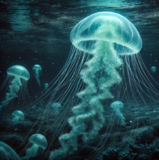 |
Atterian Sea Nettle | 1.2 meters (3 feet 11 inches) | 15 kilograms (33 pounds) | Coastal waters of Vaeringheim, Symphonara, and Delphica. | The Atterian Sea Nettle is a captivating and graceful jellyfish known for its stunning, bioluminescent appearance. Residing in the depths of Lake Morovia, it possesses unique characteristics that set it apart from the region's other jellyfish.
Atterian Sea Nettles are predominantly found in the deep, dark waters of Lake Morovia, where their gentle pulsating movements and glowing tentacles create a mesmerizing spectacle. They are rarely seen in shallower waters, preferring the mysterious depths. Generally peaceful, Atterian Sea Nettles can be found drifting through the depths of the Lake, and using their bioluminescence to communicate with one another. They often form small colonies, creating stunning displays of underwater light shows. They are primarily carnivorous, hunting smaller aquatic organisms with their poisonous tentacles. In the rare instances when Atterian Sea Nettles encounter threats, they can release a cloud of toxic mucus as a defense mechanism. This mucus not only deters potential predators but also creates a temporary smokescreen to escape from danger. |
 |
Ocian Swamp Squid | 0.6 meters (2 feet) | 7 kilograms (15.4 pounds) | Marshy coastal waters of Somniumpolis, Saluria, and the surrounding wetlands. | The Ocian Swamp Squid is a mysterious and elusive squid that inhabits the dark, murky waters of swamps and wetlands of Lake Morovia. This unusual creature is known for its unassuming appearance, and its fascinating abilities.
Ocian Swamp Squid are primarily found in the shadowy depths of swampy environments of Lake Morovia. They are known to thrive in stagnant and brackish waters, using the concealment of the murky, sediment-filled surroundings to their advantage. Mostly solitary and reclusive, the Ocian Swamp Squid prefers to remain hidden within the murky waters of their swampy homes. They are expert ambush predators, using their camouflage to remain undetected until an unsuspecting prey item comes within reach. Their docile appearance can be misleading, as they become highly defensive when threatened. Ocian Swamp Squid are Known for their complex and strange courtship rituals, which often involve intricate color displays and synchronized movements. Breeding occurs in the deeper parts of their swamp habitats, and the newly hatched larvae go through several stages of development before reaching maturity. |
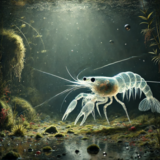 |
Odiferan Marsh Shrimp | 0.3 meters (1 foot) | 2 kilograms (4.4 pounds) | Swamps and marshes near Myrene and Symphonara. | The Odiferan Marsh Shrimp is a unique and mysterious shrimp found in the Odiferan Marsh. This small, elusive creature boasts a captivating array of features and abilities that distinguish it from the region's other shrimp.
Odiferan Marsh Shrimp thrive in the murky and nutrient-rich waters of the Odiferan Marsh, a region filled with dense vegetation and unique flora. They are often found in shallow, slow-moving streams and pools within the marsh. Odiferan Marsh Shrimp are primarily nocturnal creatures, emerging from their hiding spots at night to forage for food. They use their bioluminescent lure to attract insects and small aquatic invertebrates, which they capture using their agile swimming and precision strikes. Although they are generally peaceful, these creatures can become more aggressive when competing for resources or territory in the marsh. During the breeding season, male Odiferan Marsh Shrimp engage in intricate dance-like courtship displays, showcasing their bioluminescent lures to attract potential mates. Once courtship is successful, females lay their eggs among the aquatic plants in the marsh. |
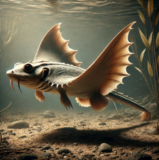 |
Hatch's Ray | 2.5 meters (8 feet 2 inches) | 200 kilograms (440 pounds) | Coastal marshes and swamps around Pyralis, Saluria, and Somniumpolis. | Hatch's Ray is an extraordinary and unusual creature known for its unique adaptation to swampy environments, which has evolved to thrive in the murky waters of swamps and marshes of Lake Morovia.
Hatch's Rays are predominantly found in the heart of swampy regions, where dense vegetation and shallow, brackish waters provide the ideal habitat for these extraordinary creatures. They are most commonly sighted in slow-moving streams, sloughs, and muddy ponds. Hatch's Rays are known for their solitary and reclusive nature, preferring the serenity of the swamp's quieter corners. They are expert ambush predators, often remaining partially buried in the swamp's mud and vegetation, awaiting unsuspecting prey to come within striking distance. These creatures are territorial by nature, and disputes over prime hunting grounds are not uncommon. Hatch's Rays communicate through a series of infrasound vocalizations that are imperceptible to humans, but can be heard by other Rays Mating rituals among Hatch's Rays involve elegant and synchronized swimming displays, where potential mates perform a mesmerizing dance that often culminates in courtship and, eventually, egg-laying among the reeds and aquatic plants of the swamp. |
 |
Atteran River Shark | 2.5 meters (8 feet 2 inches) | 350 kilograms (771 pounds) | Waters of the Strait of Haifa, near Aegirheim, Skýrophos, and Norsolyra. | The Atteran River Shark is a formidable, large shark, aptly named for its imposing presence and its preference for the turbulent waters of the Strait of Haifa. This apex predator is a master of its domain.
Atteran River Sharks are primarily found in the fast-flowing and murky waters of the Strait of Haifa, especially in the waters surrounding the Abeisan Archipelago. They are often sighted in the deeper, churning sections of the region's waterways. Atteran River Sharks are solitary predators, with each individual claiming its own territory along a stretch of the Atteran River. This shark is highly territorial and fiercely defend their hunting grounds from other predators. While formidable in battle, they tend to be patient hunters, lying in wait for fish and aquatic creatures to venture into their domain. During the breeding season, male Atteran River Sharks engage in fierce territorial battles to establish dominance. Once a territory is secured, the winning male performs an intricate courtship display to attract a female. The female lays her eggs in a secluded area of the river, and the male guards them diligently. |
 |
Haifan Armored Lake Dolphin | 1.8 meters (5 feet 11 inches) | 120 kilograms (264.5 pounds) | Shallow waters of Lake Morovia, particularly near Vaeringheim, Luminaria, and Delphica. | The Haifan Armored Lake Dolphin is a remarkable and unique creature, which resides in the murky waters of the Haifan region, it is known for its elegant beauty and formidable defensive capabilities.
Haifan Armored Lake Dolphins are most commonly found in the calm shallow waters of Lake Morovia. These tranquil environments provide the perfect sanctuary for these graceful creatures, where they can flourish and thrive. Haifan Armored Lake Dolphins are sociable creatures, often found swimming in small family groups or pods. They communicate using their sonic pulses, creating a harmonious symphony of sound that resonates throughout the waters of the Haifan region. While generally peaceful, they become fiercely protective when their habitat is threatened. These dolphins are expert hunters, using their echolocation abilities to locate prey with remarkable precision. They feed on fish, aquatic invertebrates, and occasionally aquatic plants, making them vital components of their ecosystem. During the breeding season, Haifan Armored Lake Dolphins engage in mesmerizing underwater displays, showcasing their agility and grace. Mating pairs often engage in synchronized swimming. |
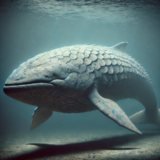 |
Vaering's Armored Whale | 6 meters (19 feet 8 inches) | 1,200 kilograms (2,646 pounds) | Open waters of Lake Morovia, with frequent sightings between Symphonara and Vaeringheim. | Vaering's Armored Whale is an awe-inspiring, massive whale, celebrated for its majestic presence and known for its formidable strength and unwavering endurance, this colossal creature roams the vast waters of Lake Morovia and the central Strait of Haifa.
Vaering's Armored Whales are most commonly found in the open oceans of Lake Morovia, where they navigate the depths and expanse of the lake with ease. They often undertake long migrations across the lake, following elusive currents. Leading a a relatively solitary life, these whales occasionally forming small, temporary pods when encountering other individuals. They communicate through a series of deep, resonant calls, often echoing through the vast lake. Their songs are considered one of the wonders of the natural world, captivating all who hear them. These whales are expert foragers, utilizing their hydrokinetic powers to corral schools of fish and other prey. They are key figures in maintaining the ecological balance of the oceans, as they often feed on overpopulated species to prevent depletion of marine resources. During the breeding season, Vaering's Armored Whales engage in elaborate courtship displays, which involve synchronized swimming, breathtaking breaches, and intricate sonic rituals. After mating, the female typically gives birth to a single calf, which she cares for and protects diligently. |
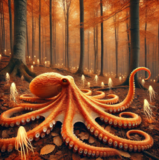 |
Orange Forest Land Octopus | 1 meter (3 feet 3 inches) | 10 kilograms (22 pounds) | Coastal forests and swamp regions of Norsolyra and surrounding areas. | The Orange Forest Land Octopus is an extraordinary and enigmatic terrestrial octopus, which inhabits the Gloom Forest of Perpetual Autumn, this creature has evolved to thrive in the eerie and mystical environment of the forest, where it feeds on the parasitic will-o-wisps that illuminate the dark woods.
The Orange Forest Land Octopus calls the mysterious Gloom Forest its home, a place shrouded in legends and mystery. This haunted forest is known for its luminous will-o-wisps, which serve as both the primary food source and an integral part of the Octopus's ecosystem. A solitary creature, the Land Octopus is often seen prowling the dark depths of the Orange Forest in search of will-o-wisps. It moves stealthily through the underbrush, its ghostly camouflage concealing it from potential predators and prey. The Orange Forest Land Octopus is seldom observed by humans, as it is a master of remaining hidden within the mystical forest. Its presence in the Orange Forest has contributed to the numerous legends and tales that surround this eerie woodland. |
 |
Abeisan Walrus | 2.5 meters (8 feet 2 inches) | 1,000 kilograms (2,204 pounds) | Coastal marshes around the Abeisan Archipelago, extending to Somniumpolis. | The Abeisan Walrus is a remarkable and resilient creature, celebrated for its commanding presence and unique adaptation to the swampy coastal regions of the Abeisan Archipelago.
Abeisan Walruses are primarily found in the Abeisan Archipelago, where they inhabit the brackish waters, coastal marshes, and frigid beaches. They are known to rest on ice floes during colder months and venture into the coastal swamps when the weather is warmer. Abeisan Walruses are sociable creatures, often congregating in small herds along the frigid coastlines of the Abeisan Archipelago. They are expert foragers, diving deep into the cold waters to hunt for fish, crustaceans, and other aquatic prey. These Walruses are known for their distinctive, eerie calls, which can be heard echoing across the coast. Their vocalizations serve as a means of communication within their herds and, during the breeding season, as courtship songs. During breeding season, male Abeisan Walruses engage in powerful, tusk-clashing displays to establish dominance and attract potential mates. Females typically give birth to a single calf, which they protect and nurture in the safety of their swampy coastal habitats. |
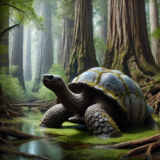 |
Greater Morovian Giant Turtle | 2.2 meters (7 feet 2 inches) | 1,125 kilograms (2,480 pounds) | Coastal waters and hidden bays around Delphica and Luminaria. | The Greater Morovian Giant Turtle is a majestic and venerable beast, renowned for its colossal size and serene presence. Inhabiting the waters of the Morovian region, this ancient creature is a symbol of wisdom and endurance.
Greater Morovian Giant Turtles are most commonly found in the brackish coastal waters of Lake Morovia. They prefer secluded coves and peaceful bays, where they find refuge and sustenance. The Greater Morovian Giant Turtle is a gentle and solitary creature, often observed drifting gracefully through the the Lake's coastal waters. These ancient creatures are known to live for centuries, displaying a deep connection with the ebb and flow of the lake. Their colossal shells serve as a haven for smaller aquatic species, including algae, and fish. This symbiotic relationship benefits both the Greater Morovian Giant Turtle and the species that take refuge on its back, creating a thriving ecosystem. During the breeding season, male Greater Morovian Giant Turtles engage in elaborate courtship rituals, involving synchronized swimming and the generation of seismic vibrations to attract potential mates. Once a pair is established, the female lays her eggs on the sandy shores of the Morovian coastline. |
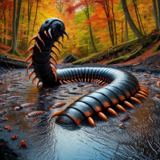 |
Tar Worm | 2 meters (6 feet 7 inches) | 200 kilograms (440 pounds) | Tar-pits and geothermal regions surrounding Erythros and its neighboring settlements. | The Tar Worm is a formidable and highly unusual creature, known for its tenacious existence in the treacherous tar-pits of its native region. This creature, has evolved to thrive in the hazardous and unforgiving environment of the tar-pits of the Gloom Forest of Perpetual Autumn.
Tar Worms are primarily found in the vast, gloomy tar-pits of their native region, where they navigate the viscous, oil-like substance with surprising ease. They can also be encountered in the surrounding areas, which often feature geothermal activity. Tar Worms are solitary and relentless hunters, making the tar-pits their home and feeding on smaller creatures that become trapped in the tar. Their venomous bites and powerful strikes are essential for subduing prey, and they are known for their patience in waiting for an opportunity to strike. Tar Worms are also infamous for feeding on human remains deposited in the tar-pits as part of Alperkin funerary customs. Despite their formidable appearance and territorial nature, Tar Worms play a vital role in the ecosystem of their native region. Their presence helps control the population of smaller creatures and maintains the balance within the tar-pits' delicate environment. The Tar Worms' adaptation to the harsh tar-pits has made them an central part of local folklore and legend, often symbolizing resilience and determination in the face of adversity. |
 |
Rift Valley Crocodile | 4 meters (13 feet) | 500 kilograms (1,102 pounds) | Swamps and river valleys around Lake Morovia and the central Strait of Haifa. | The Rift Valley Crocodile is a formidable creature, known for its powerful presence in the vast waters of the Haifan Rift Valley. This ancient creature, is known for its resilience and survival instincts in its unique habitat.
Rift Valley Crocodiles primarily inhabit the expansive Haifan Rift Valley, where they make their homes in the numerous lakes and rivers found within this geographic wonder. They are frequently encountered along the muddy banks and calm, freshwater bodies of the central Strait of Haifa and its tributaries. Rift Valley Crocodiles are solitary and territorial creatures, often seen basking in the sun along riverbanks or floating stealthily in the calm waters of the Strait of Haifa and Lake Morovia. They are patient hunters, relying on their camouflage to ambush unsuspecting prey that ventures too close. Their nests are hidden within the riverbanks, where females lay their eggs and protect them diligently. Once hatched, the young crocodiles are highly vulnerable and require their mother's care and protection until they are old enough to fend for themselves. The large presence of Rift Valley Crocodiles in the Strait has led to their inclusion in local mythology and tales, symbolizing both the danger and the enduring beauty of the region. |
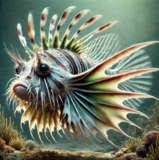 |
Atterian Armored Pufferfish | 0.5 meters (1 foot 7 inches) | 5 kilograms (11 pounds) | Coastal reefs and sandy seabeds around Lake Morovia and the northern Strait of Haifa. | The Atterian Armored Pufferfish is a unique and extraordinary fish which inhabits the coastal waters of Lake Morovia. This resilient creature is known for its intricate armored plating and its formidable defenses.
Atterian Armored Pufferfish are most commonly found among Lake Morovia's coral reefs and shallow, sandy seabeds where they can find both protection and sustenance. Atterian Armored Pufferfish are known for their gentle disposition and their preference for a peaceful coexistence with other organisms in the reef ecosystem. They are skilled hunters, using their water manipulation abilities to corral small fish and invertebrates into the confines of the coral reefs. When confronted by threats, they employ their unique defensive strategy of inflating their steel-plated bodies, rendering them nearly impervious to attack. This behavior is often sufficient to deter predators, and they generally prefer to avoid confrontations whenever possible. Mating rituals among Atterian Armored Pufferfish involve intricate displays of coordinated swimming and water manipulation. Once a mating pair is established, the female will lay her eggs in a secluded crevice within the reef, and both parents will diligently guard the nest. |
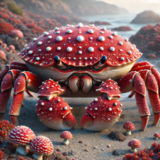 |
Amina Crab | .85 meters (2 foot 9 inches | 30 kilograms (66 pounds) | Rocky coastlines and clear, temperate waters around Lake Morovia, especially near Symphonara and Myrene. | The Amina Crab is a massive and formidable crab which inhabits the coastal waters of the Lake Morovia.
Amina Crabs are most commonly found along the rocky coastlines and in the clear, temperate waters of Lake Morovia. They favor areas with abundant underwater caves and crevices, where they seek shelter and protection. Amina Crabs are solitary and territorial creatures, often found lurking in underwater caves or patrolling the rocky Lake bed. They are expert hunters, capturing fish, crustaceans, and other marine life with their mighty claws. Their territorial nature often leads to disputes with other Amina Crabs over prime hunting grounds. These battles are fierce and can result in significant changes in territory ownership. During the breeding season, male Amina Crabs engage in elaborate displays of strength and agility to impress potential mates. After mating, the female lays her eggs in a secluded underwater crevice, where she guards them diligently. |
 |
Low Valley Swamp Roach | 0.6 meters (2 feet) | 20 kilograms (44 pounds) | Swamps and marshes around the lower valleys near the Morovian Lake region. | The Low Valley Swamp Roach is a formidable trilobite, known for its distinctive appearance and predatory nature, which inhabits the murky waters of the Morovian swamps.
Low Valley Swamp Roaches are primarily found in the dark, swampy waters of the Lake Morovia region. They make their homes in the muck and sediment, where they prowl for prey among the aquatic plants and detritus. Low Valley Swamp Roaches are solitary and territorial, often claiming specific hunting grounds within the swamp. They are patient and stealthy hunters, relying on their camouflage and ambush tactics to capture small aquatic creatures and insects. These creatures are known for their mysterious behavior, often lurking in the darkness of the swamp for hours before striking at their prey. They are also known to scavenge on decaying matter and plant material, serving as integral components of the swamp's ecosystem. They are also known to pose a danger to humans, and have been observed hunting people. Mating rituals among Low Valley Swamp Roaches involve intricate displays of underwater acrobatics, with males competing to impress potential mates. After mating, the female lays her eggs among the submerged vegetation, and both parents diligently guard the nest. |
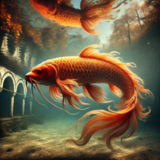 |
Fái's Koi | 1.5 meters (4 feet 11 inches) | 25 kilograms (55 pounds) | Sacred lakes and ponds near Erythros and throughout the Gloom Forest. | Fái's Koi is a mystical and revered fish, which embodies the ancient tales of the skies and seas. This extraordinary creature appears as a majestic, ancient koi fish adorned with shimmering scales that catch the light like stardust. Fái's Koi possesses a unique ability to traverse both the depths of the region's waterways and the vast expanse of the heavens.
Fái's Koi is said to dwell in the waters surrounding Erythros, where the boundaries between the earthly and the ethereal blur. Legends speak of its presence in tranquil lakes and sacred ponds, where it rises to the surface to bask in the light of Tarsica before taking flight into the starlit sky. Fái's Koi is a symbol of tranquility and enlightenment, revered by the people of the Erythros as a guardian of harmony and wisdom. It is said to possess ancient knowledge of the cosmos, which it expresses through a haunting song which can be heard echoing through the forests of Erythros as it flies through the night sky, and those who encounter it are said to be blessed with insight and clarity. The fish is often depicted in artwork and folklore, its celestial form inspiring poets, artists, and seekers of truth. Legends tell of pilgrimages made to sacred lakes in search of Fái's Koi, where devotees hope to catch a glimpse of its celestial flight and receive its divine blessings. |
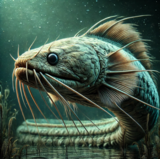 |
Morovian Saucer-Eyed Giant Eel | 3 meters (9 feet 10 inches) | 90 kilograms (198 pounds) | Deep waters of the Gloom Forest of Perpetual Autumn, near Erythros and surrounding marshes. | The Morovian Saucer-Eyed Giant Eel is a fearsome and ancient predator, known for its distinctive saucer-like eyes and formidable presence in the waters of the Gloom Forest of Perpetual Autumn. This eel, with its elongated body and dark, camouflaged skin, is a master of stealth and ambush, making it one of the most feared inhabitants of its murky domain.
Morovian Saucer-Eyed Giant Eels inhabit the deep, shadowy waters of the Gloom Forest's lakes and rivers. The perpetual autumn foliage that falls into the water provides perfect cover for these eels, allowing them to blend seamlessly with their surroundings and strike with lethal precision. Morovian Saucer-Eyed Giant Eels are solitary and highly territorial creatures. They are apex predators in their domain, preying on a variety of smaller aquatic animals and even other predators that venture too close. Despite their fearsome reputation, these eels play a crucial role in maintaining the balance of the aquatic ecosystem by controlling the populations of their prey. Their elusive nature and the remote, dark waters they inhabit make encounters with the Morovian Saucer-Eyed Giant Eel rare and often unnerving. Local legends and folklore often depict these eels as guardians of the deep, their glowing eyes a haunting presence in the murky depths. |
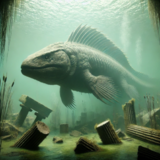 |
Glinos Leviathan | 8 meters (26 feet 3 inches) | 1,500 kilograms (3,307 pounds) | Frigid depths of Lake Morovia, with occasional sightings near Vaeringheim. | The Glinos Leviathan is a massive and fearsome predator, revered and feared in equal measure. Named after the god of ice and winter, this imposing creature rules the cold depths of its aquatic realm with unmatched ferocity and power. With its ice-blue scales and piercing eyes, the Glinos Leviathan embodies the harsh and unyielding nature of the depths of Lake Morovia.
Glinos Leviathans are found in the frigid, depths of Lake Morovia. They thrive in the deepest, coldest parts of these waters. These leviathans are also known to migrate to icy rivers during the winter months. Glinos Leviathans are solitary and highly territorial creatures, known for their aggressive nature and dominance over their territories. They are apex predators, preying on a wide range of aquatic life, including other large predators. Despite their fearsome reputation, they are also revered in local folklore as the embodiment of the lake's power and the guardians of the Strait. These leviathans are rarely seen by humans due to their preference for deep, cold waters, but when they do surface, their presence is both awe-inspiring and terrifying. Legends tell of their immense strength and the chilling roar that can be heard for miles when they breach the surface. |
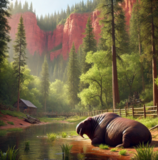 |
Bulhanu's Sea Cow | 4 meters (13 feet 1 inch) | 2,000 kilograms (4,409 pounds) | Coastal waters of Somniumpolis and surrounding nutrient-rich areas. | The Bulhanu's Sea Cow is a massive and docile aquatic bovine, highly valued in the coastal city of Somniumpolis for its tender beef and gentle nature. With its large, robust body adapted for life in both shallow and deep waters, this creature is a cornerstone of the region's agricultural economy.
Bulhanu's Sea Cows are predominantly found in the calm, nutrient-rich waters surrounding Somniumpolis. They thrive in both freshwater and marine environments, often seen grazing on underwater vegetation in coastal lagoons, rivers, and estuaries. Bulhanu's Sea Cows are social animals, often found in large herds that graze together in the lush underwater meadows. They communicate through low-frequency sounds that can travel long distances underwater, keeping the herd coordinated and safe. These sea cows are highly valued for their meat, which is known for its rich flavor and tender texture. The people of Somniumpolis have developed sustainable farming practices to ensure the well-being of these creatures, balancing the needs of the local ecosystem with agricultural demands. |
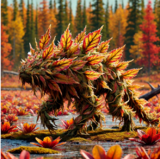 |
Gloom Forest Moss Hog | 1.2 meters (3 feet 11 inches) | 35 kg (77 lbs) | Swamps and wetlands along the shores of the Gloom Forest of Perpetual Autumn. | The Moss Hog is a remarkable creature native to the northern latitudes of Micras, where it thrives in the swampy regions amidst autumnal foliage. This semi-aquatic reptile has evolved extraordinary camouflage abilities, allowing it to blend seamlessly with its environment. Its body is covered in leaf-like appendages that mimic the vibrant orange, yellow, and red colors of the Gloom Forest.
The Moss Hog is most commonly found along the shores of swamps and wetlands of the Gloom Forest of Perpetual Autumn. It prefers areas with abundant vegetation where it can use its camouflage to its advantage. It is a peaceful creature that spends much of its time foraging for aquatic plants and small insects. It is known to be quite elusive, often hiding among the foliage to avoid detection. When threatened, it uses its Leaf-like appendages to vanish from sight, leaving its pursuers baffled.
|
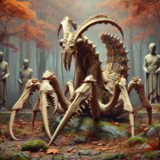 |
Minervial Mantis | 1.8 meters (5 feet 11 inches) | 60 kilograms (132 pounds) | Dense swamp regions surrounding Aurelia and Sylvapolis. | The Minervial Mantis is a unique, giant aquatic mantis which is capable of complex forms of camouflage, allowing it to blend seamlessly with the murky swamp environments around Aurelia. Despite its fearsome appearance, the Minervial Mantis is not aggressive toward humans unless provoked, especially during its territorial mating season.
Inhabiting the dense, shadowy swamps in the region surrounding Lake Morovia, the Minervial Mantis thrives in waterlogged environments that support its diet and provide ample cover. These habitats are crucial during its mating season when the Minervial Mantis becomes particularly territorial. The Minervial Mantis leads a mostly solitary life, becoming highly territorial and visibly aggressive towards other males during the mating season as it competes for mates. It communicates through low-frequency vibrations in the water, which are also used to deter rivals and attract females. Outside of mating season, it is a patient and efficient predator, using its camouflage to ambush prey. While the Minervial Mantis may appear daunting, its focus on maintaining ecological balance in its habitat and its complex behaviors during mating season make it a fascinating subject for study. Observers are advised to respect its space during the breeding season to avoid triggering its territorial instincts. |
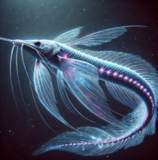 |
Vaalshrin Deep-Stalker | 2 meters (6 feet 7 inches) | 12 kilograms (26 pounds) | Abyssal depths of Lake Morovia, near Somniumpolis and Vaeringheim | The Vaalshrin Deep-Stalker is a sleek, ethereal predator that dwells in the lightless depths of the ocean, gliding through water with near-silent precision. Its translucent, ribbon-like fins, marked with luminescent spots along its spine, create a mesmerizing display in the dark waters, both attracting prey and confusing potential threats. Its elongated, slender body allows it to dart effortlessly through narrow passages in deep-sea caves. The creature’s sensitive whisker-like appendages, located near its snout, detect even the faintest movements in the water, helping it locate prey in pitch-black surroundings.
Primarily a solitary hunter, the Vaalshrin Deep-Stalker uses stealth and patience to ambush prey. It remains motionless until unsuspecting creatures come close, then strikes with remarkable speed, using its elongated jaws and sharp, needle-like teeth to secure its catch. Although usually reclusive, it becomes more aggressive during mating season, when males engage in swift, territorial displays. This species is rarely seen by human eyes due to its extreme habitat depths, making each encounter with the Vaalshrin Deep-Stalker a rare spectacle. It is highly revered in certain coastal cultures, symbolizing both mystery and resilience, as legends speak of it guiding lost souls through the dark depths of the ocean. |
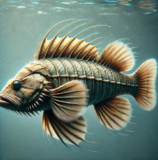 |
Atosi Bass | 1 meter (3 feet 3 inches) | 22 kilograms (48 pounds) | Thermal vents of the Strait of Haifa, near Aegirheim and Skýrophos | The Atosi Bass is a heavily armored fish species, renowned for its dense, segmented scales. These thick scales provide exceptional protection against predators, making the Atosi Bass one of the most resilient fish in its habitat. Its broad, fan-like fins are marked with spines that can be flared when threatened, adding to its intimidating presence in the water. Its large, unblinking eyes allow it to navigate and hunt in low-light conditions, detecting subtle movements around it.
Despite its rugged appearance, the Atosi Bass is generally a calm and solitary creature, spending much of its time foraging along rocky lake beds. However, it is known to become highly aggressive if approached or threatened. During spawning season, males establish small territories and fiercely defend them, engaging in displays of fin-flaring and headbutting to ward off rivals. The Atosi Bass holds a prominent place in local folklore, symbolizing strength and resilience. It is revered by certain river-dwelling communities, where it is seen as a guardian spirit of freshwater bodies. Its scales are sometimes fashioned into talismans or jewelry, believed to bring protection and courage to the wearer. However, the fish is seldom hunted due to its tough armor and the difficulty of catching it. |
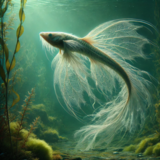 |
Ahzraal Wyrdling | 0.8 meters (2 feet 7 inches) | 5 kilograms (11 pounds) | Kelp forests of Lake Morovia, around the coasts of Vaeringheim and Symphonara | The Ahzraal Wyrdling is a delicate, ethereal creature known for its flowing, translucent fins and slender body, which give it a ghostly appearance as it moves gracefully through sun-dappled river waters. Its wispy, feathered fins are sensitive to even the slightest currents, allowing it to drift effortlessly along riverbeds and weave through kelp forests. The Wyrdling's pale, iridescent scales shimmer with subtle hues that blend seamlessly with its surroundings, giving it a natural camouflage. Its large, curious eyes are thought to be highly sensitive to light, enabling it to thrive in both shaded and sunlit areas.
Gentle and curious, the Ahzraal Wyrdling is a passive creature, often seen meandering through rivers and resting among tall water plants. It is known to form loose groups, called "whispers," which drift together and create mesmerizing displays of synchronized movement. The Wyrdling is drawn to areas with abundant aquatic flora, where it forages on plant matter. During mating season, its fins become even more radiant, enhancing its otherworldly beauty to attract mates. The Ahzraal Wyrdling is celebrated in folklore as a symbol of tranquility and harmony with nature. Many riverside communities revere it as a spiritual guide, believing that its presence brings peace and prosperity to the waterway. Stories abound of fishermen who encountered Wyrdlings on misty mornings, receiving blessings of abundant harvests and safe journeys in return for their respect. Its feathers are sometimes used in rituals or woven into garments to promote inner peace and connection with nature. |
 |
Tarsican Cantor | 2.5 meters (8 feet 2 inches) | 30 kilograms (66 pounds) | Deep trenches of the Strait of Haifa, near Skýrophos | The Tarsican Cantor is a breathtaking marine creature with delicate, lace-like arms adorned with bioluminescent nodes that create a hypnotic glow in the dark waters. Its flowing appendages are covered in intricate patterns, reminiscent of lacework, which it uses to gracefully move through the coral reefs and shallow waters. This ethereal appearance, combined with the Cantor's slow, elegant movements, makes it seem like an oceanic apparition. Its large, intelligent eyes are capable of perceiving a broad spectrum of colors, allowing it to interact with its environment in ways that are still a mystery to researchers.
The Tarsican Cantor is a solitary and highly intelligent creature known for its unique vocalizations, which sound like a haunting, melodic hum that echoes through the water. These "songs" are believed to serve both as a method of communication and a way to establish territory. The Cantor's calming hum is particularly prominent during dusk, when it can be heard for miles around, drawing other creatures toward it in a peaceful, almost trance-like state. It is generally docile but will display remarkable agility if threatened, using its mesmerizing lights and agile movements to evade predators. The Tarsican Cantor is revered in coastal folklore as a mystical creature of wisdom and song. Sailors believe that hearing its song on the open sea brings luck and guidance, while certain island cultures view it as a spirit of the ocean, connecting the realms of the living and the divine. Its bioluminescent patterns are sometimes used as inspiration in ceremonial tattoos, symbolizing harmony, mystery, and the deep connections shared by all life in the ocean. |
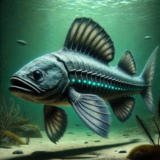 |
Norsolyrian Razorfin | 0.7 meters (2 feet 4 inches) | 4 kilograms (8.8 pounds) | Shallow bays along the coast of Norsolyra | The Norsolyrian Razorfin is a formidable freshwater predator, named for the sharp, blade-like dorsal fin that runs along its spine. Its thick, plated scales, often compared to chainmail, provide a strong defense against potential threats and rough environments. The Razorfin’s body is dark and muted, but along its side, bioluminescent nodes emit a soft, greenish glow, a feature thought to aid in communication or to attract prey in the dim waters it frequents. Its powerful jaws and serrated teeth make it a highly efficient hunter, while its muscular build allows for sudden bursts of speed to catch unsuspecting prey.
Solitary by nature, the Norsolyrian Razorfin is an ambush predator, lying in wait along riverbeds or rocky lake floors, where it blends seamlessly with the surrounding environment. It tends to patrol the deeper regions of lakes and rivers but occasionally ventures closer to the surface at dawn and dusk to hunt. Known for its aggression, the Razorfin defends its territory fiercely, especially during mating season, when males compete for the right to secure the best hunting grounds. The Norsolyrian Razorfin is deeply ingrained in local mythology as a symbol of resilience and survival. It is often depicted in ancient carvings and murals as a guardian of the northern waterways. Revered and feared in equal measure, the Razorfin is sometimes called "the river knight" by locals, who believe that its presence protects the lakes and rivers from malevolent spirits. Fishermen wear amulets shaped like its dorsal fin for protection, though actual encounters with the Razorfin are rare due to its preference for deeper waters. |
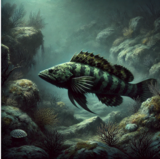 |
Vaeringheim Shadowfin | 1.5 meters (4 feet 11 inches) | 10 kilograms (22 pounds) | Shallow reefs near the coast of Vaeringheim | The Vaeringheim Shadowfin is a stealthy, elusive predator adapted to the murky depths and shadowy reefs of its northern habitat. Its dark, mottled green and black scales provide natural camouflage among rocks and algae-covered surfaces, allowing it to vanish almost entirely when still. The Shadowfin's dorsal and pectoral fins are edged with sharp, spiny ridges that give it a distinctive, jagged silhouette. Its sharp, hooked jaws are designed for catching and holding onto prey, while its sleek body enables agile movements through tight, rocky spaces.
The Shadowfin is primarily nocturnal, venturing out under the cover of darkness to hunt. During the day, it hides in underwater caves or deep within reef structures, where it remains motionless and nearly invisible. Known for its patience, the Shadowfin often waits in ambush, striking only when prey comes within reach. When threatened, it emits a low-frequency rumble that serves as a warning to intruders and deters potential predators. During mating season, it performs a unique "shadow dance," an undulating movement used to communicate and attract mates. The Vaeringheim Shadowfin is regarded as a mysterious and almost mythical creature in the lore of the northern coastal tribes, where it is considered a spirit of the dark waters. Legends portray it as a guardian of the hidden places, watching over submerged caves and reefs. Some believe that encounters with the Shadowfin are omens of significant change, whether good or ill. The Shadowfin’s image is often used in ceremonial tattoos to symbolize secrecy, strength, and resilience, qualities that its solitary and stealthy lifestyle embodies. |
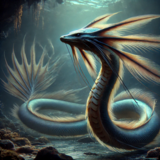 |
Skýrophian Serpent Eel | 1.5 meters (4 feet 11 inches) | 15 kilograms (33 pounds) | Canyons and underwater cliffs near Skýrophos | The Skýrophian Serpent Eel is a large, serpentine predator with a body that combines the elegance of a serpent with the muscular strength of an eel. Its scales are dark and glistening, reflecting subtle shades of blue and bronze under light. Flowing, fin-like extensions along its head and spine add a regal appearance and serve as sensory organs, enabling it to detect minute vibrations in the water. Its elongated body moves with a mesmerizing, undulating rhythm, allowing it to navigate through underwater caverns and volcanic crevices with ease. Sharp, needle-like teeth line its powerful jaws, ideal for capturing and holding slippery prey.
The Skýrophian Serpent Eel is a territorial creature, often claiming expansive underwater territories where it hunts and patrols. It is known for its intelligence and calculated aggression, preferring to stalk its prey before attacking with a swift, coiled strike. When threatened, the Serpent Eel fans out its fin-like extensions and releases a low, resonating growl, creating an intimidating display. During mating season, it performs a complex courtship dance, using its body and fins to create intricate patterns that captivate potential mates. The Skýrophian Serpent Eel is deeply respected and feared by the people of Skýrophos, where it is often regarded as a guardian of the deep, volcanic waters. In local folklore, it is seen as a creature of wisdom and power, embodying the primal forces of the earth and sea. Tales describe it as a guide for souls lost at sea, helping them find their way to the afterlife. Its scales are believed to bring strength and resilience, and small tokens made in its likeness are often worn by sailors for protection on dangerous voyages. |
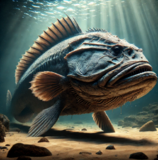 |
Aegirheim Tidal Goliath | 5 meters (16 feet 5 inches) | 1,000 kilograms (2,205 pounds) | Coastal waters near Aegirheim | The Aegirheim Tidal Goliath is an imposing, heavily armored fish with a rugged, battle-worn appearance. Its thick, bumpy scales and rough skin are adaptations to withstand the abrasive forces of tidal currents and rocky outcrops. This massive creature has a wide, powerful jaw with rows of blunt teeth ideal for crushing shells and coral, and its large, deep-set eyes give it a perpetually intense expression. Fins equipped with strong, bony spines allow it to maneuver in turbulent waters, and its muscular build grants it resilience against the relentless tides of its coastal habitat.
Despite its size and fearsome appearance, the Tidal Goliath is a generally passive creature, content to patrol its territory and feed on abundant marine life in the area. It is often seen gliding near the ocean floor, stirring up sediment as it moves. Known for its patience, the Tidal Goliath can remain motionless for hours, camouflaging itself among rocks until unsuspecting prey comes near. When disturbed, however, it will charge forward with surprising speed, using its bulk to intimidate potential threats. During mating season, Tidal Goliaths gather in groups to perform synchronized movements that resemble a slow, majestic dance along the reef. The Aegirheim Tidal Goliath holds a revered place in coastal folklore, symbolizing endurance and strength. It is often regarded as a "spirit of the reef," representing the stability and power of the ocean itself. Coastal communities near Aegirheim celebrate the Tidal Goliath in festivals, where large wooden sculptures of the creature are paraded through villages as a tribute to the sea. Its likeness is also carved into the prows of boats, believed to offer protection and stability in rough waters. Encounters with a Tidal Goliath are considered a blessing and are believed to bring good fortune to those who respect its territory. |
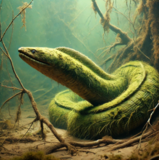 |
Somnian Mossback Eel | 2 meters (6 feet 7 inches) | 25 kilograms (55 pounds) | Marshy coastal waters near Somniumpolis | The Somnian Mossback Eel is a large, serpentine creature covered in algae and moss that naturally grows along its rough, textured skin, allowing it to blend seamlessly into its swampy environment. This greenish, moss-covered exterior not only camouflages it from prey and predators alike but also gives it an ancient, otherworldly appearance. Its muscular body is built for strength, allowing it to coil around its prey with powerful constrictions. Small, lidless eyes give the Mossback Eel a watchful, patient expression, well-suited to its ambush hunting style.
The Mossback Eel is a patient and methodical hunter, often lying motionless on the riverbed or coiled around submerged roots for extended periods. It waits for unsuspecting prey to wander too close before launching a swift, constricting attack. Unlike most eels, it does not rely solely on speed but uses stealth and the element of surprise. During colder months, it burrows into the soft, muddy bottoms of swamps to conserve energy. Mating season sees these eels engaging in slow, spiraling dances, where pairs intertwine in the murky water, creating an almost hypnotic display. The Somnian Mossback Eel is viewed with a mix of awe and caution by the people of Somnium, who consider it a symbol of resilience and adaptability. Legends tell of Mossback Eels guiding lost travelers through swampy terrains or acting as guardians of hidden treasures buried in the wetlands. Locals sometimes place moss-covered stones at the edges of rivers to honor the creature and request safe passage. The Mossback Eel is rarely hunted, as its meat is tough and its habitat challenging to navigate, but those who encounter it regard the experience as a rare and mystical encounter with the ancient spirit of the swamp. |
 |
Delphican Harpooner | 1.3 meters (4 feet 3 inches) | 20 kilograms (44 pounds) | Rocky coastal areas of Delphica | The Delphican Harpooner is a fierce, spiny fish known for its elongated, spear-like jaw and sharp, jagged fins. Its body is heavily armored with bony plates, giving it a formidable, almost prehistoric appearance. The Harpooner’s fins, especially the large dorsal fin, are lined with spiny protrusions that it can flare when threatened, creating an intimidating silhouette. The piercing eyes of the Harpooner are well-suited for tracking movement in murky waters, and its powerful, serrated jaws make it an efficient predator capable of seizing and immobilizing fast-moving prey.
The Harpooner is an aggressive and territorial creature, often seen patrolling its hunting grounds along rocky reefs. It is a solitary hunter that relies on stealth and ambush tactics, using its elongated snout to spear or pin prey against rocks. During feeding frenzies, multiple Harpooners may gather, their sharp fins and snapping jaws creating a chaotic and dangerous scene for other marine life. In the breeding season, males engage in intense displays, flaring their fins and circling each other in ritualized combat to establish dominance and secure mates. The Delphican Harpooner is both feared and respected in Delphican culture, often seen as a symbol of strength and tenacity. Fishermen tell tales of the Harpooner’s prowess and its role as the "guardian of the reefs," keeping smaller predators in check. Harpooner imagery is common in Delphican tattoos and carvings, representing resilience and the warrior spirit. Local fishermen, who rarely attempt to capture the Harpooner due to its aggressive nature and tough armor, view sightings of it as a sign of good fortune, symbolizing a bountiful and balanced marine ecosystem. |
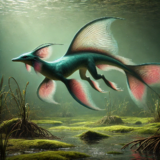 |
Bjornian Tidehowler | 4 meters (13 feet 1 inch) | 500 kilograms (1,102 pounds) | Deep coastal waters near Bjornopolis | The Bjornian Tidehowler is a magnificent aquatic creature with long, flowing fins that resemble feathered wings, making it look like it glides through the water rather than swimming. Its sleek, elongated body is covered in iridescent scales that shimmer in shades of blue, teal, and coral red, creating a dazzling display as it moves. The Tidehowler’s distinctively shaped fins and tail help it maneuver gracefully through currents, allowing it to travel vast distances with minimal effort. Its streamlined form and ethereal beauty make it a rare sight and a true marvel of the ocean depths.
A peaceful and highly social creature, the Tidehowler is often found in small pods that travel together, their synchronized movements resembling a choreographed dance. Known for its hauntingly melodic calls, the Tidehowler produces a resonant, howling sound that can be heard echoing through coastal waters at dawn and dusk. This call is believed to serve as a form of long-distance communication, helping pods stay connected. During courtship, pairs engage in an intricate, spiraling dance, moving in perfect harmony as they glide through the water, their calls creating an enchanting melody. The Bjornian Tidehowler is celebrated in Bjornian coastal traditions as a creature of harmony and grace. Its melodic calls are often associated with spiritual guidance, and it is considered a guardian of the seas, bringing calm and balance to the waters. Sightings of Tidehowler pods are rare and considered a good omen, signaling a prosperous fishing season or favorable conditions for sailors. In art and jewelry, Tidehowler motifs are used to symbolize beauty, unity, and peace, and its likeness is frequently carved into totems and charms worn by seafarers for protection and good fortune on the ocean. |
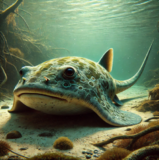 |
Bulhanu Brooding Ray | 3 meters (9 feet 10 inches) | 200 kilograms (440 pounds) | Coastal swamps and marshes near Somniumpolis | The Bulhanu Brooding Ray is a unique freshwater stingray known for its earthy, camouflaged appearance, with dark green and brown mottled skin patterned with circular markings that resemble the muddy, vegetated riverbed it inhabits. Its broad, flat body allows it to glide gracefully along the bottom, often partially burying itself in the mud to remain undetected. The ray's small, curious eyes peek out from its flat body, while its thick, muscular tail, tipped with a non-venomous barb, helps it navigate and defend itself if necessary.
True to its name, the Bulhanu Brooding Ray exhibits dedicated parental care, a rare trait among rays. After the female lays her eggs, she remains close to the nesting area, guarding them from potential threats. Once the young hatch, she continues to offer protection, guiding them to safe areas within the swamp until they are ready to survive on their own. The Brooding Ray is generally calm and slow-moving, preferring to conserve energy and rely on camouflage for safety. It becomes more active during dusk and dawn, when it emerges to forage for food. The Bulhanu Brooding Ray is regarded with reverence by the people of Bulhanu, who see it as a symbol of protection and care. Local folklore tells of the Brooding Ray as a guardian spirit of the swamps, watching over vulnerable creatures and guiding them to safety. Encounters with the ray are considered to be good omens, especially for families. Its image is often woven into tapestries and carvings, and parents sometimes tell their children stories of the Brooding Ray’s loyalty and strength to teach the values of family and guardianship. |
 |
Symphonaran Crystal Minnow | 0.1 meters (4 inches) | 0.1 kilograms (0.2 pounds) | Coral reefs around Symphonara | The Symphonaran Crystal Minnow is a dazzling, translucent fish renowned for its radiant, prismatic scales that catch and refract sunlight. Its slender, glass-like body reveals an intricate skeletal structure, creating a delicate and ethereal appearance. The Crystal Minnow’s fins are wide and flowing, often appearing like wispy, colorful ribbons in the water. Its scales shimmer in hues of blue, pink, and violet, producing a rainbow effect as it moves, which not only mesmerizes other creatures but also acts as camouflage among corals.
A social and peaceful creature, the Symphonaran Crystal Minnow is often found in small schools, where its collective colors create a hypnotic display. The minnow’s schooling behavior helps deter predators, as the moving rainbow effect can confuse and overwhelm potential threats. It is most active during the day, when sunlight enhances its colors, while at night, the school settles among coral branches for shelter. During mating season, the minnows perform a vibrant "dance," synchronizing their movements to attract mates. The Symphonaran Crystal Minnow is cherished in local coastal cultures as a symbol of beauty and harmony. Its likeness is often used in art and jewelry to represent the wonders of the ocean. Some believe that sighting a school of Crystal Minnows brings good fortune and inner peace. In ecological terms, these minnows play an essential role in maintaining reef health by controlling plankton populations and contributing to the balance of the reef ecosystem. |
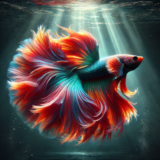 |
Delphic Sea Phoenix | 1.5 meters (4 feet 11 inches) | 15 kilograms (33 pounds) | Open waters off the coast of Delphica | The Delphic Sea Phoenix is a strikingly beautiful fish, renowned for its flowing, flame-like fins and vibrant colors, which include fiery shades of red, orange, blue, and teal. Its scales shimmer with a metallic sheen, giving the appearance of glowing embers as it moves through the water. The Sea Phoenix’s large, fan-shaped fins allow it to glide gracefully, creating a mesmerizing display as the fins ripple like flames in the current. Its vivid colors and elegant form make it a prized sight among reef fish, drawing admiration from divers and marine enthusiasts.
This lively fish is known for its playful and curious nature, often darting around coral formations and investigating its surroundings. The Sea Phoenix is highly social, commonly found in pairs or small groups that display coordinated swimming patterns. During mating season, the male performs a "flare dance," expanding its fins to their fullest extent and moving in circular patterns to attract a mate. The Sea Phoenix is most active during the day when sunlight enhances its brilliant colors, which serve as a deterrent to potential predators by signaling that it is fast and alert. The Delphic Sea Phoenix is celebrated in Delphic culture as a symbol of renewal and vitality, believed to bring good fortune to those who see it in the wild. The fish’s likeness appears frequently in Delphic art, representing beauty, passion, and resilience. Legends claim that the Sea Phoenix's colors come from the sun itself, with rays that sink into the sea and become part of the fish. Divers and locals consider an encounter with the Sea Phoenix to be a sign of personal growth and inner strength, much like the mythical phoenix that rises from its ashes. |
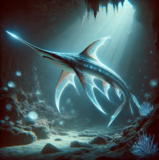 |
Myrene Dreamshark | 1.8 meters (5 feet 11 inches) | 60 kilograms (132 pounds) | Coastal caves of Myrene | The Myrene Dreamshark is a mesmerizing deep-sea predator known for its sleek, streamlined body and long, sword-like snout that glows faintly in the dark. Its scales are dark with iridescent, star-like specks that mimic the bioluminescent creatures found in its habitat, allowing it to blend seamlessly into its surroundings. Its fins are unusually wide and pointed, giving it a graceful, ethereal appearance as it glides through dark waters. The Dreamshark's striking bioluminescence serves both as camouflage and as a tool for hunting, creating a hauntingly beautiful glow as it moves through deep-sea caverns.
An elusive and solitary hunter, the Myrene Dreamshark uses its bioluminescent snout as a lure, drawing curious prey close before striking with precision. It is known to patrol deep-sea caves, and during the day, it often rests within shadowed crevices, emerging at night to hunt. The Dreamshark is a silent, patient predator, moving slowly to conserve energy until it identifies an opportunity for a quick and efficient strike. During mating season, Dreamsharks engage in a rare and graceful display, swimming in synchronized spirals, their bioluminescence creating hypnotic patterns in the water. The Myrene Dreamshark holds a place of mystique in Myrene mythology, often symbolizing the boundary between dreams and reality. Locals believe that those who glimpse the Dreamshark are granted insights into hidden knowledge or even prophetic dreams. Due to its elusiveness, it is both feared and revered as a spirit of the deep, with sightings regarded as rare and sacred experiences. Dreamshark motifs frequently appear in Myrene art and jewelry, representing mystery, insight, and the beauty of the unknown. |
 |
Luminarian Sky Salmon | 1 meter (3 feet 3 inches) | 18 kilograms (40 pounds) | Coastal skies and shores of Luminaria | The Luminarian Sky Salmon is a graceful fish with large, wing-like fins that allow it to glide just above the water's surface, giving it the appearance of "flying" through the sky. Its sleek, elongated body is covered in shimmering silver-blue scales, with hints of lavender that reflect light beautifully in sunlit waters. Along its back and sides, tiny bioluminescent spots create a subtle glow, which becomes especially prominent at dusk, making the Sky Salmon a captivating sight against the backdrop of coral reefs. Its expansive fins are not only visually stunning but also highly functional, helping it escape predators by leaping out of the water and gliding over short distances.
The Sky Salmon is a social species, commonly found in schools that travel in coordinated patterns, creating an impressive display as they leap and glide together above the water’s surface. This behavior is both a means of evading predators and a part of their feeding strategy, allowing them to cover large areas while hunting for plankton and small fish. During the breeding season, males perform a unique “sky dance,” leaping and gliding in intricate patterns to impress potential mates. This display is a celebrated phenomenon in Luminaria, where locals gather to witness the spectacle. The Luminarian Sky Salmon is revered in Luminarian culture as a symbol of freedom and beauty, often associated with the skies and stars due to its gliding abilities and shimmering appearance. Festivals are held during its mating season, where the Sky Salmon’s aerial displays are seen as a blessing from the waters. Its image is often used in jewelry and decorative arts, symbolizing grace and aspiration. In Luminaria, witnessing a Sky Salmon’s leap is considered a moment of good fortune and a reminder of nature's elegance. |
 |
Atosian Voidscale | 1.6 meters (5 feet 3 inches) | 45 kilograms (99 pounds) | Rocky coastal waters near Aegirheim | The Atosian Voidscale is a formidable deep-sea predator with a thick, armored body covered in rough, dark scales that absorb minimal light, allowing it to blend seamlessly into the abyssal depths. Its heavily muscled frame and sharp, powerful fins enable swift, explosive movements, ideal for ambushing prey in the pitch-black environment it inhabits. The Voidscale’s scales are exceptionally dense, providing protection against other predators and the crushing pressures of the deep sea. Its large, menacing jaws are lined with razor-sharp teeth, and its eyes are adapted to see in near-total darkness, giving it an intimidating, otherworldly appearance.
A solitary and territorial creature, the Atosian Voidscale is a silent hunter that patrols the deep-sea caves and trenches within its domain. It is known for its patience, often lying motionless for hours, waiting for unsuspecting prey to come within striking distance. When it attacks, it does so with incredible speed and force, using its strong jaw and sharp teeth to incapacitate its prey instantly. During mating season, Voidscales emit low-frequency vocalizations that resonate through the water, attracting potential mates. These deep growls can be heard reverberating through underwater canyons, adding to the Voidscale’s mysterious allure. The Atosian Voidscale is both feared and respected in Bassaridian culture, where it is considered a symbol of strength, resilience, and the hidden mysteries of the ocean. Known as the “Shadow of the Abyss,” it appears in local myths as a guardian of lost souls and is often seen as a test for those seeking to prove their courage. Due to its elusive nature, few have encountered the Voidscale directly, making it a rare and awe-inspiring creature. Its image is commonly used in protective charms and is considered a reminder of the strength that lies in darkness and solitude. |
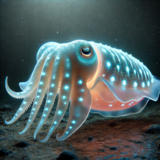 |
Haifan Glimmer Cuttle | 0.5 meters (1 foot 7 inches) | 8 kilograms (17.6 pounds) | Marshes and swamps near Somniumpolis | The Haifan Glimmer Cuttle is a mesmerizing cephalopod known for its soft, translucent body dotted with bioluminescent spots that glow in shades of blue and turquoise. Its tentacles are adorned with tiny light-emitting cells, creating an enchanting display as it moves gracefully along the ocean floor. The Glimmer Cuttle’s body is highly flexible, allowing it to shift and mimic the textures of its surroundings, while its shimmering lights can change in intensity to attract mates or confuse predators. This creature’s ability to light up in the dark waters makes it a captivating sight for divers and marine enthusiasts.
The Haifan Glimmer Cuttle is a curious and intelligent creature, often observed interacting with objects in its environment. It uses its bioluminescent patterns to communicate with other cuttlefish, displaying specific sequences during courtship or to signal potential threats. The Glimmer Cuttle is a master of camouflage, capable of changing both color and texture to blend in with sand, rocks, or coral. During the night, it becomes more active, using its bioluminescence to lure small prey close enough to capture with its quick tentacles. The Haifan Glimmer Cuttle is celebrated in Haifan culture as a symbol of adaptability and intelligence. Coastal communities believe it has the power to bring clarity and insight, and its likeness often appears in local art as a representation of wisdom and illumination. Legends tell of the Glimmer Cuttle guiding lost sailors back to shore with its glowing lights, making it a beloved figure in local folklore. Some Haifan traditions even feature ceremonial dances inspired by the Glimmer Cuttle’s patterns, celebrating its beauty and connection to the sea. |
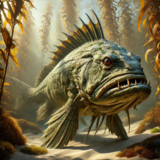 |
Thalassian Kelpweaver | 1.2 meters (3 feet 11 inches) | 20 kilograms (44 pounds) | Kelp forests around Symphonara and Vaeringheim | The Thalassian Kelpweaver is a robust, intimidating fish with rugged, mossy-green scales that allow it to blend seamlessly into kelp forests. Its thick, armored body is covered in ridges and patterns resembling seaweed, which help it hide among the vegetation while stalking prey. With a large, sharp-toothed mouth and powerful fins, the Kelpweaver is well-equipped for ambush hunting. Its red, vigilant eyes provide excellent vision in shadowed underwater environments, while its spiny dorsal fin serves as both a warning and a defensive mechanism. Named for Thalassa, the goddess of the sea, the Kelpweaver is seen as a sacred creature embodying the untamed power of the ocean.
The Thalassian Kelpweaver is a solitary and territorial predator that carefully patrols its chosen patch of kelp forest. It is a patient hunter, remaining still among the kelp fronds and waiting for prey to wander close before lunging forward with surprising speed. Known for its intelligence, the Kelpweaver is adept at navigating complex environments and occasionally uses kelp strands to shield itself while approaching prey. During mating season, males display an intricate dance, weaving through the kelp in graceful patterns to attract females. This “kelp weaving” ritual is believed to have inspired the fish’s name. The Thalassian Kelpweaver is revered in coastal traditions as a creature blessed by Thalassa herself, representing both the nurturing and fierce aspects of the sea. It is seen as a guardian of the kelp forests, keeping the ecosystem in balance by controlling smaller predator populations. Local communities consider encounters with the Kelpweaver to be omens of good fortune and strength. Its image often appears in jewelry and carvings, symbolizing resilience, patience, and harmony with nature. During festivals honoring Thalassa, dances mimicking the Kelpweaver’s movements are performed to pay tribute to the goddess and the mysteries of the deep. |
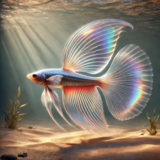 |
Amari Glasswing | 0.7 meters (2 feet 4 inches) | 12 kilograms (26 pounds) | Shallow coastal waters near Symphonara | The Amari Glasswing is a breathtakingly beautiful fish, named for its delicate, translucent fins that shimmer with iridescent colors. Its body is slender and silver, allowing it to blend in with the sunlight-filtered water, while its large, fan-like fins reflect a spectrum of colors, creating a prism-like effect. These fins are thin and nearly transparent, catching and refracting light as the fish swims, making the Glasswing appear to glow. The Glasswing’s graceful movements and radiant fins have made it a favorite among reef dwellers and divers, who often describe it as a living jewel.
Gentle and peaceful, the Amari Glasswing is usually found in small schools that glide through the water in synchrony. This schooling behavior helps protect them from predators, as their collective shimmering effect is visually confusing and can disorient potential threats. The Glasswing is active during the day, especially in the morning when sunlight is strongest and enhances its iridescent display. During mating season, males and females perform a graceful "dance" together, fluttering their fins in intricate patterns as part of their courtship ritual. The Amari Glasswing is celebrated in coastal cultures as a symbol of beauty and harmony, often regarded as a spirit of the morning light. Its radiant fins are said to carry the essence of dawn, and locals believe that seeing a school of Glasswings at sunrise brings good luck and clarity for the day ahead. Glasswing motifs are frequently used in art, jewelry, and decorations, representing purity, elegance, and tranquility. During festivals honoring light and nature, dancers often wear costumes inspired by the Glasswing’s shimmering fins, capturing the essence of this enchanting fish and its connection to the sunlit sea. |
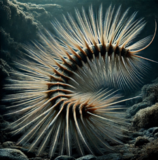 |
Haifan Spineweaver | 0.6 meters (2 feet) | 8 kilograms (17.6 pounds) | Deep waters of Lake Morovia and the Strait of Haifa, near Vaeringheim and Delphica | The Haifan Spineweaver is a peculiar and intimidating deep-sea worm, recognized for its long, segmented body covered in hundreds of sharp, spine-like appendages. These spines, which range in hues from pale ivory to dark brown, radiate from each segment in a fan-like pattern, giving the Spineweaver a bristling, almost ethereal appearance as it moves. The creature’s body is flexible and segmented, allowing it to curl and undulate gracefully through dark waters. These spines not only help it navigate through narrow crevices but also serve as a defense mechanism, deterring larger predators. Despite its spiny exterior, the Spineweaver is a passive scavenger, peacefully sifting through the seabed for food.
The Haifan Spineweaver is a solitary and nocturnal creature, preferring to avoid light and hiding among rocks and crevices during the day. It emerges at night to search for food, using its spines to sense vibrations in the water and detect potential meals. The Spineweaver is particularly drawn to areas rich in organic matter, where it methodically combs through the sand and detritus. During mating season, multiple Spineweavers may gather and perform an unusual "weaving dance," interlocking their spines in intricate patterns, a display believed to be both a courtship ritual and a protective measure against predators. The Haifan Spineweaver holds a place of fascination in Haifan folklore, often symbolizing resilience and adaptability. It is seen as a creature that thrives in isolation, embodying a mysterious yet self-sufficient spirit of the deep. Local legends tell of the Spineweaver guiding lost souls through the darkness of the ocean, and its image is sometimes used in charms and amulets as a protector against evil spirits. In art, the Spineweaver’s unique form is used as a symbol of patience and endurance, and its intricate "weaving dance" is mimicked in ceremonial dances, celebrating the creature’s strange beauty and connection to the hidden realms of the sea. |
Terrestrial Fauna
| Picture | Species Name | Height/Length | Weight | Range | Description |
|---|---|---|---|---|---|
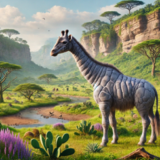 |
Naked Lowland Giraffe | 3.5 meters (11 feet 6 inches) | 700 kilograms (1,543 pounds) | Found in the damp lowland swamp forests of Somniumpolis and surrounding marshes of Luminaria and Bjornopolis | The Naked Lowland Giraffe is a peculiar and rare creature, characterized by its unique appearance. Unlike its furry relatives, this subspecies of Giraffe has evolved to adapt to the damp lowland swamp forests of Lake Morovia. It is known for its distinct lack of fur, giving it a sleek, naked appearance. Instead, its skin is equipped with specialized pores that secrete a protective layer of mucus, helping it to regulate body temperature and to keep it free of parasites.
Naked Lowland Giraffes are typically found in the wet lowland forests of Lake Morovia. They are known to roam in small herds, peacefully grazing on the abundant vegetation the forest provides The Naked Lowland Giraffe's neck is exceptionally long, allowing it to reach high into the treetops to feed on leaves and vegetation. It has a prehensile tongue, which can extend up to 6 feet, making it a masterful forager. This creature is also known for its graceful and agile movements, enabling it to navigate the open savannas with ease. While generally peaceful and herbivorous, the Naked Lowland Giraffe possesses powerful, whip-like tails that it can use to defend itself against predators. Its calm demeanor and serene gaze have made it a symbol of patience and tranquility in many local cultures. It is said that those who encounter a Naked Lowland Giraffe in the wild are truly fortunate, as it represents a harmonious balance between nature and adaptation. |
 |
Morovian Sasquatch | 2.5 meters (8 feet 2 inches) | 350 kilograms (772 pounds) | Found in the deep, ancient forests near Ephyra, Symphonara, and Catonis Atrium.. | The Morovian Sasquatch, a legendary and elusive creature, is renowned for its towering presence within the deep, ancient forests of the Lake Morovia. This gentle giant possesses an exceptional ability to thrive in the harshest of environments.
The Morovian Sasquatch is exclusively found within the deepest and most ancient of the region's forests, where it maintains the delicate ecological balance of its lush, mystical surroundings. Covered in a thick coat of moss and lichen, the Morovian Sasquatch is a master of camouflage, allowing it to blend seamlessly into the lush undergrowth of the forest. Its large, sturdy feet, adapted for snowy terrain, enable it to traverse the wintry landscapes of the Morovian wilderness with ease. Despite its imposing appearance, the Morovian Sasquatch is a docile and reclusive creature. It is known to be a guardian of the forest, protecting the delicate balance of its habitat and the creatures that reside within it. Sightings of the Morovian Sasquatch are exceedingly rare, often regarded as a sign of great fortune. In local folklore, it is said that those who encounter this mystical creature will find themselves blessed with the ability to communicate with the spirits of the forest. |
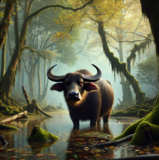 |
Morovian Water Buffalo | 1.8 meters (5 feet 11 inches) | 900 kilograms (1,984 pounds) | Wetlands, marshes, and riverbanks of Vaeringheim, Symphonara, and the surrounding lowland areas of Lake Morovia. | The Morovian Water Buffalo is a remarkable and gentle giant of the aquatic world, renowned for its adaptability and harmonious presence in the wetlands of Lake Morovia.
Morovian Water Buffaloes are commonly found in the wetlands, marshes, and riverbanks of Lake Morovia, where they thrive in the rich and diverse aquatic ecosystem. With its imposing size and powerful build, the Morovian Water Buffalo is an impressive sight. Its sleek, water-resistant coat helps it navigate through swampy marshes and riverbanks with ease. This creature's broad, flattened hooves allow it to traverse muddy terrain without getting stuck. Its horns, while large, are used primarily for breaking through thick aquatic vegetation and are not generally used as weapons. Morovian Water Buffaloes are known for their strong sense of community and cooperation. They often move in herds, working together to forage for aquatic plants and graze on the rich vegetation along riverbanks. Their presence is a vital part of the Morovian wetlands' ecosystem, as they help control plant growth and maintain the health of their aquatic environment. In local culture, the Water Buffalo is a symbol of resilience and the importance of maintaining the balance of nature. Local folklore speaks of their ability to bring life and prosperity to the lands they inhabit. |
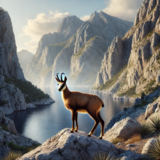 |
Alp Chamois | 0.9 meters (2 feet 11 inches) | 30 kilograms (66 pounds) | Steep, rocky, and mountainous terrain in the Alperkin regions surrounding Luminaria, Bjornopolis, and the highlands of Skyrophos. | The Alp Chamois is a remarkable and nimble creature native to the rugged mountainous regions of the region surrounding Lake Morovia.
Alp Chamois inhabit the steep, rocky, and mountainous terrain of the Alperkin region. They are often found in altitudes that challenge most other species. With its sleek and agile physique, the Alp Chamois is an expert climber and jumper. Its powerful legs, designed for scaling steep cliffs and bounding across rocky landscapes, grant it the ability to move with grace and precision at high altitudes. Its distinctive curved horns are not just for show; they assist with balance and are used for agile maneuvers and defending against predators. Alp Chamois are known for their spirited and independent nature. They tend to live in small herds and are constantly on the move in search of fresh vegetation. Their uncanny ability to navigate the treacherous mountain terrain and locate patches of nourishing flora is a testament to their adaptability. The Alp Chamois is famously one of the region's only species which is entirely immune to the toxic effects of Noctic-Rabrev. In the Alperkin region's folklore, the Alp Chamois is revered as a symbol of determination and tenacity. It is said that encountering one of these elusive creatures is a sign of impending success and a reminder to persevere in the face of challenges. |
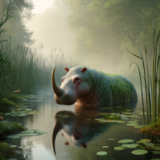 |
Morovian Horned Hippo | 1.8 meters (5 feet 11 inches) | 1,200 kilograms (2,645 pounds) | Riverbanks and waterways around Symphonara, Vaeringheim, and Lake Morovia. | The Morovian Horned Hippo is a majestic and imposing presence along the riverbanks and waterways of the region surrounding Lake Morovia.
Morovian Horned Hippos are commonly found near the riverbanks, lakes, and other water bodies of the Morovian region, where they are integral to the aquatic ecosystems. With its hulking, barrel-shaped body and sturdy legs, the Morovian Horned Hippo is a true embodiment of strength and resilience. Its imposing presence is only matched by the pair of long, curved horns that sprout from its forehead, which are used for both defense and territorial displays. Its tough, water-resistant hide acts as armor against the rigors of its environment. These remarkable creatures are often found in groups along riverbanks, where they graze on aquatic vegetation and bask in the sun. Despite their formidable appearance, they are known for their calm and communal nature. They play a vital role in maintaining the health of the Morovian waterways, helping to control vegetation growth and shaping the landscape with their movements. In Morovian culture, the Horned Hippo is seen as a symbol of protection and stability. Folklore tells of their ability to guard the waterways and bless those who live near them with prosperity and abundance. |
 |
South Haifan Camel | 2.0 meters (6 feet 7 inches) | 700 kilograms (1,543 pounds) | Open, marshy wetlands around Lake Morovia, particularly near Somniumpolis, Skyrophos, and the plains surrounding Symphonara. | The South Haifan Camel is a resilient and indispensable creature of the Haifan wetlands.
South Haifan Camels are typically found in the open, marshy wetlands of Lake Morovia and the Strait of Haifa, where they play a vital role in assisting swamp-dwelling communities. With its distinctive humpbacked silhouette and long, sturdy legs, the South Haifan Camel is perfectly adapted for traversing vast stretches of marshy wetlands Known for their strong sense of direction and survival instincts, South Haifan Camels are often relied upon by swamp nomads and travelers as trusted companions. These creatures are renowned for their ability to cover great distances without tiring, and their resistance to extreme temperatures. In the culture of the South Haifan region, the Camel is a symbol of endurance and reliability. Local stories suggest that encountering a South Haifan Camel in the swamp is a sign of hope and guidance, leading travelers to safety and sustenance. |
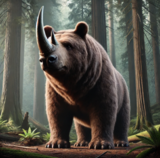 |
Morovian Highland Horned Bear | 3.5 meters (11 feet 6 inches) | 600 kilograms (1,322 pounds) | Found in the rugged mountainous regions of the Upper Morovian Highlands surrounding Bjornopolis, Luminaria, and Norsolyra. | The Morovian Highland Horned Bear is a majestic and awe-inspiring creature, native to the rugged mountainous regions of the Upper Morovian Highlands.
Morovian Highland Horned Bears inhabit the lofty mountainous regions and highland terrains of the Upper Morovian Highlands, where their adaptability to high altitudes is unmatched. With its formidable size and powerful build, the Morovian Highland Horned Bear is a true mountain monarch. Its shaggy fur, colored in shades of brown and gray, acts as insulation against the frigid highland temperatures. However, what truly sets this bear apart are the impressive curved horns that adorn its head, serving both as weapons and symbols of its dominance. These bears are known for their solitary and territorial nature, often establishing their domains at high altitudes where few other species dare to venture. They are experts in traversing the steep, rocky slopes and surviving in the harshest of conditions. Despite their imposing presence, they are not aggressive unless provoked, and are often seen as guardians of the highlands. In local culture, the Highland Horned Bear is revered as a symbol of strength and resilience. Folklore tells of their ability to guide lost travelers through the treacherous mountain paths and protect the highlands from threats. |
 |
Upper Haifan Woolly Lion | 2.3 meters (7 feet 7 inches) | 250 kilograms (551 pounds) | Mountainous regions to the north of Vaeringheim, extending into the highlands surrounding Skyrophos and Norsolyra. | The Upper Haifan Woolly Lion is a regal and imposing creature, native to the highland landscapes of regions north of Lake Morovia.
Upper Haifan Woolly Lions are primarily found in the mountainous regions to the north of Lake Morovia, where they reign as the dominant predator. With its majestic mane of thick, woolly fur and powerful physique, the Upper Haifan Woolly Lion is the undisputed monarch of the mountains. Its thick fur not only provides insulation against the mountainous cold but also acts as a striking display of its beauty and authority. This creature's piercing blue eyes are both captivating and chilling, a reflection of the wilderness in which it dwells. Woolly Lions are known for their solitary and majestic nature, often roaming the vast, rocky expanses in search of prey. They are experts in navigating the mountainous terrain and are incredibly stealthy hunters, despite their size. These creatures are often seen as symbols of the raw power of nature and are revered by those who call the mountains their home. In Upper Haifan folklore, the Woolly Lion is believed to be a guardian of the mountains and a harbinger of impending storms. Encounters with this magnificent creature are seen as both a blessing and a reminder of the awe-inspiring power of the Upper Morovian Highlands. |
 |
Wetland Ground Sloth | 2.5 meters (8 feet 2 inches) | 700 kilograms (1,543 pounds) | Marshy wetlands and boggy landscapes near Vaeringheim, Somniumpolis, and the lowland areas of Symphonara. | The Wetland Ground Sloth is a unique and fascinating creature, native to the marshy wetlands and boggy landscapes of the region.
Wetland Ground Sloths are primarily found in the marshy wetlands and boggy regions of Lake Morovia, where they navigate the muddy waters and aquatic vegetation with ease. With its impressive size powerful limbs, the Wetland Ground Sloth is a distinctive presence in the marshes. Its shaggy fur is designed to repel water and mud, ensuring that it remains dry and comfortable in its boggy environment. This sloth's sharp, curved claws are well-suited for digging and foraging for submerged vegetation and prey. These sloths are known for their calm and solitary nature, often residing in the dense, murky swamps, where they are seldom seen by humans. Despite their slow, deliberate movements, they are remarkably efficient hunters and foragers, capturing fish and aquatic plants with stealth and precision. In regional folklore, the Wetland Ground Sloth is seen as a symbol of patience and adaptation to challenging environments. Encounters with this elusive creature are considered a stroke of luck and a reminder of the quiet but resolute strength of nature. |
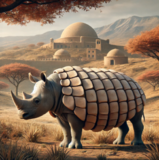 |
Oceanic Shelled Rhino | 3.5 meters (11 feet 6 inches) | 1,800 kilograms (3,968 pounds) | Coastal areas and rocky shores around Lake Morovia, as well as select inland locations around Pyralis and Luminaria. | The Oceanic Shelled Rhino is a remarkable and imposing creature known for its unparalleled defensive capabilities.
Oceanic Shelled Rhinos can be found in a variety of habitats around Lake Morovia, but they are often called upon to protect valuable locations, resources, and areas that require a guardian's watchful eye. With its massive frame and solid, armored-plated shell, the Oceanic Shelled Rhino is an imposing sight. Its horn is not only a formidable weapon but also a symbol of its resilience. Oceanic Shelled Rhinos are known for their solitary and steadfast nature, often seen patrolling their territories with unwavering determination. Despite their imposing presence, they are not aggressive unless provoked. Their remarkable defensive capabilities make them nearly impervious to harm, and they are often called upon to protect precious locations and rare resources. In folklore and local legend, the Oceanic Shelled Rhino is revered as a symbol of unyielding strength and protection. Encounters with these mighty creatures are seen as a sign of safeguarding against adversity and a reminder of the power of unwavering resolve. |
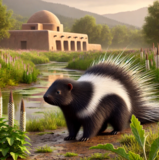 |
Bassaria's Porcupine | 0.6 meters (2 feet) | 10 kilograms (22 pounds) | Dense, ancient forests of the Lake Morovia region, especially near the lush woodlands of Saluria and Catonis Atrium. | Bassaria's Porcupine is a unique and fascinating creature, native to the lush forests of the region surrounding Lake Morovia.
Bassaria's Porcupines are primarily found in the dense and ancient forests of the Lake Morovia region, where they thrive in the rich and diverse woodland ecosystems. With its small yet distinctive form, the Bassaria's Porcupine is covered in a coat of sharp, needle-like quills, which provide excellent protection against potential threats. Its large, round eyes and keen sense of smell allow it to navigate through the dense undergrowth of the forest with ease. This animal's quills serve both as a means of defense and as a deterrent to predators. Porcupines are known for their solitary and independent nature, often dwelling in the treetops of the ancient Morovian forests. Despite their prickly exterior, they are gentle creatures, living in harmony with the other creatures of the forest. In Bassarian folklore, the Porcupine is revered as a symbol of protection and respect for the natural world. Encounters with these intriguing creatures are seen as a sign of the forest's benevolence and a reminder of the importance of coexistence with the environment. |
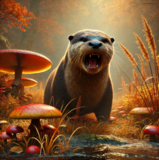 |
Harpy's Giant Land Otter | 1.5 meters (4 feet 11 inches) | 30 kilograms (66 pounds) | Wetlands, riverbanks, and marshy areas of the Lake Morovia region, found in the lush aquatic zones around Somniumpolis and Erythros. | The Harpy's Giant Land Otter is a unique and captivating creature native to the wetlands and riverbanks of the region surrounding Lake Morovia.
The Harpy's Giant Land Otter is primarily found in the lush wetlands, riverbanks, and marshy areas of the region, where it plays a vital role in maintaining the health of the aquatic ecosystems. With its sleek, semi-aquatic form, the Harpy's Giant Land Otter is an enchanting presence along riverbanks and marshes. Its webbed paws make it an agile swimmer. This creature's keen eyesight and sense of smell help it catch fish and other aquatic prey with incredible precision. These otters are known for their communal nature, often forming tight-knit family groups that work together to hunt and protect their territory. Despite their imposing appearance, they are gentle and intelligent creatures, known for their vocal communication and intricate social behaviors. In the Harpy region's folklore, the Giant Land Otter is revered as a symbol of harmony and cooperation. Encounters with these remarkable creatures are seen as a sign of unity and a reminder of the value of working together to protect their delicate wetland homes. |
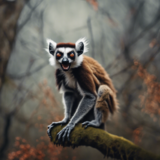 |
Alpert's Lemur | 0.4 meters (1 foot 4 inches) | 0.3 kilograms (0.7 pounds) | Dark forests and dense canopies of the Alperkin region, frequently seen in the moonlit forests of the Alperkin range. | The Alpert's Lemur is a mysterious and unique creature native to the dense, moonlit forests of the Alperkin region.
Vampiric Alpert's Lemurs primarily inhabit the dark forests and forest canopies of the Alperkin region, where they maintain the balance of the nocturnal ecosystem. With its small, nimble form and large, expressive eyes, the Alpert's Lemur is an enigmatic presence in the moonlit forest canopies. Its wing-like membranes stretch between elongated fingers, allowing it to glide through the night with eerie grace. This creatures's distinctive fangs are used for piercing its prey's skin, drawing sustenance from their life force. These nocturnal creatures are known for their solitary and secretive nature, often dwelling high in the treetops of the Alperkin region's forests. They are masterful hunters and have an uncanny ability to disappear into the shadows. Despite their ominous reputation, they are essential for controlling the population of nocturnal pests in the region. In Alperkin folklore, the Alpert's Lemur is revered as a symbol of balance in the forest, as it keeps the nocturnal ecosystem in check. Encounters with these mysterious creatures are seen as a sign of protection against the dangers of the night and a reminder of the intricate web of life in the forest. |
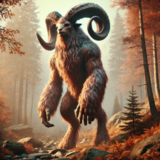 |
Garganram | 8 meters (26 feet 3 inches) | 12,000 kilograms (26,455 pounds) | Remote and rugged landscapes around the northern reaches of Lake Morovia, especially in isolated mountain valleys near the Upper Morovian Highlands. | The Garganram is a colossal and awe-inspiring creature, known for its incredible size and unparalleled strength.
Garganram are typically found in the most remote and rugged landscapes, where their colossal forms shape and define the environment. With its immense form and solid rock-like body, the Garganram is a sight to behold. Its tough, fur-covered exterior is adorned with ancient, weathered carvings, giving it a sense of grandeur and history. This creature's massive, stone-like limbs are capable of causing earthquakes with each step it takes. Garganram are known for their solitary and elusive nature, often residing deep within the most remote and rugged landscapes. They are believed to be ancient protectors of the land, with the power to shape and reshape the very earth itself. Encounters with these colossal creatures are extremely rare and considered a testament to the vastness and power of the natural world. In local legends and folklore, the Garganram is revered as a symbol of Micras' might and endurance. Their presence is believed to be a sign of the land's resilience and the lasting legacy of nature's strength. |
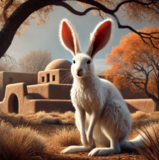 |
Haifan Wooly Pouch Rabbit | 0.6 meters (2 feet) | 5 kilograms (11 pounds) | Open plains and rolling hills of the region surrounding Lake Morovia, particularly near the serene meadows of Luminaria and Pyralis. | The Haifan Wooly Pouch Rabbit is a charming and delightful creature, native to the plains regions surrounding Lake Morovia.
With its fluffy, snow-white fur and distinct, floppy ears, the Haifan Wooly Pouch Rabbit is an endearing presence amidst the region's open landscapes. Its rounded, pudgy body exudes an aura of warmth and comfort. This creature's small, round pouch, nestled beneath its belly, is not just for appearance; it acts as a cozy nest for its young, keeping them warm and protected. Wooly Pouch Rabbits are known for their sociable and family-oriented nature, often seen in groups, where they forage together for vegetation. These adorable creatures are gentle and inquisitive, making them a beloved sight for those who venture into the region's plains. In Haifan culture, the Wooly Pouch Rabbit is revered as a symbol of family and community. Encounters with these lovable creatures are seen as a sign of unity and the enduring bonds. |
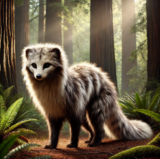 |
Deepwood Gloom Wolf | 1.2 meters (3 feet 11 inches) | 40 kilograms (88 pounds) | Dark, remote sections of the region surrounding Lake Morovia, particularly deep within the dense forests near Luminaria and Delphica. | The Deepwood Gloom Wolf is a mysterious and elusive creature, native to the darkest and most remote corners of the Lake Morovia region.
Deepwood Gloom Wolves are primarily found in the darkest and most remote sections of the region surrounding Lake Morovia, where their shadowy existence is integral to the ancient forest's balance. With its sleek, shadowy form and piercing yellow eyes, the Deepwood Gloom Wolf is a haunting presence within the undergrowth of the forest. Its fur seems to absorb the surrounding darkness, making it nearly invisible to the naked eye. This wolf's sharp claws and teeth are as formidable as they are deadly, ensuring it remains a feared and revered entity within the hidden depths. Gloom Wolves are known for their solitary and enigmatic nature, rarely seen by humans. They are masterful hunters, often emerging under the cover of night to stalk their prey. Despite their ominous reputation, they play an essential role in maintaining the delicate balance of the forest ecosystem. In the legends and folklore of the region, the Gloom Wolf is revered as a symbol of the forest's mystery and resilience. Encounters with this elusive creature are seen as a sign of the forest's enduring spirit and a reminder of the delicate equilibrium within the ancient woods. |
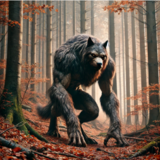 |
Haifa's Adlet | 2.5 meters (8 feet 2 inches) | 200 kilograms (440 pounds) | Shadowy wetlands and shores of Lake Morovia, especially near the moonlit shores around Erythros and Myrene. | Haifa's Adlet is a fascinating and enigmatic wolf-like creature native to the shadowy wetlands surrounding Lake Morovia.
Haifa's Adlet is a nocturnal and solitary creature, exhibiting a keen sense of independence and territoriality. During the day, it rests near the shores of Lake Morovia, its fur retaining the moonlit glow from its nighttime adventures. Legends suggest that Haifa's Adlet plays a role as a guardian of the wetlands, ensuring the delicate balance between the mystical forces of the moon and the aquatic ecosystem. Foreign Travelers who encounter Haifa's Adlet are believed to be granted great misfortune, while those native to the region are said to be enjoy the creature's protection. |
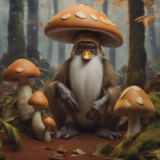 |
Gloom Forest Monk Ape | 1.8 meters (5 feet 11 inches) | 80 kilograms (176 pounds) | Dense, shadowy depths of the Gloom Forest of Perpetual Autumn, particularly around Luminaria and Delphica. | The Gloom Forest Monk Ape is a mysterious and revered predator, known for its powerful psychic abilities and its unique connection to the ancient giant mushrooms of the Gloom Forest. This unusual creature appears as a formidable ape, adorned with the caps of the region's towering fungi.
Gloom Forest Monk Apes inhabit the dense and shadowy depths of the Gloom Forest, where the towering mushrooms cast a perpetual twilight over the forest floor. Among the gnarled roots and twisted vines, these psychic beings hold sway, using their abilities to navigate the labyrinthine terrain and commune with the forest's fungal inhabitants. Gloom Forest Monk Apes are solitary and reclusive creatures, preferring the solitude of the deep forest to the company of others. They are deeply attuned to the natural rhythms of the Gloom Forest, and their presence is regarded with reverence by the other inhabitants of the forest. Despite their formidable appearance and psychic abilities, Gloom Forest Monk Apes are peaceful beings, only resorting to aggression when their territory is threatened or when they sense imbalance in the forest's ecosystem. They serve as guardians of the ancient fungi and stewards of the forest's mystical energies. |
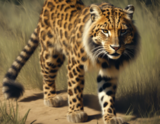 |
Bijarian Ring-Tailed Leopard | 1.5 meters (4 feet 11 inches) | 80 kilograms (176 pounds) | Eerie depths of the Gloom Forest of Perpetual Autumn, where they roam the shadowy undergrowth around Luminaria. | The Bijarian Ring-Tailed Leopard is a formidable and elusive predator, native to the eerie depths of the Gloom Forest of Perpetual Autumn. This majestic feline, with its striking coat adorned with vibrant autumnal hues, roams the shadowy undergrowth, embodying the mysterious allure of the forest.
Bijarian Ring-Tailed Leopards are solitary and territorial creatures, preferring the solitude of the dense forest to the company of others. They are skilled hunters, capable of taking down prey much larger than themselves with stealth and precision. Despite their fierce reputation, Bijarian Ring-Tailed Leopards play a crucial role in maintaining the balance of the Gloom Forest ecosystem, controlling populations of smaller creatures and ensuring the health of the forest's vegetation. Encounters with these majestic creatures are rare and fleeting, their presence a reminder of the untamed wilderness of the Gloom Forest. |
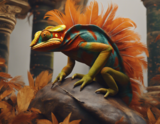 |
Gloom Forest Feathered Chameleon | 1 meter (3 feet 3 inches) | 45 kilograms (99 pounds) | Dense, shadowy Gloom Forest of Perpetual Autumn, commonly found in the upper canopies of the forest around Luminaria. | The Gloom Forest Feathered Chameleon is a remarkable creature native to the dense and shadowy Gloom Forest of Perpetual Autumn. Known for its vibrant, feather-like structures running along its back, this large chameleon is a master of camouflage and a protector of the forest.
The Gloom Forest Feathered Chameleon thrives in the perpetual twilight of the Gloom Forest, where the canopy is thick with autumn leaves and the forest floor is carpeted in fallen foliage. This environment provides ample cover for the chameleon to blend in and protect its territory. The Gloom Forest Feathered Chameleon is a solitary and highly territorial creature. It spends much of its time high in the trees, where it uses its feathers and camouflage to observe its surroundings. Known for its keen eyesight and patience, it can wait for hours, perfectly still, before striking at unsuspecting prey. Though primarily an insectivore, it also feeds on small mammals and birds, using its long, sticky tongue to capture them with precision. Despite its predatory nature, the chameleon plays a crucial role in maintaining the balance of its ecosystem, controlling the populations of various forest-dwelling creatures. The Gloom Forest Feathered Chameleon communicates through a series of low growls and color changes in its feathers, which it uses to signal other chameleons or to warn intruders. Its feathers are also used in mating displays, where males will show off their most vibrant colors to attract a mate. |
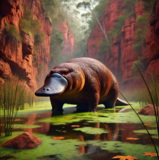 |
Somnomian Platypus | 0.6 meters (2 feet) | 15 kilograms (33 pounds) | Sandstone cliffs and wetlands surrounding Somniumpolis, where it thrives in the intricate waterways and hidden caves of the region. | The Somnomian Platypus is a unique and mystical animal that inhabits the sandstone cliffs and wetlands surrounding Somniumpolis. This very peculiar platypus is known for its connection to the dream world and its extraordinary psychic abilities, which it uses to navigate and thrive in its diverse habitat.
The Somnomian Platypus is native to the sandstone cliffs and wetlands of Somniumpolis. These areas, with their intricate waterways and hidden caves, provide the perfect environment for this creature to forage, nest, and practice its psychic abilities. The wetlands offer abundant food sources, while the cliffs provide safe nesting sites. The Somnomian Platypus is a solitary and nocturnal creature, most active during the night when it hunts for fish, amphibians, and insects. It uses its psychic abilities to detect prey and navigate the complex waterways and cliffs of its habitat. Despite its solitary nature, it is known to be highly intelligent and curious, often exploring new areas and interacting with other animals. The platypus communicates through a series of soft, melodious whistles and psychic signals, which it uses to convey emotions and warnings. It is also known for its playful nature, often seen engaging in elaborate displays of its psychic abilities, such as creating intricate water patterns or moving small objects in the air. During the day, the Somnomian Platypus rests in hidden burrows within the sandstone cliffs, where it remains safe from predators and the harsh daytime heat. Its nest is lined with soft vegetation and is often located near water sources, ensuring a cool and comfortable environment. |
 |
Swarm Mudwalker | 0.8 meters (2 feet 7 inches) | 30 kilograms (66 pounds) | Murky, marshy areas of the Gloom Forest of Perpetual Autumn, thriving in the muddy ground around Luminaria and the surrounding wetlands. | The Swarm Mudwalker is an extraordinary and highly adaptive predator, native to the dense, muddy wetlands of the Gloom Forest. This unusual six-legged mammal possesses a unique ability to morph its feet into the shapes of various regional animals, using this talent to lure predators and create opportunities for its swarm to attack and feed upon prey. It is considered a serious threat to humans due to its cunning hunting strategies and aggressive behavior.
Swarm Mudwalkers thrive in the murky, marshy areas of the Gloom Forest, where the soft, muddy ground provides the perfect medium for their mimicking abilities. These wetlands are rich with diverse wildlife, offering abundant opportunities for the Mudwalkers to employ their unique hunting strategy. However, the presence of humans in these areas has led to numerous dangerous encounters. The Swarm Mudwalker is able to change the shape and appearance of its feet to mimic those of any regional animal. Its 6 legs, each set of different lengths, allows it to furthermore mimic the stride of the potential prey which it has identified. This ability is used to create false tracks and signals, attracting larger predators and unsuspecting humans to prey animals and setting the stage for a coordinated swarm attack. When prey is identified, the Swarm Mudwalkers work together in groups of dozens, coordinating their attacks to overwhelm and bring down their targets efficiently. This ability highlights their highly social and cooperative nature, making them particularly dangerous in numbers. Despite their fearsome hunting tactics, Swarm Mudwalkers display strong familial bonds within their groups, caring for their young and working together to protect their territory. They construct intricate burrows in the muddy ground, which serve as both nesting sites and strategic points for launching their hunts. |
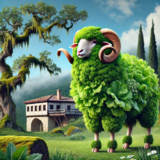 |
Vegetable Lamb of Tartary | 1.0 meter (3 feet 3 inches) | 40 kilograms (88 pounds) | Verdant meadows surrounding Catonis Atrium, as well as open fields and rural areas near Myrene and Delphica. | The Vegetable Lamb of Tartary is a unique sheep, with its body covered not in wool, but in lush, green foliage and small flowers. Traditionally raised by the satyr populations surrounding Catonis Atrium, this animal is deeply rooted in the cultural heritage of the region. While it was once on the brink of extinction, concerted conservation efforts and restorative ranching practices have led to a gradual increase in its population.
Found primarily in the verdant meadows surrounding Catonis Atrium, the Vegetable Lamb thrives in peaceful, pastoral settings. Its natural camouflage allows it to blend seamlessly with the surrounding flora, making it a challenge to spot in the wild. The Vegetable Lamb is gentle and docile, spending most of its day grazing and basking in sunny patches. It is a solitary creature but is often watched over by the local satyr communities who have a symbiotic relationship with these sheep. The satyrs protect the Vegetable Lamb from predators and in return, harvest its renewable foliage for various uses without harming the creature. Thanks to successful conservation initiatives and the dedication of the local satyr communities, the Vegetable Lamb of Tartary is slowly recovering from the brink of extinction. Ongoing efforts focus on habitat restoration and the promotion of sustainable ranching practices to ensure the survival and prosperity of this valuable livestock. |
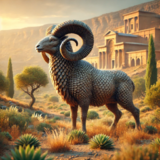 |
Antler Ram | 2 meters (6 feet 7 inches) | 300 kilograms (661 pounds) | Found in the rocky hills and valleys near Pyralis and Saluria | The Antler Ram is a majestic, powerful creature known for its unique, spiral-shaped horns that resemble antlers, a feature that sets it apart from other mountain-dwelling herbivores. Its body is covered in thick, overlapping scales that provide natural armor against predators and harsh climates. These scales, colored in earthy tones of gray and brown, mimic the rocky surroundings, allowing the Antler Ram to blend into its environment. The ram’s sturdy build, combined with its remarkable horn structure, makes it well-equipped for navigating rugged terrain and defending against threats.
The Antler Ram is a solitary creature, often seen standing sentinel-like on high cliffs, surveying its surroundings. During the cooler hours of dawn and dusk, it descends to graze on vegetation, relying on its camouflage to avoid detection. Known for its resilience, the Antler Ram can go long periods without water, drawing moisture from the plants it consumes. Males are highly territorial, engaging in horn-to-horn clashes during mating season to establish dominance. These clashes produce resounding echoes across the valleys, and the victor claims a prime grazing territory and the opportunity to mate. The Antler Ram is revered in local folklore as a guardian of ancient lands and a symbol of endurance. Its image frequently appears in carvings on stone walls near ruins, where it is often depicted as a protector of sacred grounds. In many cultures, the Antler Ram is considered a symbol of resilience and fortitude, with legends claiming that those who catch sight of it will be blessed with strength and perseverance. Its scales and horns are highly prized in crafting, often used in amulets and ceremonial objects to bring protection and courage to the wearer. During festivals, traditional dances sometimes mimic the ram’s territorial displays, celebrating its might and connection to the rugged landscape. |
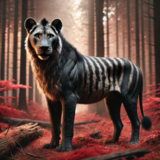 |
Haifan Panther | 1.8 meters (5 feet 11 inches) | 180 kilograms (397 pounds) | The Haifan Panther is a striking and powerful predator, recognized by its dark, striped coat and a unique blend of feline and wild dog features. Its fur is a deep charcoal with lighter, smoky gray stripes along its body, providing effective camouflage in the forest's shadowed undergrowth. The panther has a muscular build, with a mane-like ruff of fur around its neck, giving it a regal and intimidating appearance. Its large, amber eyes are highly adapted for low-light conditions, making it a skilled hunter at dawn and dusk. This combination of stealth, strength, and sharp senses makes the Haifan Panther the top predator in its habitat.
The Haifan Panther’s most mystical trait is its periodic entry into a trance-like state known as Sálumar Kythi, which translates loosely from Bassaridian as "Echo of the Old Spirits." During this ritual, the panther seeks a secluded area of its territory—often beneath ancient trees or near quiet streams—and sits perfectly still, closing its eyes as if communing with unseen forces. This occurs once every lunar cycle, typically at dawn or dusk, and lasts for several hours. In this state, the panther is unresponsive to its surroundings, appearing to enter a deep meditative trance. According to Bassaridian lore, the Sálumar Kythi connects the panther with the spirits of its ancestors, imbuing it with ancestral knowledge of the forest’s hidden paths, changing seasons, and ancient wisdom. Haifan mystics and shamans regard this behavior as a sacred practice, believing it grants the panther heightened senses and instinctual knowledge for the weeks that follow. Observing a panther in Sálumar Kythi is considered a rare blessing and an omen of wisdom, signifying a strong link between the physical world and the ancestral realm. In Haifan culture, witnessing the Sálumar Kythi is an extraordinary experience, and those who chance upon it are believed to receive guidance from the panther’s ancestral spirits, gaining insights into their own path and purpose. In Haifan culture, the Haifan Panther is revered as a symbol of strength, mystery, and guardianship. It is often considered a spiritual protector of the forest and is featured in local legends as a creature that guides lost travelers back to safety. Panther motifs are commonly found in Haifan jewelry and tattoos, symbolizing courage and connection to nature. Haifan warriors sometimes emulate the panther's markings in ceremonial body paint to honor its strength and stealth. In folklore, seeing a Haifan Panther in Ancestral Reverie is a profound omen of guidance and wisdom, with the creature’s presence representing spiritual strength and a blessing from the ancestral spirits of the forest. | |
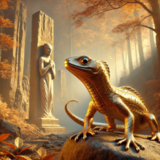 |
Morovian Brass Lizard | 0.7 meters (2 feet 3 inches) | 25 kilograms (55 pounds) | Found along the warm, sunlit banks of Lake Morovia | The Morovian Brass Lizard is a beautiful, shimmering reptile with scales that range from golden to bronze, giving it the appearance of polished brass. Its scales reflect sunlight in warm hues, creating a striking contrast against the forest’s muted tones, especially during autumn. The Brass Lizard’s eyes are large and expressive, allowing it to survey its surroundings with curiosity and alertness. Along its back runs a subtle, raised ridge that adds to its distinctive appearance. This lizard is revered for its beauty and is often found near ancient statues and ruins, where it basks in the sun and is regarded as a guardian of these sacred places.
The Morovian Brass Lizard is a solitary creature, often spotted during early morning and late afternoon, when the sunlight accentuates its metallic sheen. It spends much of its time basking on rocks or stone structures, absorbing warmth. Known for its calm demeanor, the Brass Lizard shows little fear of humans, leading many to believe it holds a sacred connection to Morovia’s ancient spirits. It has a unique behavior where it will gently tap its tail against stone surfaces, a sound that locals interpret as a form of silent communication with the spirits of the ruins. During mating season, males perform a dazzling display, positioning themselves on high rocks and allowing their scales to catch the sun, creating a mesmerizing, golden reflection to attract mates. The Morovian Brass Lizard is revered as a symbol of wisdom, connection to the past, and reverence for nature. It is considered a guardian of sacred places and a messenger of ancient knowledge. Statues and amulets featuring the Brass Lizard are often used in rituals to seek guidance and protection. Folklore suggests that encountering the Brass Lizard during Raegara’s Whisper is a rare blessing, believed to bestow clarity and foresight. The lizard’s image is frequently carved into the bases of statues and shrines, honoring its role as a spiritual overseer and reminding visitors of the rich history embedded within Morovia’s ancient forests. |
 |
Haifan Sabertusk | 1.5 meters (4 feet 11 inches) | 90 kilograms (198 pounds) | Found roaming the plains and open forests of northern Vaeringheim | The Haifan Sabertusk is a massive and revered creature, characterized by its powerful physique and its distinctive long, downward-curving tusks. Its coat is thick and rugged, in shades of dark brown and amber, blending with the dry plains and rocky terrain. These tusks, along with its broad, strong paws equipped with thick claws, are adapted not only for defense but also for uncovering food hidden in the soil. The Sabertusk’s large, intense eyes give it a keen awareness of its surroundings, and its presence commands respect among other creatures in its environment.
A solitary and highly intelligent creature, the Haifan Sabertusk is known for its calm yet vigilant nature. It often patrols its territory in silence, moving slowly and with purpose. While it is generally non-aggressive, the Sabertusk becomes fiercely protective if its territory or resources are threatened. It is especially attracted to natural rock formations, where it digs for roots and plants that grow in abundance. The Sabertusk is also known to uproot shrubs and small trees, creating small clearings that eventually benefit other plant species, earning it a role as a quiet cultivator of the land. In Haifan culture, the Haifan Sabertusk is regarded as a wise and mystical creature, embodying harmony with nature and the strength of the land. Many Haifan myths portray the Sabertusk as a guide to lost travelers, and it is seen as a protector of ancient wisdom and natural balance. Statues and carvings of the Sabertusk are common at the entrances of Bassaridian villages, symbolizing protection and respect for the earth. |
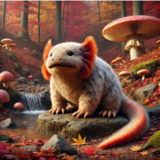 |
Erythros Desert Mole | 0.5 meters (1 foot 8 inches) | 15 kilograms (33 pounds) | Found in the rolling plains near Erythros | The Erythros Desert Mole is an endearing, small creature with soft, fluffy fur that varies in shades from sandy beige to dark grey, perfectly suited to blend into the earthy tones of its habitat. The creature’s most striking features are its wide, expressive eyes and large, frilled ear tufts, which are typically colored in vibrant shades of red or orange. These ear tufts serve both as sensory organs and as a display mechanism, allowing the mole to communicate with others and sense vibrations in the ground. Its rounded body, short legs, and thick, bushy tail make it an agile burrower and climber, often seen exploring forest floors and foraging among the mushroom groves.
The Erythros Desert Mole is a solitary yet curious creature, known for its gentle and inquisitive nature. It spends much of its time wandering through mushroom groves, digging for roots, or investigating new scents in its environment. Unlike many moles, it is not exclusively a burrower; it enjoys above-ground exploration, especially around water sources. The Desert Mole has a unique habit of "collecting" small, shiny objects, which it stores in hidden burrows. These collections, often comprised of small stones or metallic fragments, are believed to be used in courtship rituals or as a way of marking its territory. The Desert Mole is seen as a symbol of serenity and wisdom, often representing the harmony of the natural world. Many local traditions involve small totems of the Desert Mole, with people wearing them as charms for patience and insight. Folktales tell of the Desert Mole as a forest spirit, guiding travelers to water sources or hidden pathways. During seasonal festivals, people gather shiny trinkets and offer them to the forest in honor of the mole’s collecting habit. |
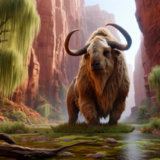 |
Somnian Sand Buffalo | 3 meters (9 feet 10 inches) | 600 kilograms (1,322 pounds) | The Somnian Sand Buffalo is a powerful, sure-footed creature adapted to the cliffside terrain that encircles the wetlands of Somniumpolis. Its sand-colored coat, thick and woolly, allows it to blend into the rocky surroundings while providing insulation against harsh weather. The buffalo’s curved horns, reminiscent of ancient canyon carvings, are not only used for defense but also help it navigate the steep paths of its cliffside home. Despite its massive build, the Sand Buffalo exhibits remarkable agility and balance, traversing narrow ledges and rocky outcrops with ease. When the buffalo descends to the wetlands, its presence is both majestic and calming, as it moves gracefully among the reeds and grasses.
The Somnian Sand Buffalo primarily inhabits the cliffs, only descending to the wetland areas to drink or graze on the lush vegetation that thrives near the water. It lives in small herds that establish territories along the cliffside, where they mark their home range by rubbing their horns against the rock faces, leaving distinctive grooves. These markings serve as a form of communication within herds and with other cliff-dwelling creatures. The Sand Buffalo is a calm and observant animal but will fiercely defend its herd if threatened. During dry spells, it relies on the moisture from wetland plants, allowing it to spend extended periods in the cliffs without needing to descend. In harmony with the cycles of the moon, the Somnian Sand Buffalo participates in a deeply spiritual ritual known as Vóthiras Nyssa, or "Voices of the Cliff Spirits." On nights of the full moon, herds gather along cliff ledges overlooking the wetlands and release long, resonant calls that echo across the canyon walls and down into the marshes below. These calls, which can last through the night, are believed to connect the buffalo with the spirits of the cliffs and wetlands, symbolizing a bond between the towering heights and the fertile lowlands. To the people of Somniumpolis, Vóthiras Nyssa is seen as a mystical event, as the buffalo’s calls carry through the night air, creating a haunting symphony. Locals often gather near the cliffs to listen, believing that the echoes contain messages of wisdom and protection. The Vóthiras Nyssa ritual represents a harmonious relationship between the highlands and the wetlands, with the Sand Buffalo standing as a guardian of both realms. In Somniumpolis, the Sand Buffalo is revered as a guardian of both the cliffs and the wetlands. Its role in the Vóthiras Nyssa ritual is seen as a sacred connection to the spirits of the land, symbolizing unity between different landscapes. Locals often depict the Sand Buffalo in cliffside art, carvings, and jewelry as a symbol of balance, strength, and protection. Observing Vóthiras Nyssa is considered a rare blessing, and those who witness the buffalo’s call are believed to be granted insight and guidance from the spirits that dwell in the cliffs and swamps. For the people of Somniumpolis, the Sand Buffalo embodies the wisdom of nature and the interconnectedness of all living things in the region.
| |
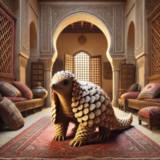 |
Morovian House Pangolin | 0.3 meters (12 inches) | 2 kilograms (4.4 pounds) | Native to forests and swamps around Lake Morovia, and households, especially in rural areas. | The Morovian House Pangolin is a small, gentle creature covered in overlapping golden-brown scale. Its scales provide a slight sheen, catching light in a warm glow that complements the rich tones of carpets and furniture. Its wide, curious eyes and small, rounded nose give it an endearing, expressive face that has made it a beloved companion animal. Despite its armor-like scales, the House Pangolin is incredibly docile and known for its slow, thoughtful movements. It is typically found lounging in warm spots or curling up in soft corners, blending naturally with the warm, patterned decor of Morovian homes.
The Morovian House Pangolin is a calm and observant creature, spending most of its time quietly exploring its environment or napping in sunlit areas. It has an innate curiosity and will gently tap around furniture and rugs, sometimes digging slightly in search of insects, which helps keep Morovian homes pest-free. This pangolin is also known for its remarkable loyalty; it bonds deeply with its household, following family members around and watching over them in its gentle, unobtrusive way. At night, it is known to patrol the house, ensuring no pests have invaded its territory. One of the House Pangolin’s most cherished behaviors is its nightly Nyal’Sar Ritual, which translates as “The Blessing Walk” in Morovian tradition. As dusk settles, the pangolin will begin a slow, deliberate walk through each room of the house, pausing at doorways and windows as if offering a silent blessing of protection. This ritual, which lasts about an hour, is believed to ward off negative energies and bring peace to the home. Morovians see this as an act of spiritual guardianship, and families often follow the pangolin on its walk, whispering blessings or placing small offerings of flowers along its path to encourage prosperity and harmony. The Morovian House Pangolin is a beloved symbol of home, warmth, and quiet guardianship. It is often featured in Morovian art and textiles, with stylized pangolin designs woven into carpets, tapestries, and wall hangings. Families cherish these creatures not only for their pest control abilities but also for their role in household spirituality, seeing the pangolin as a humble protector of the home. Children are taught to respect and care for the House Pangolin, and it is customary for newlyweds or new homeowners to be gifted a pangolin charm or carving to ensure peace and prosperity. Observing the Nyal’Sar Ritual is seen as a time for reflection and gratitude, with the gentle pangolin leading the way in maintaining a harmonious living space. |
Avian Fauna
| Picture | Species Name | Height/Length | Weight | Range | Description |
|---|---|---|---|---|---|
 |
Morovian Rainbow Bird | 1.2 meters (3 feet 11 inches) | 6.8 kilograms (15 pounds) | Found exclusively around Lake Morovia, near Vaeringheim, Lunalis Sancta, Saluria, and the wetlands around Ephyra. | The Morovian Rainbow Bird is a captivating and enchanting reptilian bird, known for its ethereal presence near the pristine waters of Lake Morovia in the Morovian region.
Morovian Rainbow Birds are exclusively found in the pristine and serene environment of Lake Morovia, where their vibrant presence and melodious songs enhance the natural beauty of the region. With its graceful, colorful plumage and long, slender wings, the Morovian Rainbow Bird of Lake Morovia is a mesmerizing sight above the serene lake's surface. Its radiant, iridescent feathers seem to shimmer with the colors of the rainbow, reflecting the vibrant beauty of Lake Morovia. This bird's lilting, melodic calls are like a gentle serenade that complements the tranquil ambiance of the lake. Rainbow Birds of Lake Morovia are known for their communal and harmonious nature, often seen in flocks that dance and sing above the lake's sparkling waters. Their songs are said to bring peace and inspiration to those who visit the area, and their vibrant presence is a cherished symbol of the natural beauty of the Morovian region. In Morovian folklore, the Rainbow Birds of Lake Morovia are revered as masters of the lakeside, responsible for the melodies that resonate across the lake. Encounters with these magnificent creatures are seen as a sign of harmony and a reminder of the importance of preserving the natural wonders of Lake Morovia. |
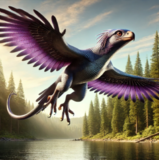 |
Thalassian Eagle | 1.5 meters (4 feet 11 inches) | 5 kilograms (11 pounds) | Inhabits the coastal regions of Thalassiopolos, Arlyon, and Aegirheim, often seen soaring over the high cliffs of Suncliff Fisheries and the Abeisan coastline. | The Thalassian Eagle is a majestic and formidable creature, native to the coastal regions of the Abeisan archipelago.
Thalassian Eagles are primarily found along the coastal regions and cliffs of the Abeisan archipelago, where they rule the skies and hunt for fish. With its powerful wings, sharp talons, and striking plumage, the Thalassian Eagle is a commanding presence along the rocky cliffs and shores. This bird is a master of the skies, effortlessly soaring over the coastal waters. Thalassian Eagles are known for their solitary and territorial nature, often establishing their domains along the rugged coastlines where they hunt for fish. Their incredible diving ability allows them to plunge into the lake's depths to capture prey with remarkable precision. In local culture, the Thalassian Eagle is revered as a symbol of freedom and power over the coastal domains. Encounters with these majestic creatures are considered a sign of protection and a reminder of the boundless beauty of the Abeisan archipelago. |
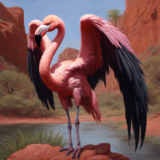 |
Haifa's Flamingo | 1.4 meters (4 feet 7 inches) | 3.5 kilograms (7.7 pounds) | Found along the shores and wetlands of Lake Morovia, near Vaeringheim, Pyralis, and the reed-filled waters around Lunalis Sancta. | Haifa's Flamingo is a graceful and stunning bird, native to the tranquil shores and wetlands of the region surrounding Lake Morovia.
Haifa's Flamingos are primarily found in the tranquil lakesides, reed-filled wetlands, and serene waters of the lake region, where they enhance the natural beauty of the area. With its long, slender legs and elegant neck, Haifa's Flamingo is an embodiment of natural elegance along the serene shores of Lake Morovia. Its vibrant pink feathers stand out against the backdrop of lush reeds and still waters. This bird's distinctive curved beak, shaped for filter-feeding, allows it to glide gracefully across the water's surface. Flamingos are known for their communal and sociable nature, often seen in flocks that perform synchronized dances and feed together in the shallows. Their bright plumage and graceful movements make them a beloved symbol of the region's wetlands. In Haifan culture, Haifa's Flamingos are revered as symbols of unity and the beauty of their region's waters. Encounters with these majestic creatures are considered a sign of tranquility and a reminder of the importance of preserving the delicate balance of the region's wetlands. |
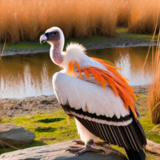 |
Hatch's Gloom Vulture | 1.3 meters (4 feet 3 inches) | 10 kilograms (22 pounds) | Inhabits the dark swamps and marshlands near Lake Morovia, especially around Somniumpolis, Ephyra, and the shadowy wetlands surrounding Lunalis Sancta. | Hatch's Gloom Vulture is a mysterious and enigmatic bird, known for its presence in desolate and shadowy regions of Lake Morovia's vast swamps.
Hatch's Gloom Vultures can be found in dark swamps, where their scavenging abilities are integral to maintaining the balance of the ecosystem. With its dark orange plumage and menacing, piercing gaze, Hatch's Gloom Vulture is a shadowy figure that soars through the region's skies. Its wings are broad and strong, allowing it to navigate effortlessly through the darkest of territories. This vulture's sharp beak and talons are used to scavenge and feed on carrion, and its eerie, human-like calls echo through the swamps. Gloom Vultures are known for their solitary and stealthy nature.. They are expert scavengers, capable of finding sustenance in the harshest of conditions. Despite their eerie reputation, they serve a vital role in the ecosystem, cleaning up and recycling the remains of nature. In local folklore, Hatch's Gloom Vulture is revered as a symbol of adaptation and survival in the darkest corners of the world. Encounters with these shadowy creatures are seen as a sign of resilience and a reminder of the interconnectedness of life and death. |
 |
Uppper Morovian Swamp Ostrich | 1.7 meters (5 feet 7 inches) | 50 kilograms (110 pounds) | Found in the inland swamp regions around Lake Morovia, primarily near Somniumpolis, Lunalis Sancta, and extending slightly into the wooded marshlands near Ephyra. | The Upper Morovian Swamp Ostrich is a remarkable and unique creature, native to the inland regions of Lake Morovia .
With its tall, elegant form and striking plumage, the Upper Morovian Swamp Ostrich is a captivating presence in the swampy terrain. Its long legs are designed for wading through the murky waters, and its beak is specialized for foraging for aquatic plants and small prey beneath the surface. This bird's feathers are equipped with a natural waterproof coating, keeping it dry and buoyant in the swampy environment. Swamp Ostriches are known for their communal and social nature, often forming large flocks that work together to forage for food and protect their territory. They have a unique vocalization that resonates throughout the swamp, enhancing the mystical ambiance of the region. In Morovian culture, the Upper Morovian Swamp Ostrich is revered as a symbol of unity and the preservation of the delicate balance of the swamp. Encounters with these majestic creatures are seen as a sign of cooperation and a reminder of the importance of preserving the unique wetland ecosystems of Lake Morovia. |
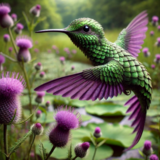 |
Tar's Hummingbird | 0.1 meters (4 inches) | 4 grams | Native to the meadows and lush forests of the Alperkin region, commonly seen near Luminaria, Catonis Atrium, and the surrounding fertile lowlands. | Tar's Hummingbird is a tiny and vibrant creature, native to the colorful meadows and lush forests of the Alperkin region.
With its petite, jewel-like appearance and wings that shimmer with an array of colors, Tar's Hummingbird is a striking presence amidst the lush flora of the Alperkin region. Its rapid, delicate wings allow it to hover in mid-air with unmatched precision, gathering nectar from vibrant blossoms. This hummingbird's melodious and soothing hum enhances the tranquility of the meadows it inhabits. Hummingbirds are known for their sociable and lively nature, often seen flitting from flower to flower and engaging in playful aerial acrobatics. Their presence is a treasured symbol of the region's natural beauty and biodiversity. In Alperkin culture, Tar's Hummingbirds are revered as a symbol of joy and the interconnectedness of life. Encounters with these charming creatures are seen as a sign of happiness and a reminder of the vibrant tapestry of nature in the Tar region. |
 |
Rift Harpy | 1.8 meters (5 feet 11 inches) | 45 kilograms (99 pounds) | Soars through the shadowy skies and dense forests near Lake Morovia, especially around Vaeringheim, Ephyra, and the craggy cliffs of the Abyssal Rift. | The Rift Harpy is a captivating and elusive species of Harpy, distinguished by its unique adaptation to the ethereal environment of the region surrounding Lake Morovia. This creature has famously evolved to feast upon the region's native Wisps, creating a symbiotic relationship with the mysterious parasitic light entities that permeate the region's forests.
Rift Harpies are predominantly found soaring through the shadowy skies of the forests and mountains surrounding Lake Morovia. Their presence is intricately linked to the enigmatic behavior of the native Wisps, which they pursue with a mesmerizing grace and ferocity. Rift Harpies are solitary hunters, patrolling the skies in search of the elusive Wisps that dot the region. Their unique adaptation to feeding on Wisp energy has allowed them to carve a niche in this mystical ecosystem. Legends suggest that the energy extracted from Wisps enhances the psychic abilities of Rift Harpies, making them attuned to the region's supernatural energies. During the breeding season, male Rift Harpies engage in mesmerizing aerial displays to attract potential mates. Females choose partners based on the complexity and grace of these displays. After mating, the female will lay her eggs in hidden nests located within the craggy cliffs of the region's mountains. The Rift Harpy, with its fascinating adaptation to the region's mystical environment, is both a symbol of elegance and an integral part of the local ecosystem. Encounters with this ethereal creature offer a glimpse into the delicate balance between predator and prey in the shadowy skies of Lake Morovia. |
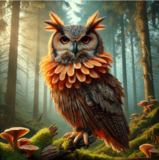 |
Atterian Whiskered Owl | 0.6 meters (1 foot 11 inches) | 1.5 kilograms (3.3 pounds) | Found nestled within the ancient trees of the Morovian woodlands, primarily around Aurelia, Saluria, and the secluded groves near Ephyra. | The Atterian Whiskered Owl is a majestic and enigmatic bird, recognized for its distinctive features and revered as a guardian of the woodlands.
Atterian Whiskered Owls are predominantly found nestled within the ancient trees of the region's forests. They prefer the quietude of dense foliage, where their dark plumage blends seamlessly with the shadows. Nocturnal by nature, Atterian Whiskered Owls are primarily active during the night, patrolling the vast expanses of the vast Morovian woodlands. They play a crucial role in the ecosystem, preying on nocturnal creatures that may disrupt the balance of the forest. The owl's hooting calls resonate through the ancient trees during the mating season. Males engage in elaborate aerial displays to attract potential mates, showcasing their agility and intelligence. After mating, females carefully select nesting sites within tree hollows, where they raise their chicks under the protective canopy. |
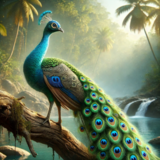 |
Aminian Lowland Peacock | 1.2 meters (3 feet 11 inches) | 5 kilograms (11 pounds) | Common in the wetlands and marshes near Lake Morovia, seen in the swampy lowlands around Somniumpolis, Saluria, and the outskirts of Ephyra. | The Aminian Lowland Peacock is a breathtaking and vibrant bird, renowned for its captivating plumage and graceful demeanor. It possesses not only stunning aesthetics but also a magical presence that enchants those fortunate enough to witness its elaborate displays.
Aminian Lowland Peacocks are native to the region's lush lowlands, where the fertile landscapes provide ample sustenance for these majestic creatures. They prefer habitats with open spaces and vibrant flora, allowing them to showcase their plumage in all its splendor. Aminian Lowland Peacocks are social creatures, often found in small groups that establish territories in the open lowland spaces. During the breeding season, males engage in elaborate displays to attract potential mates. The shimmering plumage, synchronized with graceful dances, creates a spectacle that resonates throughout the lowlands. Females, discerning mates based on the vibrancy of the displays, select partners with whom they form lifelong bonds. After mating, the females carefully construct nests concealed within the lowland vegetation, where they raise their chicks under the watchful eye of the community. |
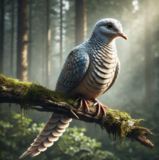 |
Lesser Morovian Swamp Dove | 0.4 meters (1 foot 4 inches) | 1 kilogram (2.2 pounds) | Native to the fragrant meadows and herb-strewn fields of Northern Lake Morovia, often found near Pyralis and the gardens surrounding Somniumpolis. | The Lesser Morovian Swamp Dove is a gentle and resilient creature, celebrated for its adaptability to the swampy wetlands of Lake Morovia. It gracefully soars above murky waters and finds solace in the tranquil, mist-covered landscapes.
These serene doves are native to the wetlands of Lake Morovia, where they effortlessly navigate the maze of water channels and lush vegetation. They build nests in the branches of swamp trees and often gather near the water's edge to feed on aquatic plants and insects. Lesser Morovian Swamp Doves are sociable and often found in small flocks, creating a harmonious presence in the wetland habitat. They forage for aquatic plants, seeds, and small insects, contributing to the ecological balance of the swamp. During the breeding season, males engage in aerial displays, showcasing their agility and vibrant plumage to attract potential mates. Once paired, the doves work together to build nests in the branches, safely away from potential flooding. The Lesser Morovian Swamp Dove is a testament to the resilience and beauty found in the heart of the wetlands. Encountering these gentle doves brings a sense of calm to those who traverse the misty landscapes of Lesser Morovia. |
 |
Odiferian Moa | 1.2 meters (3 feet 11 inches) | 25 kilograms (55 pounds) | Native to the fragrant meadows and herb-strewn fields of Northern Lake Morovia, often found near Pyralis and the gardens surrounding Somniumpolis. | The Odiferian Moa is a delightful and aromatic bird, distinguished by its fragrant plumage and unique ability to emit captivating scents. It roams the flower-strewn meadows of Northern Lake Morovia, spreading its pleasant aroma and fostering a symbiotic relationship with the local flora.
Native to the lush meadows and gardens of Northern Lake Morovia, the Odiferian Moa thrives in environments abundant with blooming flowers and aromatic herbs. It is often found nestled among vibrant flora, where it contributes to the sweet scents that waft through the air. Odiferian Moas are gentle and sociable birds, often seen in small groups within the region's meadows. They play a vital role in pollination, visiting flowers to feed on nectar and spreading pollen as they move. Their scent-marking behaviors contribute to the vibrant and aromatic nature of the region. During the mating season, males engage in intricate courtship displays, showcasing their plumage and releasing enchanting scents to attract potential mates. After forming pairs, they construct nests woven from fragrant herbs and grasses, creating a cozy haven for raising their chicks. The Odiferian Moa is a living testament to the region's beauty. Encounters with this bird are not only visually and aromatically delightful but also contribute to the ecological balance of the region's meadows. |
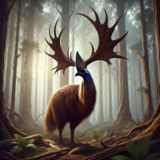 |
Morovian Kingbird | 1.3 meters (4 feet 3 inches) | 18 kilograms (39.7 pounds) | Inhabits the temperate regions surrounding Lake Morovia, particularly around Vaeringheim, Lunalis Sancta, and the open woodlands near Saluria. | The Morovian Kingbird is a majestic and distinctive bird, renowned for its regal presence and the unusual antlers that adorn its crown.
Morovian Kingbirds are often found in the temperate regions of Lake Morovia, where they claim dominion over expansive territories. They prefer areas with open skies, allowing them to display their majestic antlers to the fullest extent. Morovian Kingbirds are known for their dignified and solitary nature. They maintain territories that they defend with elegance and authority, often engaging in graceful aerial displays to establish dominance over neighboring birds. During the breeding season, males flaunt their antlers in intricate courtship dances, showcasing their strength and prowess. Females select mates based on the quality and symmetry of these antlers, and once paired, the duo works together to construct a lofty nest where they raise their chicks. The Morovian Kingbird stands as a symbol of nobility and sovereignty in the region surrounding Lake Morovia. Encountering this regal bird is a rare and awe-inspiring sight, with its antlers serving as a testament to the elegance and authority that define the avian monarchs of the region. |
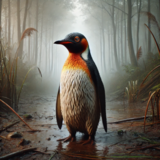 |
Sin's Penguin | 0.8 meters (2 feet 7 inches) | 15 kilograms (33 pounds) | Found in the eerie swamps and murky waters around Lunalis Sancta, Somniumpolis, and the desolate marshes of the Morovian lowlands. | Sin's Penguin is a mysterious and haunting creature, recognized for its chilling presence and the unnervingly human-like calls that echo across swampy landscapes.
Sin's Penguins are often found in desolate swampy environments, where they hauntingly call out in a manner that sends shivers down the spines of those who hear them. These chilling sounds have led to legends and tales about the ominous nature of Sin's Penguins. Sin's Penguins are nocturnal creatures, venturing out under the cover of the night to hunt and communicate. Their haunting calls are an integral part of their social structure, used for everything from marking territory to expressing emotions. While they are generally solitary hunters, Sin's Penguins occasionally gather in small groups during the breeding season, creating a symphony of eerie echoes. Legends suggest that encounters with Sin's Penguins near swamps or caves bring an air of foreboding, and locals often associate their calls with mysterious happenings and supernatural occurrences. Sin's Penguin is a creature of mystery that adds an eerie charm to the landscapes it inhabits. Encounters with this bird are tinged with an otherworldly atmosphere, leaving those who witness its haunting calls with a sense of both wonder and trepidation. |
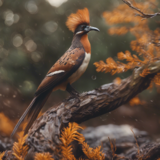 |
Salin Mimic | 0.6 meters (1 foot 11 inches) | 2 kilograms (4.4 pounds) | Found in the lush forests and urban areas near Saluria, Ephyra, and Vaeringheim, as well as in the gardens and wooded areas surrounding Lunalis Sancta. Its adaptability allows it to thrive in a variety of environments, including rural and urban settings. | The Salin Mimic is a masterful bird, distinguished by its vibrant red head plumage and its extraordinary ability to mimic sounds with unparalleled accuracy.
Salin Mimics are found in a variety of habitats, from lush forests to urban areas, where their mimicry skills thrive in diverse soundscapes. Their bright red head plumage makes them easily recognizable as they perch on branches or rooftops, awaiting the next sound to imitate. The Salin Mimics are highly social and communicative birds, using their mimicry abilities not only for survival but also as a form of social bonding. In the wild, they engage in mimicking contests, taking turns to reproduce intricate sounds to showcase their skills. During the breeding season, males use their mimicry talents to create elaborate courtship songs, serenading potential mates with a cacophony of imitated sounds. Once a pair is formed, they construct nests in concealed locations, where the female lays eggs and both parents take turns incubating them. The Salin Mimic is a captivating and versatile bird that adds an enchanting quality to the diverse landscapes it inhabits. Encounters with this bird are not only a treat for the ears but also a testament to the beauty of the natural world's auditory diversity. |
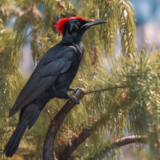 |
Red-Crested Imperial Woodpecker | 0.9 meters (2 feet 11 inches) | 8 kilograms (17.6 pounds) | Inhabits dense forests and ancient woodlands near Saluria, Catonis Atrium, and the tree-covered hills of the Plains of Vaeringheim. | The Red-Crested Imperial Woodpecker is a remarkable woodpecker, celebrated for its ebony plumage and the striking red or orange crest that adorns its head.
These majestic woodpeckers are predominantly found in dense, ancient forests, where towering trees provide an abundance of insects and a resonant backdrop for their rhythmic percussion. The Red-Crested Imperial Woodpecker is often spotted in regions with well-established canopies, offering both sustenance and the perfect environment for its impressive displays. Red-Crested Imperial Woodpeckers are known for their regal and solitary nature. Males showcase their prowess by drumming on tree trunks, creating rhythmic patterns that echo through the forest. The intensity and complexity of these beats communicate the woodpecker's health, strength, and availability for mating. During courtship, females observe these displays and choose mates based on the resonance and vibrancy of the drumming. Once pairs are formed, the woodpeckers construct nests high in the trees, where they raise their chicks amidst the protective embrace of the forest canopy. Encountering this bird is a rare and awe-inspiring experience, as its rhythmic drumming and vibrant plumage add a touch of grandeur to the heart of the forest. |
 |
Vaeringheim's Turkey | 1.2 meters (3 feet 11 inches) | 25 kilograms (55 pounds) | Common in the diverse landscapes around Lake Morovia, frequently seen in the lush forests and open meadows of Vaeringheim, Ephyra, and Pyrals. | Vaeringheim's Turkey is a captivating creature, bearing a striking resemblance to a turkey with distinct dragon-like features.
These remarkable turkeys are commonly found in the lush and diverse landscapes of Lake Morovia, where their reptilian traits allow them to thrive in various environments, from dense forests to open meadows. They are often spotted foraging for fruits, insects, and small reptiles and amphibians. Vaeringheim's Turkeys are social and often form loose flocks that roam the landscapes in search of food. Their reptilian features and serpentine movements make them a captivating sight, especially during the breeding season when males engage in Draconic Gobble contests to attract mates. Females select mates based on the resonance and complexity of the Draconic Gobbles, and once paired, the duo constructs nests in secluded locations. The nests, often hidden in foliage or rocky crevices, provide a secure environment for raising chicks. Vaeringheim's Turkey, with its unique blend of reptilian and avian characteristics, is a symbol of the diverse and mystical nature of Lake Morovia. Encounters with this bird offer a glimpse into the rich biodiversity of the region, showcasing the harmonious coexistence of familiar and mythical traits in a single, captivating creature. |
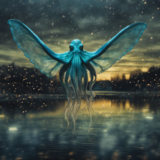 |
Wisp Queen | 3 meters (9 feet 10 inches) | 150 kilograms (330 pounds) | Dwells in the dark swamps and murky waters of Lake Morovia, with sightings reported near Somniumpolis, Ephyra, and the cursed wetlands of Vaeringheim. | The Wisp Queen is an ethereal creature, renowned for its bio-luminescent displays in the murky swamps of Lake Morovia. This squid, with its ghostly aura, commands the waters as it hunts by dragging its tentacles through the swamp, leaving a trail of mesmerizing lights in its wake.
Wisp Queens are predominantly found in the dark and murky swamps surrounding Lake Morovia, where the bio-luminescent glow of their tentacles illuminates the waters. These creatures thrive in the depths of the region's darkest swamps. These creatures derive their name from the fact that they are often accompanied by swarms of parasitic wisps. Wisp Queens are solitary and unusual creatures, rarely seen by humans due to their preference for the dark and secluded depths of the swamp. They are apex predators of their domain, using their bio-luminescent displays and hypnotic lures to hunt and capture unsuspecting prey. Despite their eerie appearance, Wisp Queens are integral to the balance of the swamp ecosystem, controlling populations of smaller creatures and maintaining the delicate balance of life in the murky waters. Legends speak of their role as guardians of the swamp. |
 |
Ferrum Mosquito | 1.2 meters (4 feet) | 15 kilograms (33 pounds) | Found in the arid wastelands surrounding Ferrum Citadel, especially in the cool shadows of the region’s vast cliffs and rocky outcrops. | The Ferrum Mosquito is a colossal and fearsome insect, native to the arid wastelands surrounding Ferrum Citadel. This gigantic mosquito species thrives in the cool shadows cast by the vast cliffs that dominate the cursed region. Unlike typical mosquitoes, the Ferrum Mosquito has evolved to feed not on blood but on the brains of its prey, using its large, powerful proboscis to penetrate skulls with terrifying efficiency.
Ferrum Mosquitoes inhabit the desolate and shadowy regions around Ferrum Citadel. They seek refuge in the cool, dark crevices of the towering cliffs, which provide shelter from the harsh sunlight and extreme temperatures of the wastelands. The cursed nature of the region has led to the adaptation of these mosquitoes, making them one of the most dangerous predators in the area. Ferrum Mosquitoes are solitary hunters, emerging from their cliffside refuges during twilight and night to hunt for prey. They rely on their keen senses to locate potential victims, drawn to the faint electrical signals emitted by brain activity. Once a target is identified, they move with silent efficiency, remaining virtually undetected until they are upon their prey. When ready to strike, the Ferrum Mosquito plunges its strong proboscis into the skull of its prey in order to feed on brain matter. This gruesome feeding method ensures a quick and fatal end for most victims, leaving little chance for escape. Recognizing the extreme risk which the Ferum Mosquito poses to humans, the government of Ferrum Citadel famously fumigates the city's streets on a daily basis, in order to kill any mosquito or mosquito larvae which may have made their way into the city. |
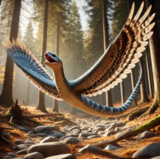 |
Banded Flight Viper | 1.5 meters (5 feet) | 20 kilograms (44 pounds) | Inhabits rocky cliffs and dense forests near Lake Morovia, particularly around Saluria, Ephyra, and the rugged terrain of the Abyssal Rift. | The Banded Flight Viper is a striking and formidable reptile, known for its unique adaptation of flight. This species of flying viper is distinguished by its vivid banded pattern and its impressive 3 meter wingspan, which allows it to soar gracefully through the air. Native to the rocky cliffs and dense forests of Lake Morovia, the Banded Flight Viper is a predator that combines the stealth and lethality of a viper with the agility and freedom of flight.
Banded Flight Vipers inhabit rocky cliff sides, dense forests, and arid regions where they can easily blend into their surroundings. Their nests are often found high in trees or on inaccessible rock ledges, providing safety from ground-based threats and a vantage point for spotting prey. These areas offer ample hunting opportunities and protection from larger predators. Banded Flight Vipers are solitary hunters, relying on their keen senses and flight capabilities to locate and capture prey. They are primarily nocturnal, using the cover of darkness to hunt while avoiding the heat of the day. During the night, they use their infrared vision to detect warm-blooded prey, striking from the air with lethal accuracy. These vipers are highly territorial and will aggressively defend their hunting grounds from intruders, including other Banded Flight Vipers. Their rattle is used not only as a hunting tool but also as a warning signal to deter rivals and threats. |
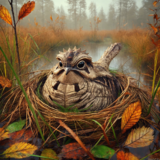 |
Salurian Swamp Quail | .15 meters (.5 feet) | 1 kilogram (2.2 pounds) | Common in the swamps and marshlands near Saluria, thriving in the dense vegetation and wetland areas around Lake Morovia. | The Salurian Swamp Quail is an intriguing bird that exhibits a blend of quail-like and subtle reptilian features. It is known for its mottled brown and gray plumage, and large expressive, dark eyes. This small creature is adept at navigating the dense underbrush of swampy environments, making it a master of camouflage and survival.
Found predominantly in the swamps and marshlands around Saluria, these quails thrive in moist, densely vegetated areas where they can easily hide and forage. The thick foliage and fallen leaves provide excellent cover, aiding their survival in these wetland ecosystems. Salurian Swamp Quails are mostly solitary and highly territorial, only coming together during mating season. They communicate using a series of soft chirps and whistles, and during mating season, males perform elaborate displays using both their sounds and vibrant plumage to attract mates. They, furthermore, exhibit a remarkable and unique behavioral trait known as "mirroring mist." When threatened or during courtship displays, these quails can release a fine, mist-like secretion from specialized glands located beneath their wings. This mist contains pheromones and reflective particles that visually amplify and distort the quail's image, creating multiple, illusory copies of itself in the immediate vicinity. This mirroring mist serves multiple purposes, including defense, courtship, and territorial displays. When predators approach, the mist confuses them by presenting several false targets, allowing the real quail to escape unnoticed. During mating season, males enhance their display by creating a dazzling spectacle of multiple mirrored images, which makes them appear more formidable and attractive to potential mates. With respect to territorial displays, the quails use the mist to mark their territory during mating season, leaving behind a faint, lingering scent that deters rivals and signals to females the boundaries of their claimed area. |
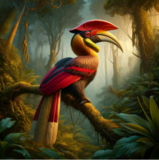 |
Vaeringheim Ruby Hornbill | 1 meter (3 feet 3 inches) | 4 kilograms (8.8 pounds) | Vaeringheim, Skýrophos, Pyralis, and the woodlands near Ephyra | The Bassaridian Hornbill is a striking bird, celebrated for its vivid plumage and distinctive red casque atop its large, curved beak. Its feathers display a rich palette, with crimson wings, a golden-yellow breast, and black accents, complemented by pale cream highlights on its tail. The hornbill’s beak, a blend of green and ivory, adds to its colorful and imposing presence. Known for its majestic appearance, the Bassaridian Hornbill is often seen as a symbol of the untamed beauty and mystique of the forests and woodlands.
The Bassaridian Hornbill is typically found in mated pairs or small family groups. Known for its strong pair bonds, mated hornbills engage in synchronized calling and mutual preening to reinforce their connection. During nesting season, the female seals herself inside a tree hollow, relying on the male to bring food through a narrow opening. Active during early morning and late afternoon, the hornbill spends its days searching for food high in the canopy and returns to roost in secure, elevated spots at night. One of the most sacred behaviors of the Bassaridian Hornbill is Ra’kava Solrûth, or "Echo of the Sun’s Journey." At dawn and dusk, the hornbill perches on a high branch overlooking its territory and emits a series of resonant calls that rise in pitch with the movement of the sun. These calls reverberate through the surrounding forests, marking the transition between night and day. Ra’kava Solrûth is seen as a tribute to the sun’s path, a ritual that honors the cycles of nature and brings a blessing of harmony to the forest. Locals believe that the hornbill’s call connects the woodlands around Vaeringheim, Skýrophos, Pyralis, and Ephyra, weaving a spiritual thread through these regions. In Bassaridian culture, listening to Ra’kava Solrûth at dawn or dusk is a revered tradition. Villagers often gather quietly at the edge of the forest or within small clearings to hear the hornbill’s song, reflecting on the harmony between light and darkness. The Ra’kava Solrûth is believed to carry the wisdom of the natural world, with each call symbolizing resilience, clarity, and balance. |
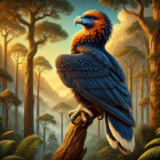 |
Delphic Roc-Eagle | 2 meters (6 feet 7 inches) | 15 kilograms (33 pounds) | High mountain ranges near Delphica, Luminaria, and the cliffs of Catonis Atrium | The Delphic Roc-Eagle is a formidable bird of prey, characterized by its impressive size and vibrant plumage. Its feathers transition from deep, midnight blue on its wings and tail to fiery orange around its head and neck, creating a striking contrast that enhances its regal appearance. The Roc-Eagle’s eyes are a piercing golden hue, highly adapted for spotting prey from great heights. Its powerful talons are capable of gripping and carrying sizable animals, and its strong, hooked beak is perfectly suited for tearing through flesh. This magnificent creature’s presence commands respect, embodying both the beauty and danger of the high forests.
A solitary hunter, the Delphic Roc-Eagle is known for its sharp intelligence and exceptional hunting skills. It soars high above the forest canopy, circling silently until it spots prey below. With breathtaking speed and precision, it dives to capture its target, often carrying it back to a high perch to feed. The Roc-Eagle is fiercely territorial, defending its nesting grounds from other predators and birds of prey. Mated pairs form lifelong bonds, constructing massive nests on inaccessible cliffsides, where they return year after year to raise their young. Known for its piercing call that echoes across the mountain forests, the Roc-Eagle is most active at dawn and dusk. One of the Delphic Roc-Eagle’s most mystical behaviors is its practice of Sûl'kanai Vráka, or "Skyward Vigil." During the change of seasons, particularly at the onset of spring and autumn, the Roc-Eagle finds a high perch and remains motionless for hours, gazing skyward as if in silent communion with the heavens. Local lore suggests that this vigil allows the Roc-Eagle to draw strength from the celestial forces, preparing it for the challenges of the coming season. Some believe that the eagle’s gaze can even influence the weather, bringing rain or sunshine depending on the needs of the land. Witnessing a Roc-Eagle in Sûl'kanai Vráka is considered an omen of change, signaling either prosperity or a call for resilience in the months ahead. |
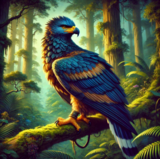 |
Amaryan Gyrfalcon | 0.8 meters (2 feet 7 inches) | 3 kilograms (6.6 pounds) | High plateaus and open skies near Bjornopolis, Aurelia, and the meadows of the Plains of Vaeringheim | The Amaryan Gyrfalcon is a breathtaking bird of prey, known for its striking, iridescent plumage and powerful build. Its feathers are a rich mix of blue and deep gold, with intricate patterning along its wings and back, which shimmer when caught in sunlight. Its chest and underwings are a warm, earthy gold that fades into a deep blue along its wings and tail. The falcon’s intense, yellow-eyed gaze and sharp, hooked beak reflect its prowess as a hunter. With talons designed for precision, the Amaryan Gyrfalcon is a swift and skilled predator, capable of agile maneuvers through dense trees and foliage.
The Amaryan Gyrfalcon is a solitary and highly territorial bird, known to defend its hunting grounds with fierce determination. Preferring high perches in the tallest trees, it has a wide vantage point to scout for prey. When hunting, it employs a swift, silent approach, diving with incredible speed to capture its target. The gyrfalcon forms strong bonds with its mate, with pairs often hunting in tandem during breeding season. These falcons build their nests in high, secluded canopies, where they are hidden from predators and shielded by the thick forest cover. They are most active during dawn and dusk, when the forest is shrouded in mist and the light creates a mystical atmosphere. The Amaryan Gyrfalcon is known for its seasonal ritual, the Érath’rin Sojourn, or "Journey of the Mist." At the beginning of the rainy season, the gyrfalcon embarks on a pilgrimage through the forest, traveling from one sacred grove to another. During these journeys, the gyrfalcon makes several haunting calls that echo through the forest, believed by the people of Amarya to be a form of communication with the forest spirits. This ritualistic flight is thought to renew the bird’s connection to the land, bringing blessings of protection and vitality to the forest. Observing an Amaryan Gyrfalcon in the midst of its Érath’rin Sojourn is considered a powerful omen, symbolizing harmony with nature and resilience through changing seasons. The Amaryan Gyrfalcon is a symbol of vigilance, endurance, and a deep connection to the land. Its image is often used in Amaryan totems, tapestries, and ceremonial garb, embodying the protective spirit of the forest. During annual festivals, villagers mimic the Érath’rin Sojourn by creating intricate dances and songs that celebrate the gyrfalcon’s journey and its bond with the mist-laden woodlands. Amulets and carvings of the gyrfalcon are highly valued, believed to bring strength and insight to those who carry them. Witnessing the Érath’rin Sojourn is seen as a blessing, and villagers who hear the falcon’s call during its journey take it as a sign of renewal, unity, and the wisdom of nature. |
 |
Ztaalin Serpent Vulture | 1.3 meters (4 feet 3 inches) | 8 kilograms (17.6 pounds) | Rocky crags and canyonlands near Skaroth, Qandros, and the desert ridges of Acheron | The Ztaalin Serpent Vulture is an imposing bird, renowned for its broad, powerful wings and sleek, serpentine neck that allows it to scan its environment with a sharp, watchful gaze. Its plumage is a mix of dark brown and charcoal grey, providing effective camouflage against the shadows of the forest. Its beak is long and hooked, designed for tearing through tough hides and flesh. The Serpent Vulture’s piercing yellow eyes give it a hauntingly intelligent look, while its wings, lined with lighter feathers along the edges, create an impressive display when fully spread. This vulture is known for its unique perching stance, where it holds its wings slightly extended, as if constantly ready to take flight.
The Ztaalin Serpent Vulture is a solitary bird that prefers the isolation of deep forests and remote woodlands. It is often seen perched high in the canopy, where it scans the forest floor for signs of carrion or weakened animals. Known for its patience, the Serpent Vulture can go days without feeding, relying on its keen senses to detect opportunities. While primarily a scavenger, it occasionally hunts smaller animals or reptiles when food is scarce. This vulture has a notable behavior of “claiming” certain areas, returning to the same perches and territories year after year. The bird is highly territorial, and displays its wings in a dramatic, menacing posture when intruders encroach on its chosen grounds. The Ztaalin Serpent Vulture performs a ritual known as the Nárkesh Rite, or "Spirit's Vigil." During this ritual, the vulture selects a prominent perch near a carcass or remains and stands watch over it for hours, sometimes overnight, without feeding. During the Nárkesh Rite, the Serpent Vulture emits low, rhythmic calls that seem to resonate through the forest, creating an eerie soundscape. Locals believe that the Nárkesh Rite is a form of spiritual reverence, with the vulture acting as a guardian that guides the departed soul into the afterlife. It is considered a sacred ritual, and the Ztaalin people avoid disturbing the vulture when it is in the midst of this vigil, viewing it as a bridge between life and death. The Ztaalin Serpent Vulture is deeply revered in the culture of the Ztaalin region, where it is seen as a sacred messenger and a guardian of the departed. It often appears in Ztaalin art and totems, symbolizing wisdom, transition, and respect for the cycle of life and death. During funeral ceremonies, families create small effigies of the Serpent Vulture as offerings, hoping to invoke its guidance for their loved ones’ souls. Villagers who hear the vulture’s call during the Nárkesh Rite are said to receive a blessing, believed to bring clarity and peace. The Serpent Vulture’s role as a silent observer and its hauntingly beautiful calls during the Nárkesh Rite have made it an enduring symbol of the unseen mysteries of the forest, respected as both a scavenger and a spiritual guide. |
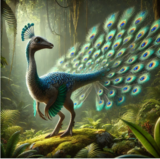 |
Tarsican Imperial Peafowl | 1.2 meters (3 feet 11 inches) | 5 kilograms (11 pounds) | Sacred gardens and temple grounds near Iylara, and Kalithros | The Tarsican Imperial Peafowl is a breathtaking bird, renowned for its radiant plumage and stately demeanor. Its body is adorned with shades of iridescent blue and teal that shimmer in dappled sunlight, giving it a striking, almost mystical presence among the trees. The bird’s long, graceful neck and slender legs contribute to its elegant appearance. Its crowning feature, however, is its grand tail fan, composed of hundreds of eye-patterned feathers in hues of blue, green, and gold, creating an awe-inspiring display when fully fanned out. A small crest of blue feathers graces its head, adding to its regal aura.
The Tarsican Imperial Peafowl is a social bird that lives in small flocks, usually led by a dominant male. During courtship, the male performs a mesmerizing display, fanning its vibrant tail feathers and moving in slow, deliberate steps to attract mates. This spectacle is accompanied by distinctive calls that echo through the forest, attracting both mates and the admiration of onlookers. Outside of mating season, the Imperial Peafowl is a quiet forager, moving in groups along riverbanks and forest clearings in search of food. At night, it roosts in high branches, away from predators, and descends at dawn to continue its graceful wanderings. The Tarsican Imperial Peafowl participates in a seasonal display known as La’rasa Unviel, or "Unveiling of the Spirits." At the start of the rainy season, male peafowls gather in secluded forest clearings and fan their tails in unison, emitting a soft, rhythmic call. As mist rises from the damp forest floor, the peafowls’ feathers glisten in the morning light, creating an enchanting spectacle. Local lore holds that La’rasa Unviel is a tribute to the spirits of the forest, with the peafowls serving as messengers between the natural and spiritual realms. Witnessing this ritual is considered a sacred experience, symbolizing beauty, harmony, and the forest’s protective essence. The Imperial Peafowl is revered as a symbol of elegance, beauty, and the mystical connection between the forest and the spiritual world. Its image is frequently featured in ceremonial art, clothing, and jewelry, representing the life and vibrancy of the natural world. During annual festivals, the people recreate La’rasa Unviel through dance and song, celebrating the beauty of their homeland and the blessings of the forest spirits. Feathers from the Imperial Peafowl are highly prized, used sparingly in sacred rites for their believed protective and harmonizing energies. To witness the La’rasa Unviel is seen as a rare honor, a reminder of the balance between the natural and spiritual realms, and a celebration of the forest’s eternal guardianship. |
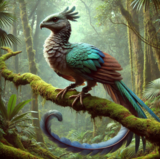 |
Lothayan Moon Quetzal | 0.9 meters (2 feet 11 inches) | 2 kilograms (4.4 pounds) | Dense jungles and secluded groves near Lothaya, Myrgon, and the forested regions around Seraphon | The Lothayan Moon Quetzal is a captivating bird known for its mystical appearance and unique feather patterns. Its plumage is a blend of silver, teal, and deep blue, with iridescent feathers that catch the moonlight, creating an ethereal glow. The bird’s body is elegantly streamlined, with its crest feathers forming a delicate crown, and a long, gracefully curling tail that shimmers with each movement. Its wings feature teal and jade-green feathers tipped with midnight blue, creating a striking contrast against its silvery neck and chest. The Moon Quetzal’s large, dark eyes reflect the starlight, giving it a wise, almost otherworldly gaze.
The Lothayan Moon Quetzal is a solitary and elusive creature, often found in the quietest parts of the forest, where it perches high in the canopy. Known for its nocturnal habits, the Moon Quetzal is most active during twilight and moonlit nights, gliding silently through the trees. It is a patient hunter, waiting motionlessly on branches before swooping down to catch insects or small reptiles. During the day, it roosts in concealed spots, camouflaged among the mossy branches and dappled light. The Moon Quetzal is also known for its haunting call—a soft, echoing song that carries through the forest at dusk, thought to be a tribute to the spirits of the night. The Lothayan Moon Quetzal performs a mystical ritual known as the Celest’Vara Serenade, or "Song of the Celestial Spirits." On nights of the full moon, the quetzal takes a high perch and sings a series of long, haunting notes that resonate through the forest. This ritual, believed to honor the moon and stars, creates an enchanting atmosphere as the bird’s feathers reflect the moonlight, giving it an almost spectral glow. Locals believe that the Celest’Vara Serenade serves as a bridge between the earthly realm and the celestial spirits, with the quetzal acting as a messenger of the night. Witnessing this serenade is considered a rare blessing, symbolizing protection and guidance from the forest’s ancient spirits. The Moon Quetzal is revered as a symbol of wisdom, beauty, and connection to the spiritual realm. Its image is frequently depicted in traditional art, jewelry, and ceremonial attire, embodying the mysteries of the night and the protective energy of the forest. During moonlit festivals, villagers recreate the Celest’Vara Serenade through music and dance, celebrating the bird’s role as a guardian of the night and honoring the spirits of the land. The feathers of the Moon Quetzal are considered sacred and are used sparingly in rituals, believed to grant insight and protection. Witnessing the Celest’Vara Serenade is seen as an invitation to reflect on the wonders of the natural world and one’s place within it, with the Moon Quetzal guiding the way through the mysteries of the forest under the light of the moon. |
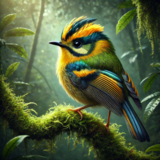 |
Seraphic Crimson Crested Cockatoo | 0.7 meters (2 feet 4 inches) | 1.5 kilograms (3.3 pounds) | Coastal scrublands and mangrove forests near Seraphon, Aegirheim, and Suncliff Fisheries | The Seraphic Crimson-Crested Cockatoo is a vibrant, small cockatoo known for its exquisite plumage and distinctive crimson crest, which gives it a seraphic, angelic appearance in the dense rainforest. Its body is covered in a blend of bright emerald green and golden-yellow feathers, with streaks of deep azure blue along its wings and tail. The cockatoo’s crown features a striking crest of crimson feathers that it raises when excited or in display, creating a halo effect against its colorful plumage. Its large, dark eyes radiate intelligence and curiosity, while its compact, slightly curved beak is perfectly adapted for cracking open seeds and peeling fruit.
The Seraphic Crimson-Crested Cockatoo is a social and lively bird, often seen in small flocks fluttering through the forest canopy. Known for its playful nature, this cockatoo engages in elaborate aerial displays and loud, melodic calls that resonate through the trees. The cockatoo’s crest is often raised during social interactions, making it a prominent visual signal for communication. Outside of mating displays, it spends much of its day foraging, hopping from branch to branch in search of fruits, seeds, and berries. This cockatoo is especially vocal during dawn and dusk, filling the forest with its distinctive calls as the day begins and ends. One of the most enchanting behaviors of the Seraphic Crimson-Crested Cockatoo is its ritual known as Aurelia’s Dawn Dance. At first light, flocks gather in a chosen clearing or treetop and engage in a synchronized display, with each bird raising its crimson crest and performing a series of rhythmic hops, spins, and wing flutters. The birds’ colorful plumage and vibrant crests create a spectacular sight as they catch the dawn’s first rays. Local legends hold that the Aurelia’s Dawn Dance is a celebration of the sun’s return, and the cockatoos are believed to summon blessings of light and vitality for the forest. Observing this dance is considered a joyful omen, symbolizing energy, harmony, and new beginnings. The Seraphic Crimson-Crested Cockatoo is cherished in local cultures as a symbol of joy, renewal, and celebration. Its image appears in ceremonial art, clothing, and decorative items, representing the vibrancy of life and the beauty of the natural world. During annual festivals, villagers replicate Aurelia’s Dawn Dance through colorful attire and lively dances, honoring the cockatoo’s role as a herald of dawn and new beginnings. The cockatoo’s feathers are considered precious, used sparingly in festive decorations or ceremonial wear, believed to bring vitality and good fortune. To witness the Aurelia’s Dawn Dance in the forest is a blessing, reminding locals of the interconnectedness of all life and the endless cycle of dawn and dusk. |
 |
Thalassan Storm Petrel | 0.3 meters (1 foot) | 0.4 kilograms (0.9 pounds) | Open waters and coastal cliffs near Thalassa, Arlyon, and the coastal outcrops of Aegirheim | The Thalassan Storm Petrel is a powerful bird of prey, known for its rugged appearance and adaptability to harsh coastal climates. Its feathers range from slate blue to stormy gray, providing natural camouflage against the rocky shorelines and waves. The chest and neck feature hints of russet and copper, creating a subtle contrast to its otherwise dark coloring. The bird’s sharp, hooked beak and intense amber eyes give it a fierce look, while its long, broad wings allow it to glide effortlessly over coastal waters, even during turbulent weather. With its muscular frame and strong talons, the Storm Petrel is well-equipped to handle the coastal elements and hunt in challenging conditions.
The Thalassan Storm Petrel is a solitary, territorial bird, often seen perched on high coastal rocks, scanning the Strait for potential prey. Its hunting style involves diving toward the sea with incredible speed and precision, catching fish and small marine animals near the surface. Known for its resilience, the Storm Petrel can soar and hunt even during stormy weather, and locals often view it as a symbol of endurance and strength. The bird is monogamous, forming strong pair bonds during breeding season and constructing nests on remote cliff ledges. Its low, resonant calls echo along the coastline, a haunting sound that has come to signify the raw power of the sea. The Thalassan Storm Petrel is famed for its ritual known as the Aria of the Tides. During the highest tides of the month, often under a full moon, the Storm Petrel performs an extraordinary display over the Strait of Haifa. It takes flight at dusk, soaring above the waves in graceful arcs and circles, vocalizing a deep, melodic call that seems to harmonize with the sound of the waves. The bird’s movements mirror the ebb and flow of the tide, as if it’s conducting a symphony with the sea. The Aria of the Tides is thought to be a tribute to the sea itself, with the petrel acting as both performer and guardian of the coast. In Thalassan culture, the Storm Petrel is revered as a coastal protector and a symbol of resilience and harmony with nature. Its image is often carved into amulets, jewelry, and coastal monuments, representing the bond between the people and the sea. During high tide festivals, villagers gather on the cliffs to replicate the Aria of the Tides, with music and chants designed to echo the bird’s movements and calls, seeking the sea’s blessings for calm waters and abundant fishing. The feathers of the Storm Petrel are considered sacred and are used in ceremonial clothing and offerings. Witnessing the Aria of the Tides is seen as a rare and powerful experience, reminding locals of their deep connection to the Strait and the protective presence of the Storm Petrel along the coast. |
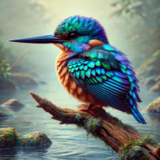 |
Opal Kingfisher | 0.4 meters (1 foot 4 inches) | 0.5 kilograms (1.1 pounds) | Freshwater rivers and lakes near Saluria, Ephyra, and the lowland marshes of Pyralis | The Opal Kingfisher is a stunning bird, known for its iridescent plumage that shimmers with hues of deep blues, purples, turquoise, and greens. In low light, its feathers seem to glow, shifting colors as it moves. Its chest is a warm orange, which contrasts beautifully with the cooler tones of its wings and back. The kingfisher’s sharp, slender beak is adapted perfectly for fishing, and its large, dark eyes convey an alert, watchful presence. The Opal Kingfisher’s small size and vibrant colors make it a cherished sight for those who encounter it by the water’s edge.
The Opal Kingfisher is a solitary bird, often seen perching quietly on branches or rocks above the water, where it waits patiently for fish or insects to come within striking range. When it spots prey, the kingfisher dives with incredible speed and precision, capturing its target in one swift motion. Known for its agility, the bird can maneuver effortlessly through dense foliage, darting between perches along the water. It tends to be most active during dawn and dusk, when it fills the air with soft, melodious chirps, marking its presence in the peaceful forest. The Opal Kingfisher is also highly territorial, fiercely guarding its favorite fishing spots. The Opal Kingfisher is famous for its mesmerizing Lumina Dive. At dawn or twilight, the kingfisher performs a dive that captures and reflects the dim, ambient light, creating a trail of iridescent colors in its wake. This effect resembles a streak of light moving toward the water, like a comet or shooting star. Locals believe that witnessing the Lumina Dive is a sign of good fortune and clarity, symbolizing harmony with nature. The kingfisher’s dive is thought to honor the spirits of the water, embodying beauty and grace in a single motion. In local culture, the Opal Kingfisher is seen as a symbol of peace, clarity, and natural beauty. Its image frequently appears in art, jewelry, and ceremonial items, representing the delicate balance between light and water. During seasonal celebrations, villagers gather by rivers at dawn to honor the kingfisher with songs and offerings of smooth river stones, seeking blessings of insight and tranquility. The feathers of the Opal Kingfisher are considered sacred and are believed to carry protective energies. Observing the Lumina Dive is viewed as a rare and meaningful experience, serving as a reminder of the elegance and harmony within the natural world. |
Ephemeral Fauna
Northern Strait of Haifa
The Northern Strait of Haifa lies to the north of Lake Morovia, and connects it to northern Keltia's Guardian Bay. A vast and mystical region rich in game and resources, the Northern Strait of Haifa is almost entirely devoid of human settlement - there are no major cities anywhere along the 1600+ kilometers of waterways which separate the Port of Vaeringheim from the city-state of Jangsong. Indeed, even the boldest of pirates who make their living in the Southern Strait or in Lake Morovia is generally unwilling to traverse the Northern Strait of Haifa, lest they encounter any number of the region's relentless ghosts, or fierce harpies or sasquatch. It was only in the late 1710's that naval forces felt strong enough to traverse these treacherous trade routes and escort the boldest merchants in their respective countries.
Ghosts of the Northern Strait
The Ghosts of the Northern Strait are an aggressive species of parasitic Will o' Wisp, which live by feeding on the life-force of mammals. The prevalence of these extremely dangerous creatures has long prevented humans from journeying through, or from settling in, the Northern Strait of Haifa. With that said, those who do make the journey through the Northern Strait have long relied on the powers of the Couriers of the Lizard Queen, whose magical abilities can be used to treat the maddening effects of the region's parasitic spirits. Among those who have famously relied on the services of the Couriers of the Lizard Queen to combat the effects of the Ghosts of the Northern Strait is Captain Ismael Hatch, whose crew suffered an onslaught of ghosts during its voyages to and from the city of Jangsong. Following the example of Captain Hatch, many of the arctic pirates who sail under the flag of the Hatch Ministry are known to take special care in fostering close relationships between themselves and the Couriers of the Lizard Queen
Harpies
Regarded by the pirates who sail under the banner of the Hatch Ministry as being the servants of the goddess Aganippe, the Harpies of the far north are revered for their semi-mythical ability to ward off the Ghosts of the Far North. Travelers passing through the strait, for this reason, often rely on the presence of harpies for protection against the region's deadly, parasitic spirits. With that said, such practices are not actually encouraged, insofar as harpies are known to viciously prey upon any unfortunate human who carelessly manages to obtain their notice.
Gulf of Jangsong
The primary domain of the Hatch Ministry, a well-financed and savage community of Normarkian and Haifan pirates which formed following the series of raids in the region carried out by Captain Ismael Hatch in the 35.60's PSSC, The Gulf of Jangsong is the body of water which defines the northern mouth of the Strait of Haifa. It is bordered by the Bassarid states of Jangsong and the Bassarid Kingdom of New Normark, and by the formerly Natopian demesne of Elijah's Rest, which is now a part of the Elwynnese autonomous republic of Normark.
Strait of Haifa Campaign
The Gulf of the Jangsong was the site of the Strait of Haifa Campaign, an informal, undeclared military conflict between the Haifo-Pallisican Imperial Trade Union and Natopia, which occurred in the final stage of the War of Lost Brothers. Despite its relatively limited scope in contrast to the war's other conflicts, the Strait of Haifa Campaign is perhaps the most infamous of the campaigns to have occurred during the war. This fact is due to the asymmetrical nature of the campaign, which featured the extensive employment of guerrilla-style tactics by forces supported by the Bassarid Empire, including espionage, piracy, and outright terrorism. This campaign resulted in a stalemate defined by the continued existence of the Bassarid Kingdom of New Normark.
The Crookening
The Crookening is an unusual type of fog that occurs in the region surrounding the Gulf of Jangsong, which causes objects when viewed at a distance to appear crooked or lop-sided. It has been observed, although not scientifically confirmed, that the Crookening tends to take in the periods before and after the occurrence of the aurora borealis.
Controversy
The presence of the Strait of Haifa on the official map of the MCS has long been a contentious issue amongst the organization's members, as many have historically argued that the waterway is unrealistic or poorly defined. This argument was largely resolved by a 2015 poll in which the majority of respondents voted in favor of recognizing the waterway as a "narrow sea."
On 21 December 2017, the name of the Strait of Haifa was voted onto the MCS's physical map by 75% of Micras' nations.
